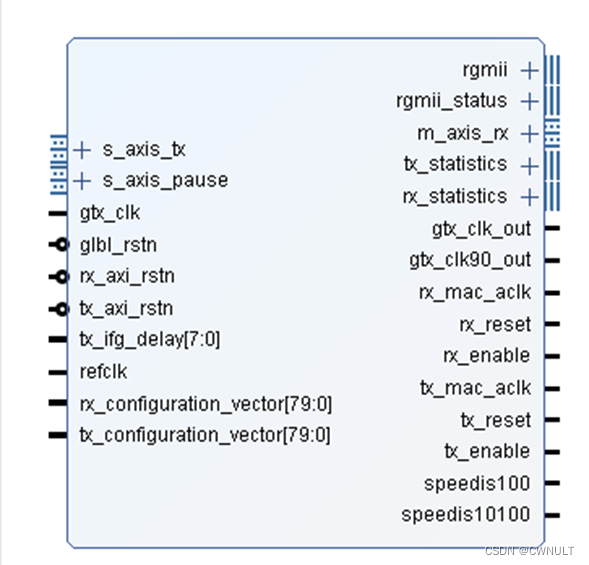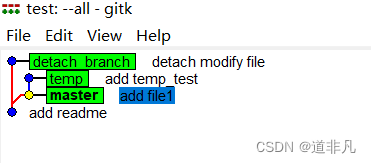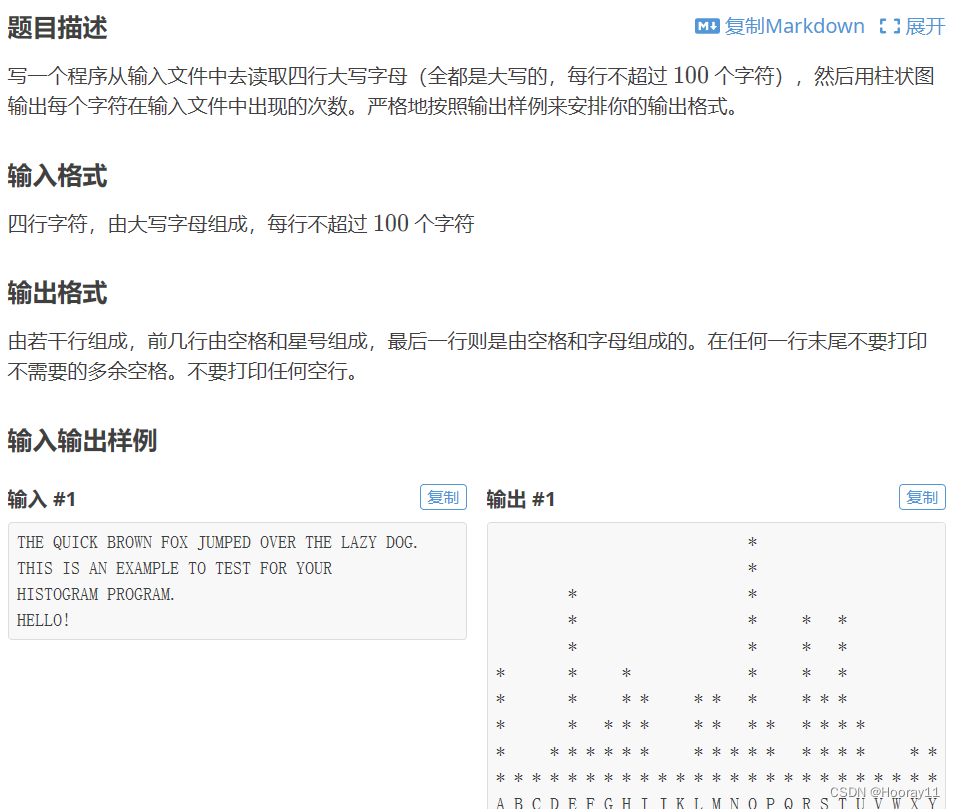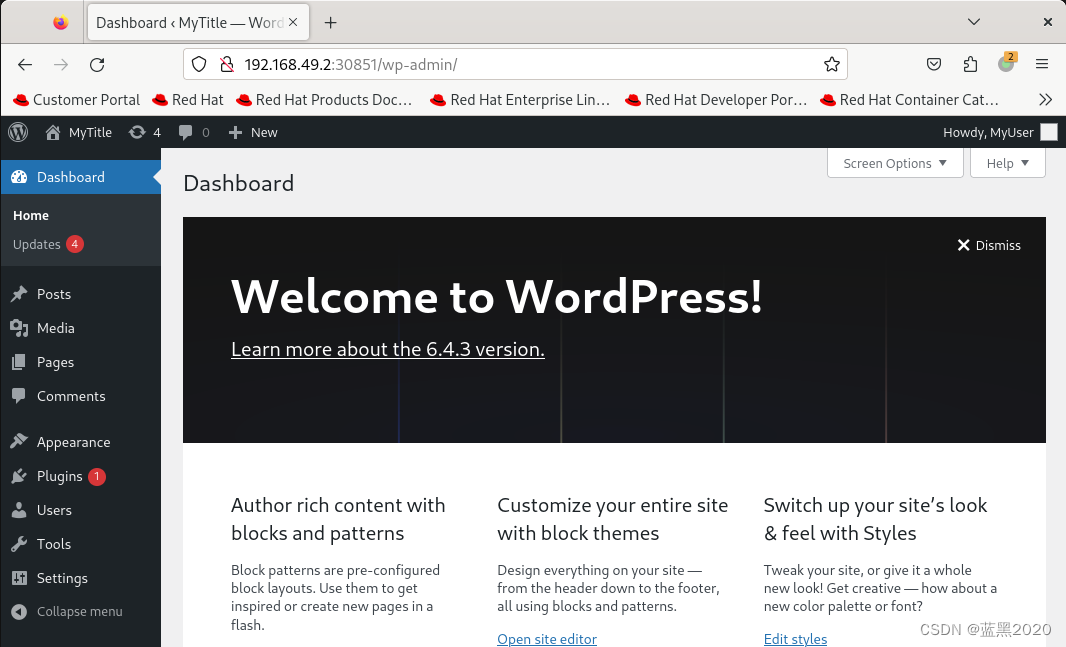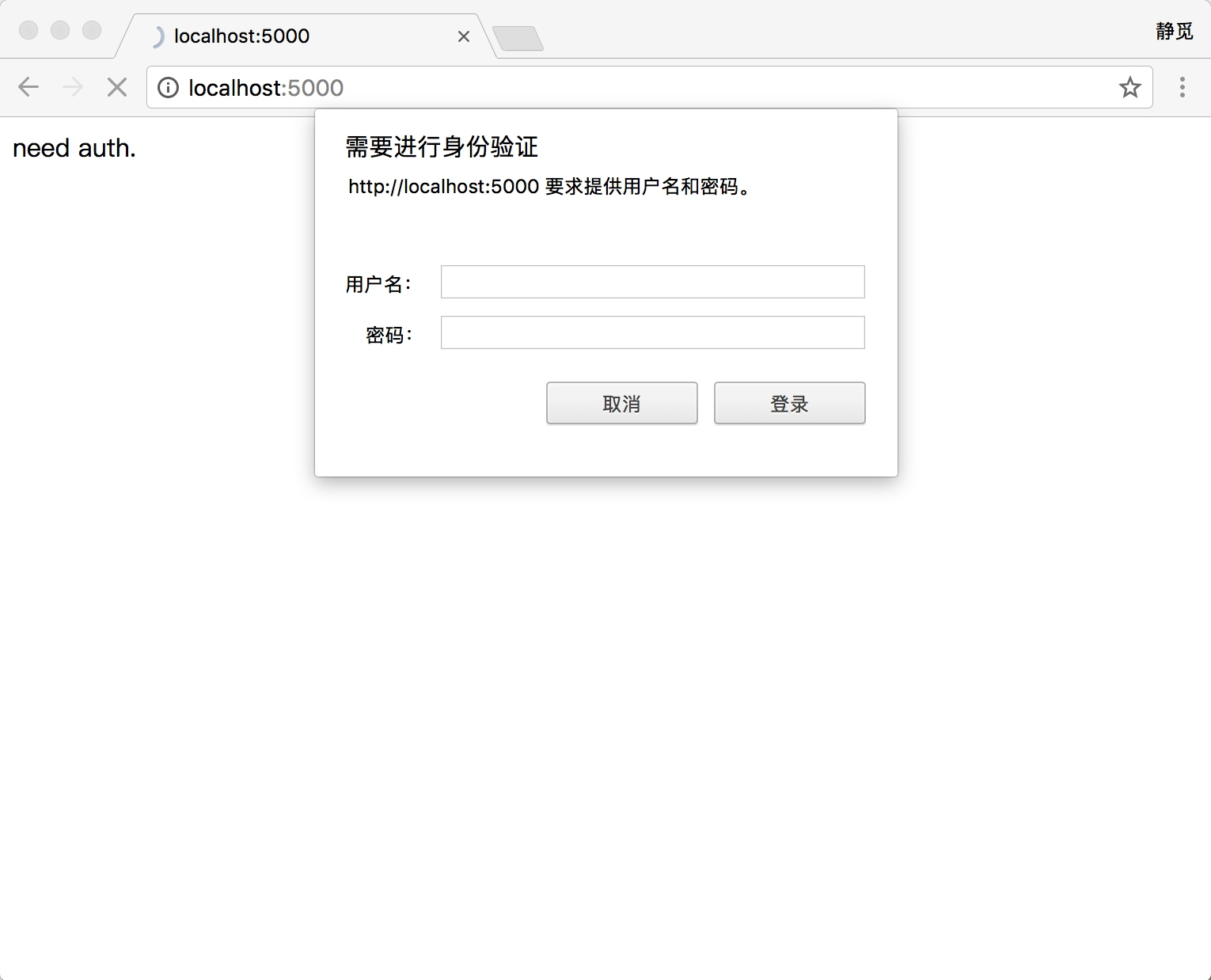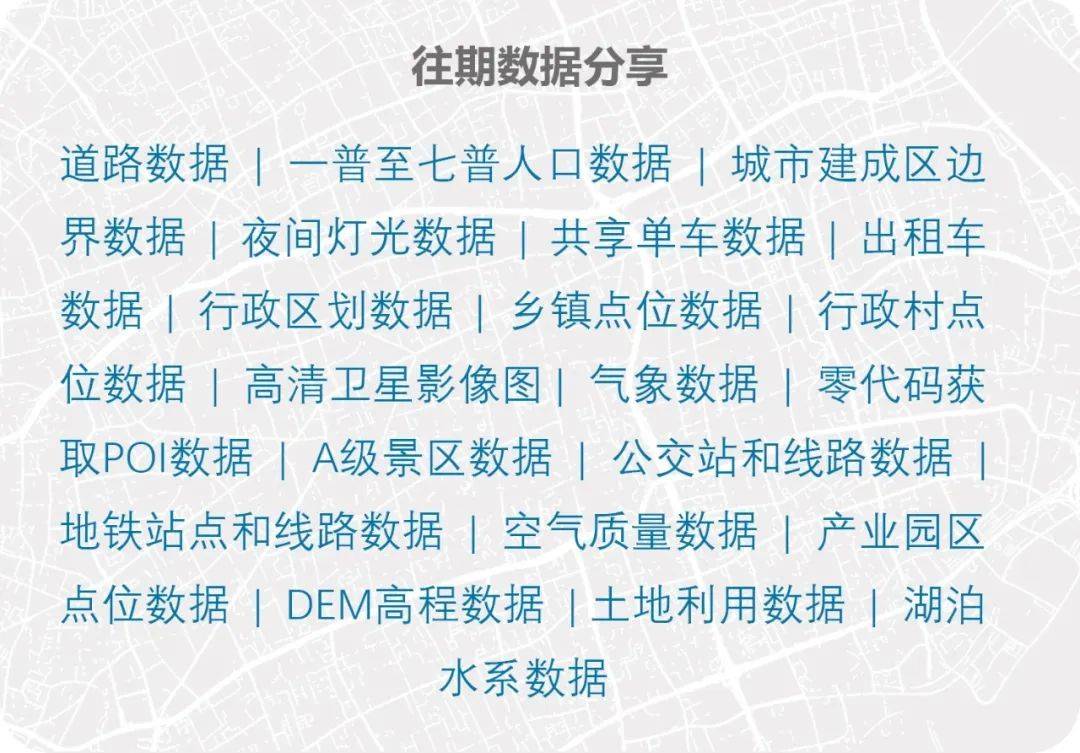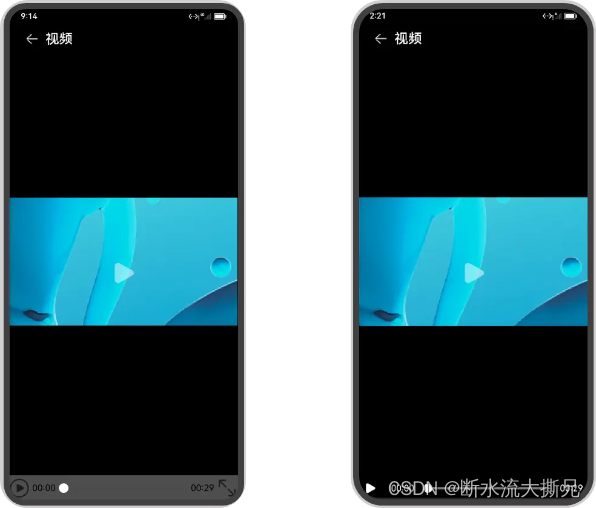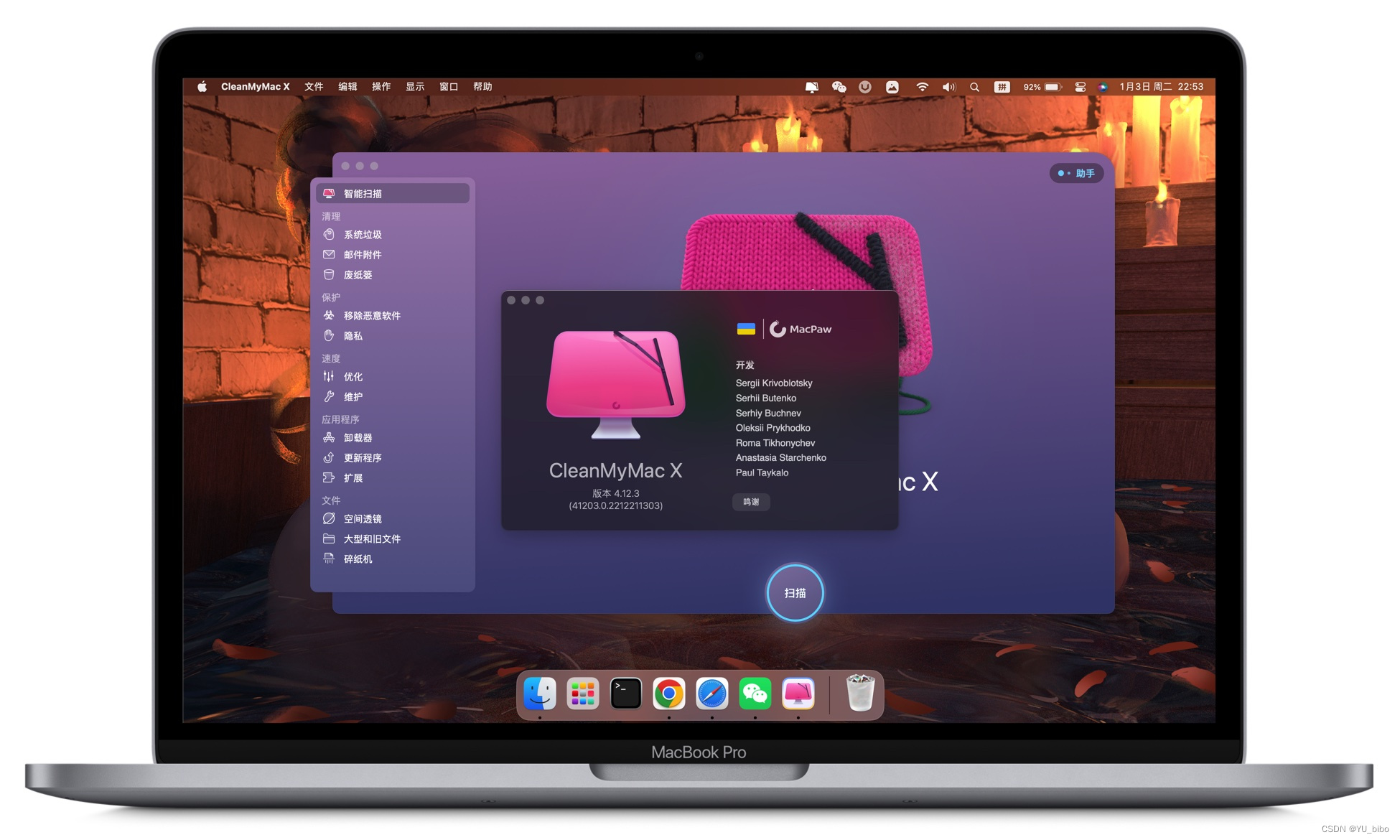《学成在线》项目实操笔记系列【上】,跟视频的每一P对应,全系列12万字,涵盖详细步骤与问题的解决方案。如果你操作到某一步卡壳,参考这篇,相信会带给你极大启发。同时也欢迎大家提问与讨论,我会尽力帮大家解答。
一、前期准备
1.1 项目介绍 P2
To C面向个人,B2B2C(第1个B是指商品或服务的供应商,第2个B是指从事电子商务的企业,C是消费者。例子:腾讯课堂,第1个B是腾讯公司,第2个B是入驻授课的企业,C是用户学习课程)
本项目含有3个端:用户端;机构端;运营端
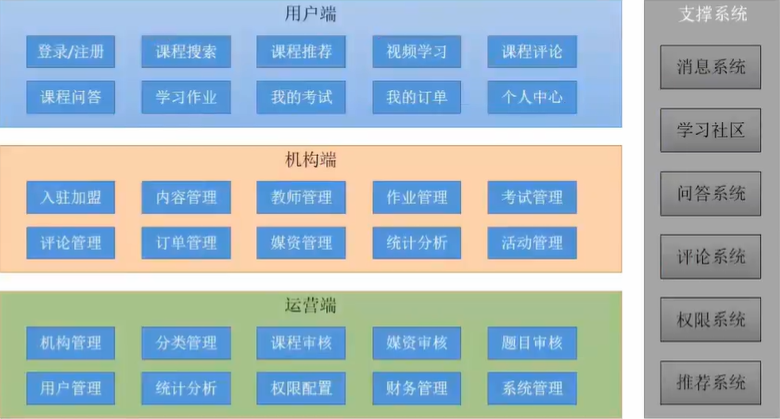
1.2 说自己项目 P3
从以下几个方面进行项目介绍:
1.项目的背景,包括:是自研还是外包,什么业务,服务的客户群是谁,谁去运营等问题。
2.项目的业务流程(核心的业务流程)
3.项目的功能模块(核心模块一定要说)
4.项目的技术架构
5.个人工作职责(说得详细一些)
6.个人负责模块的详细说明,包括模块设计,用到的技术,技术的实现方案等(找最熟悉的模块进行说明)。
项目基本介绍:是公司自研的专门针对成人职业技能教育的网络课堂系统,网站提供了成人职业技能培训的相关课程,如:软件开发培训。基于B2B2C的业务模式。培训机构可以在平台入驻、发布课程,我们公司作为运营方由专门的人员对发布的课程进行审核,审核通过后课程才可以发布成功,课程包括免费和收费两种形式,对于免费课程用户可以直接选课学习,对于收费课程要在选课后支付成功才可以继续学习。
本项目包括3个端:用户端、机构端、运营端。
核心模块:内容管理、媒资管理、课程搜索、订单支付、选课管理、认证授权等。
本项目采用前后端分离架构,后端采用SpringBoot、SpringCloud技术栈开发,数据库使用了Mysql,还使用了Redis、消息队列、分布式文件系统、Elasticsearch等中间件系统(要清楚这些中间件在系统中是如何使用的,在哪里使用的)。
划分的微服务包括:内容管理服务、媒资管理服务、搜索服务、订单支付服务、学习中心服务、系统管理服务、认证授权服务、网关服务、注册中心服务、配置中心服务等。
我在这个项目中负责了内容管理、媒资管理、订单支付模块的设计与开发。
个人负责模块的详细说明:内容管理模块,是对平台上的课程进行管理。设计了课程基本信息表、课程营销表、课程计划、课程师资表。培训机构要发布一门课程需要填写课程基本信息、课程营销信息、课程计划信息、课程师资信息,填写完毕后要提交审核,由运营人员进行课程信息的审核,整个审核过程是程序自动审核加入人工确认的方式,通常24小时完成审核。课程审核通过即可发布课程,课程的相关信息会聚合到课程发布表中,这里不仅要将课程信息写到课程发布表还要将课程信息写到索引库、分布式文件系统中,所以这里存在分布式事务的问题,项目使用本地消息表加任务调度的方式去解决这里的分布式事务,保证数据的最终一致性。
1.3 技术架构 P5
业务:解决了什么问题,为用户提供了什么样的服务。
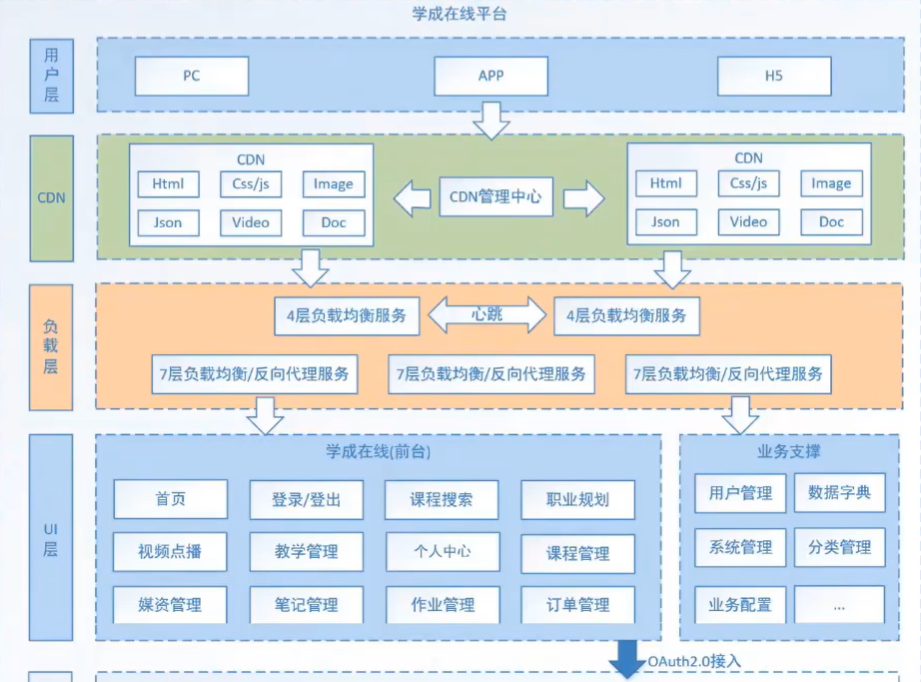


技术栈:
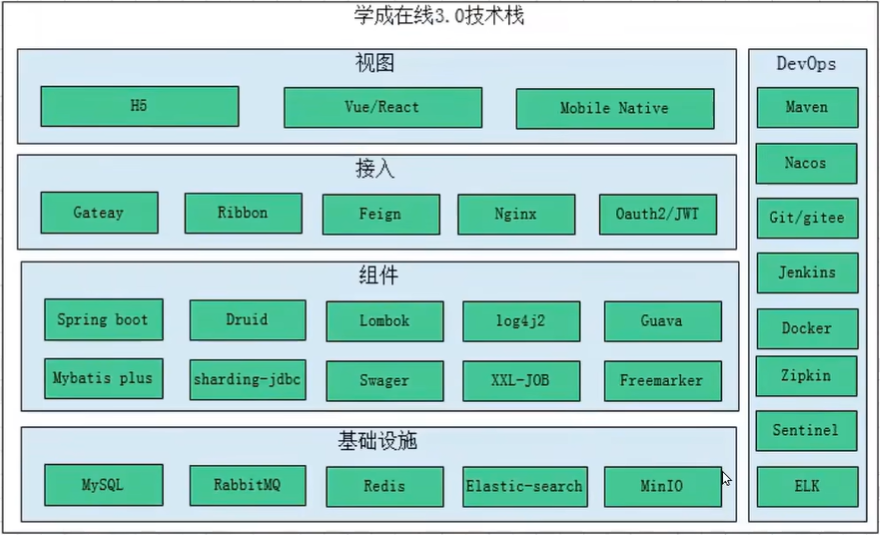
1.4 环境配置 P6
配置环境版本如下:
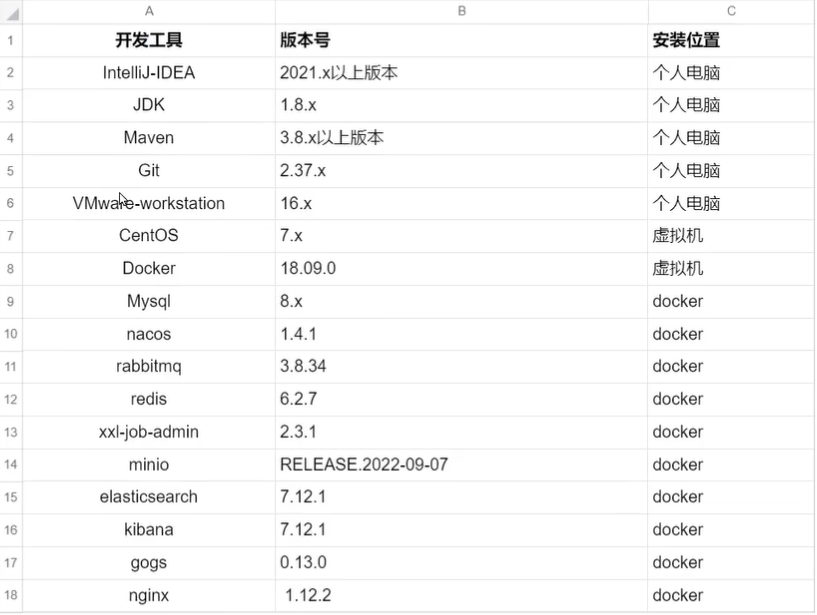
IDEA基本配置如下:

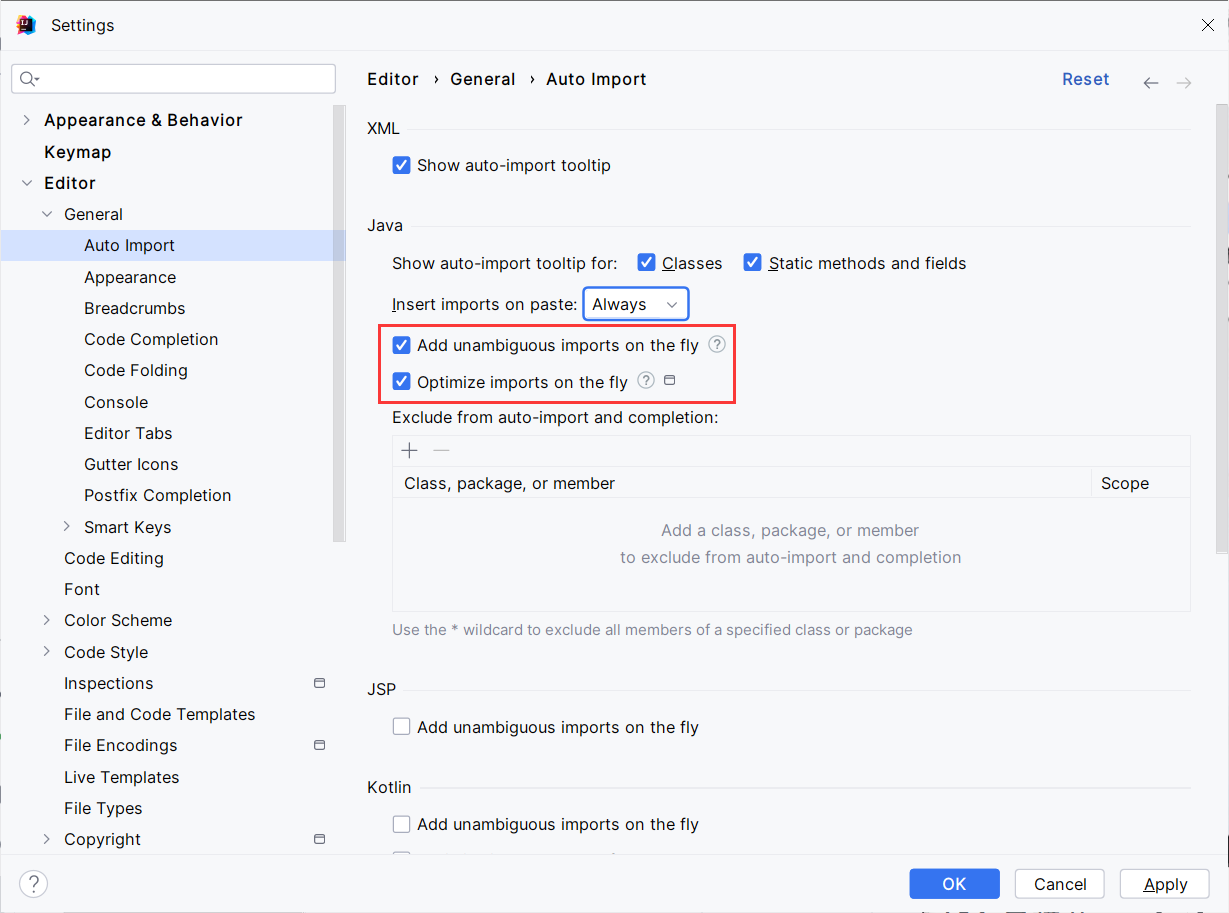
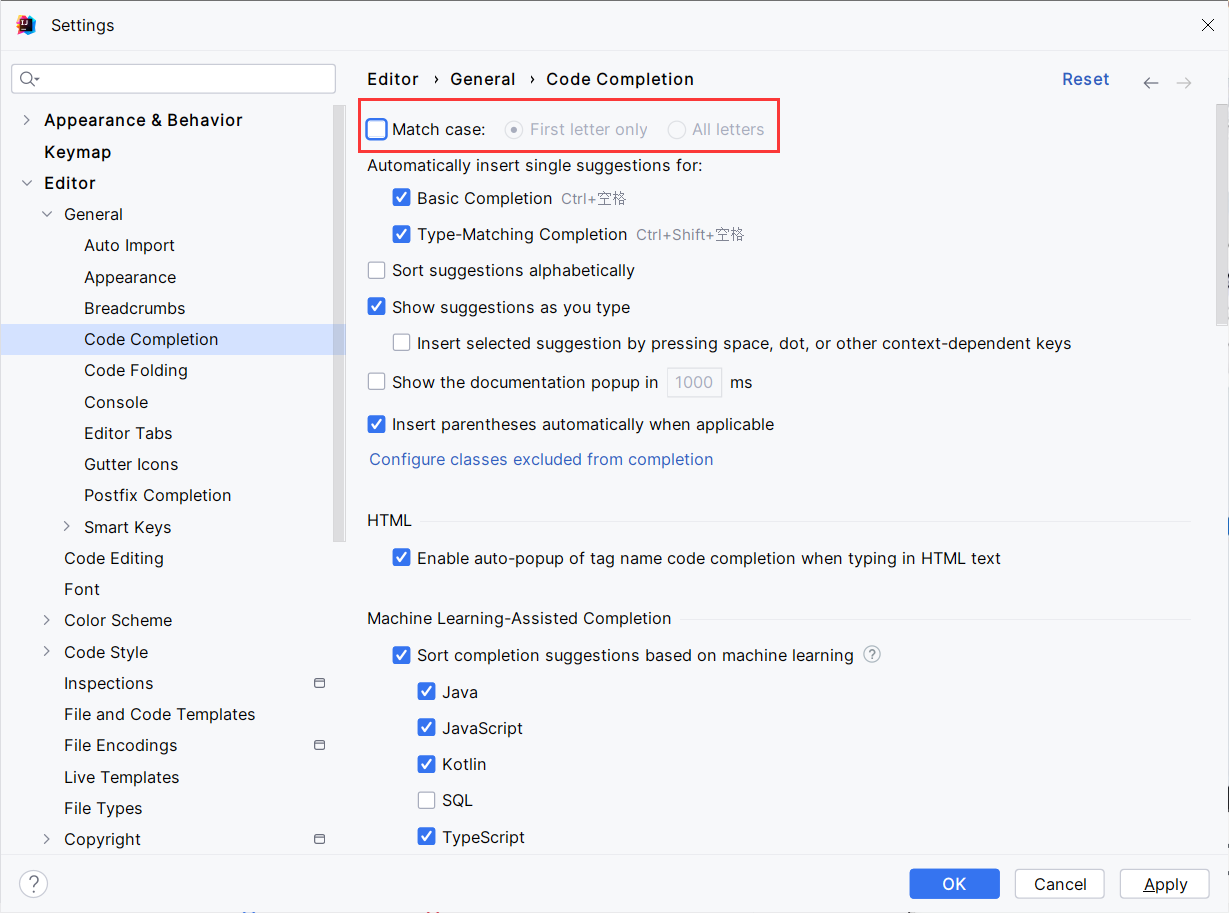
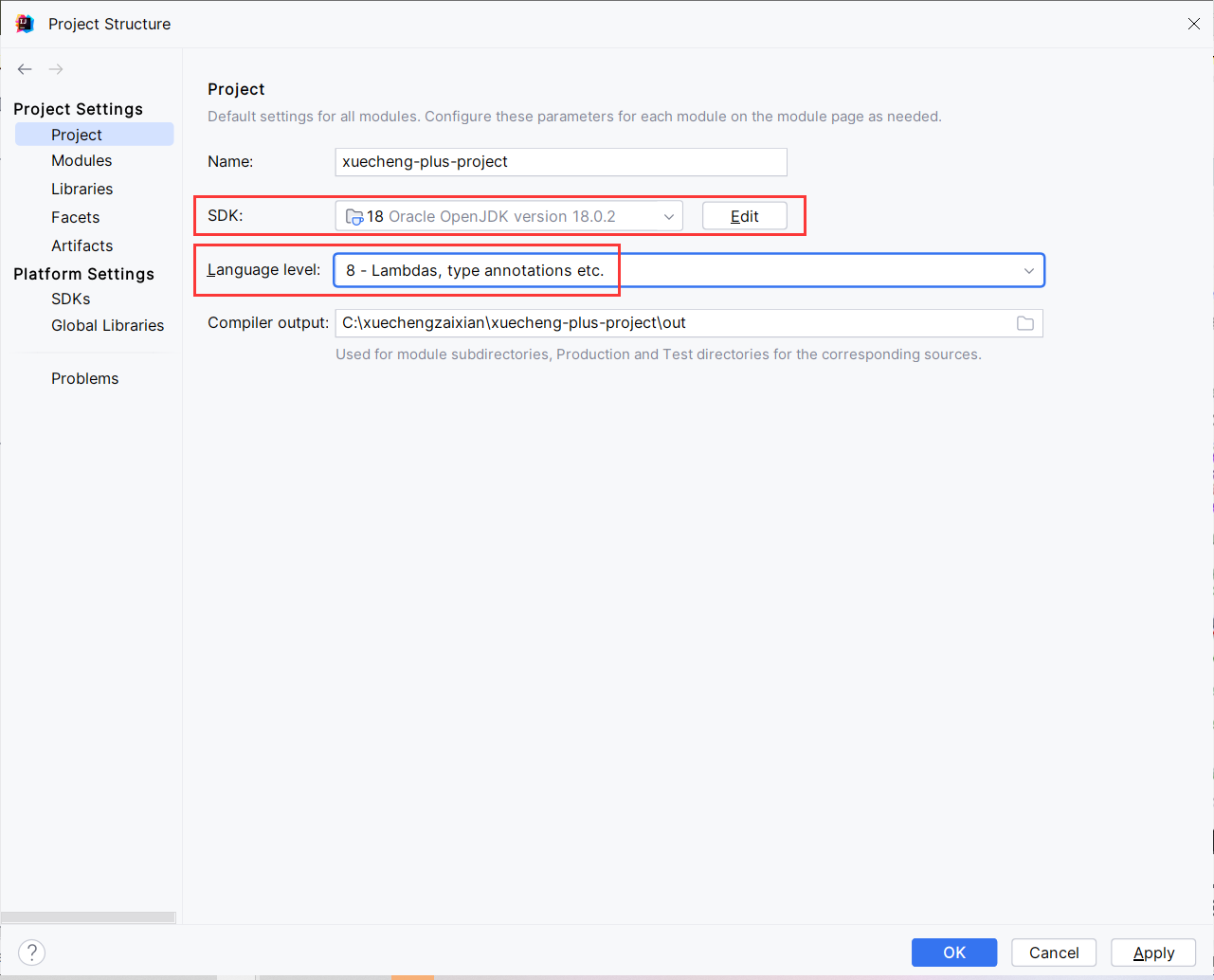
Maven配置:
先把maven解压,然后把maven仓库解压。
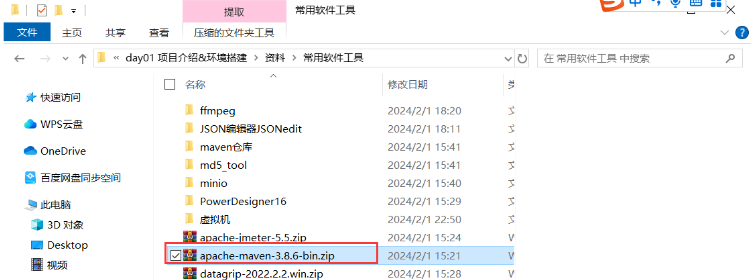
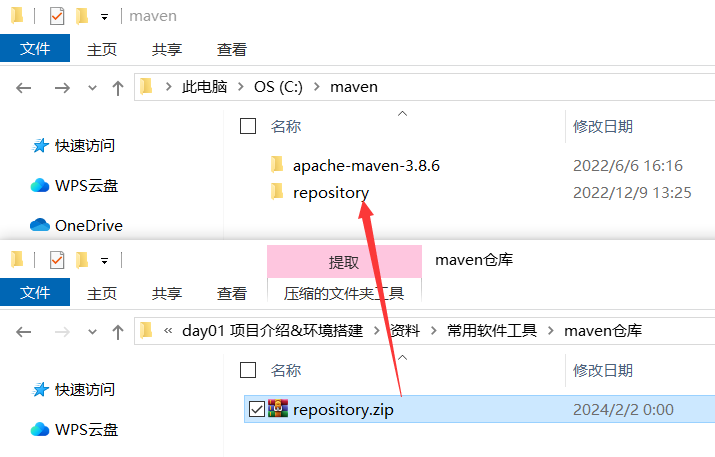
在maven的setting.xml文件中进行配置:
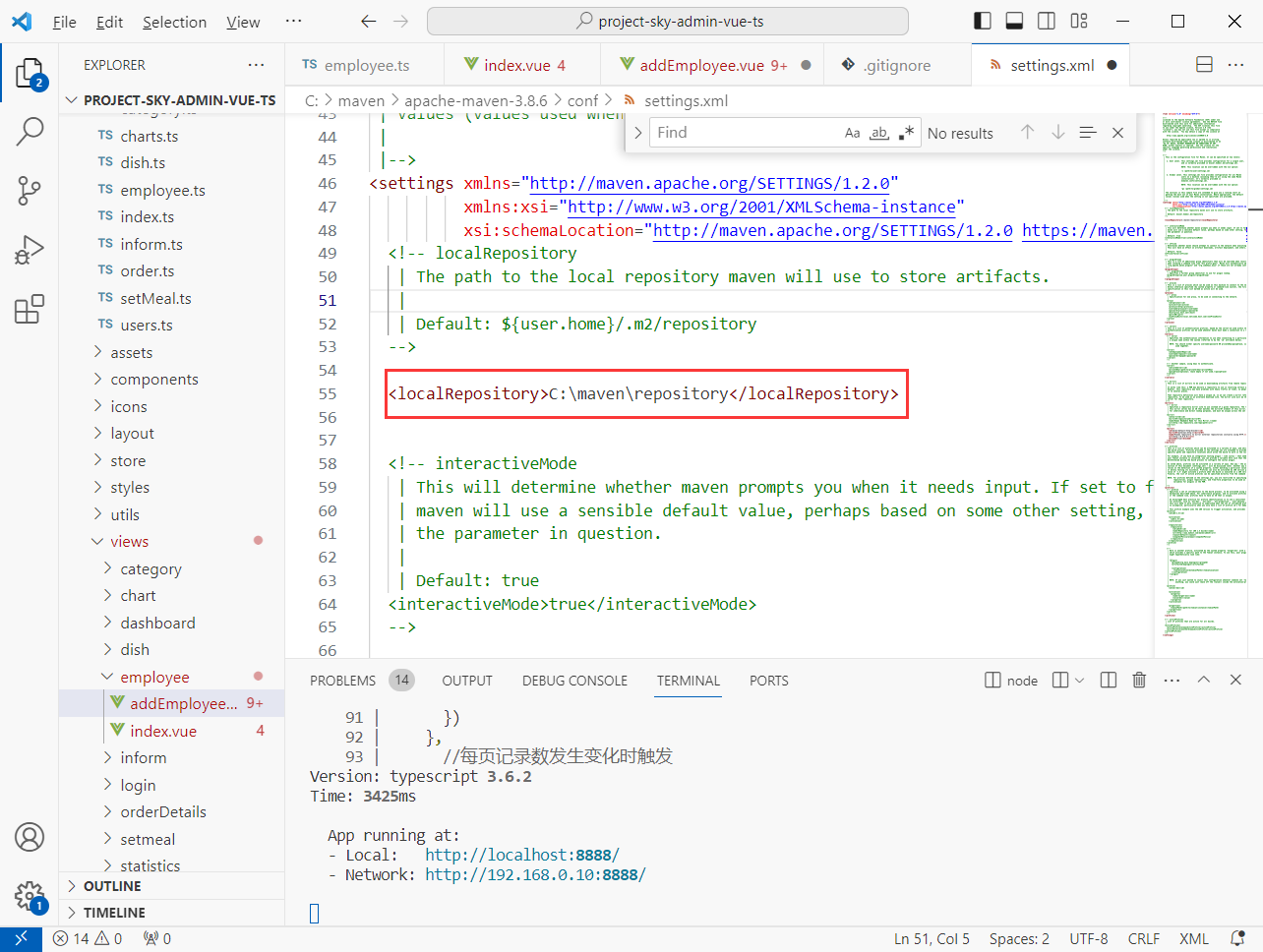
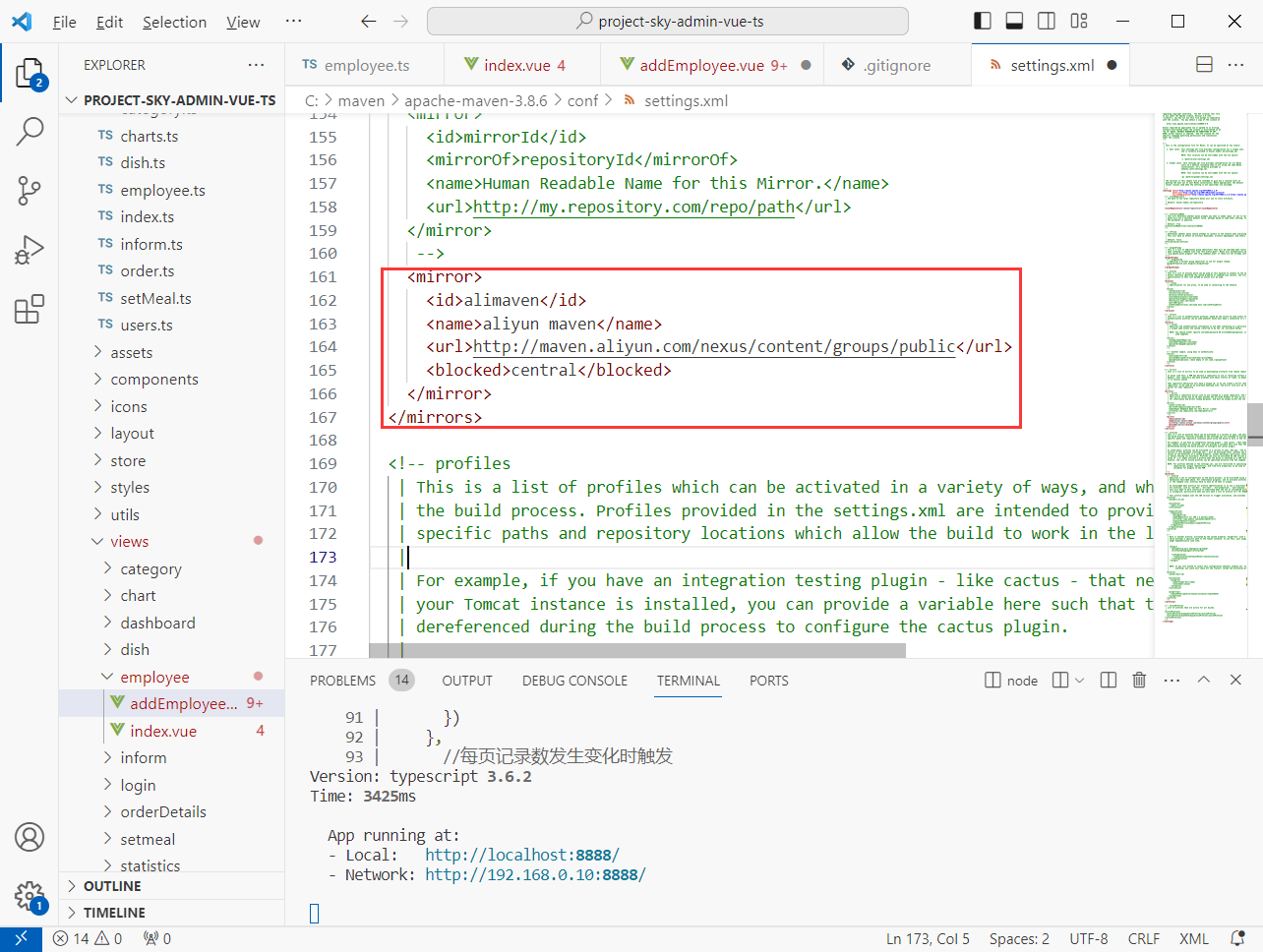
<mirror>
<id>alimaven</id>
<name>aliyun maven</name>
<url>http://maven.aliyun.com/nexus/content/groups/public</url>
<blocked>central</blocked>
</mirror>在IDEA中进行配置:
虚拟机配置:
解压虚拟机

双击虚拟机

点击虚拟网络编辑器
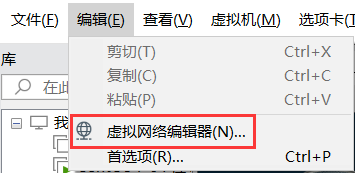
把VMnet8的子网地址改为:192.168.101.0
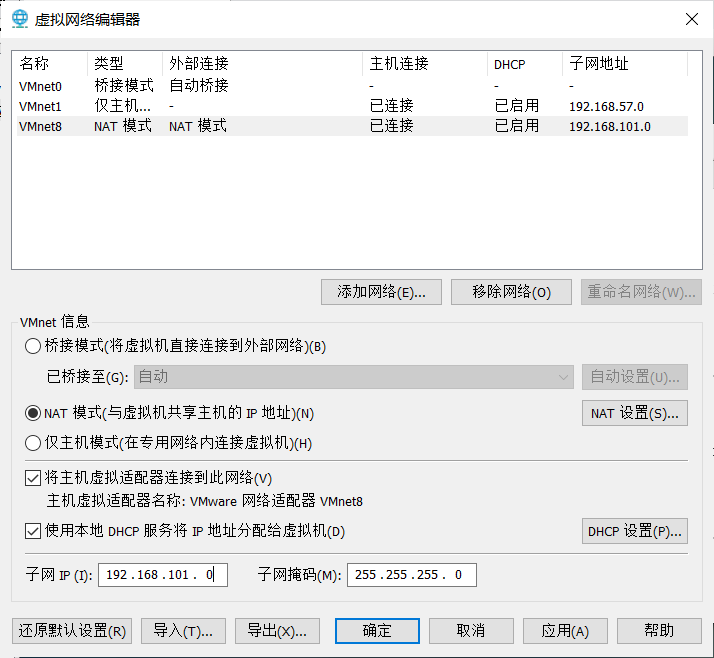
虚拟机的用户名:root,密码:centos
虚拟机ip:192.168.101.65

启动docker
systemctl start docker运行所有的软件:
sh /data/soft/restart.sh查询docker容器:docker ps
docker ps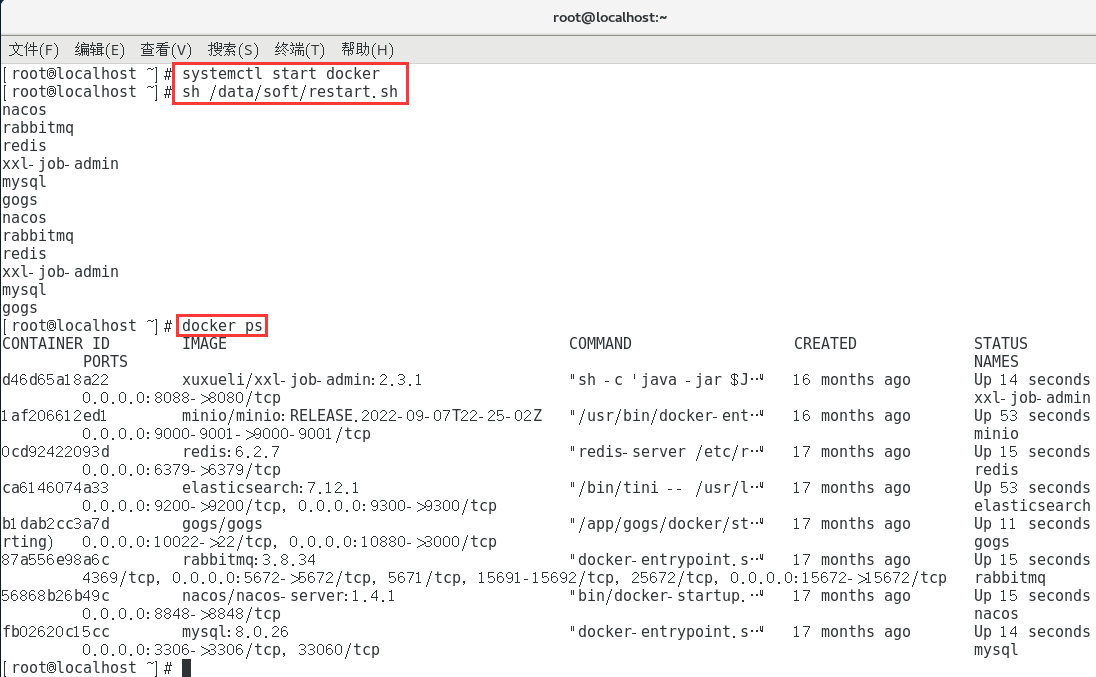
数据库配置:
我是先用Navicat连接上虚拟机中的mysql:
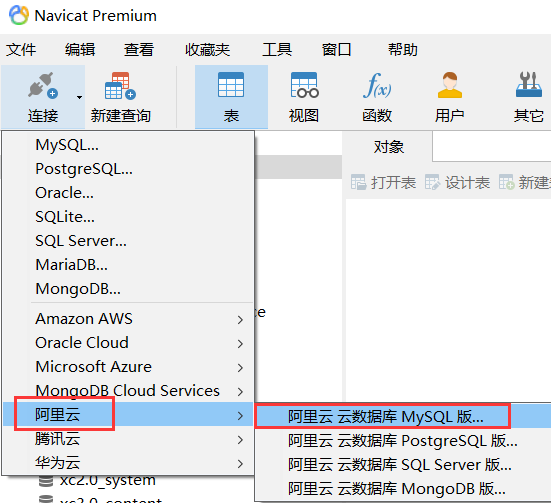
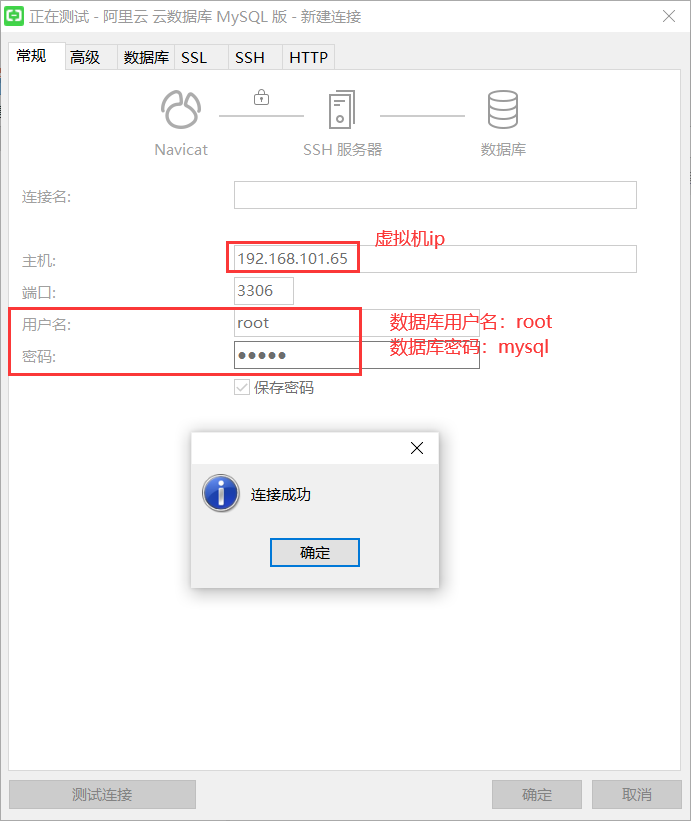
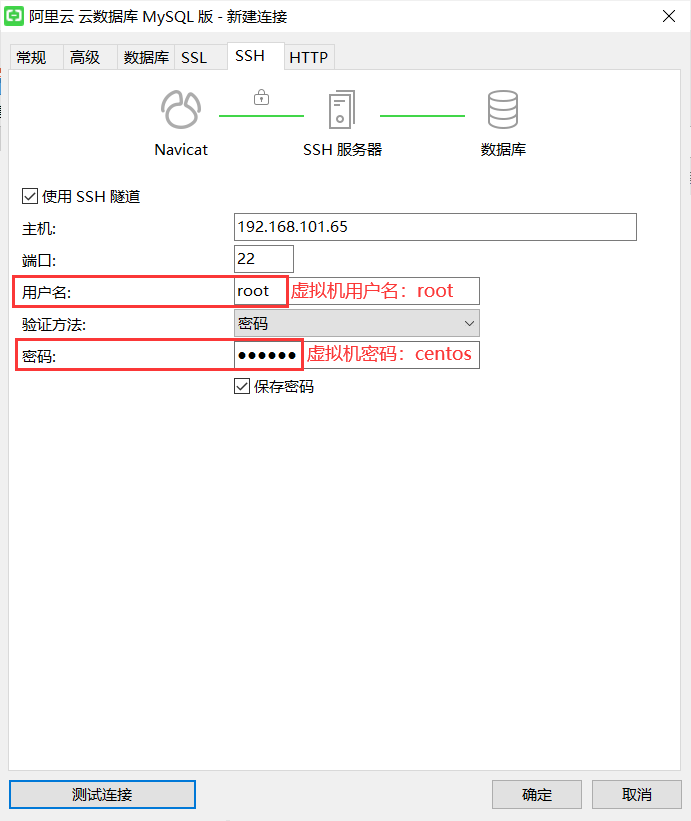
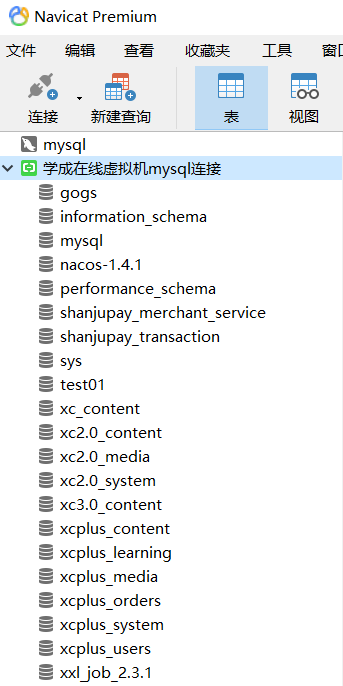
Git配置:
下载完Git然后配置到IDEA上:
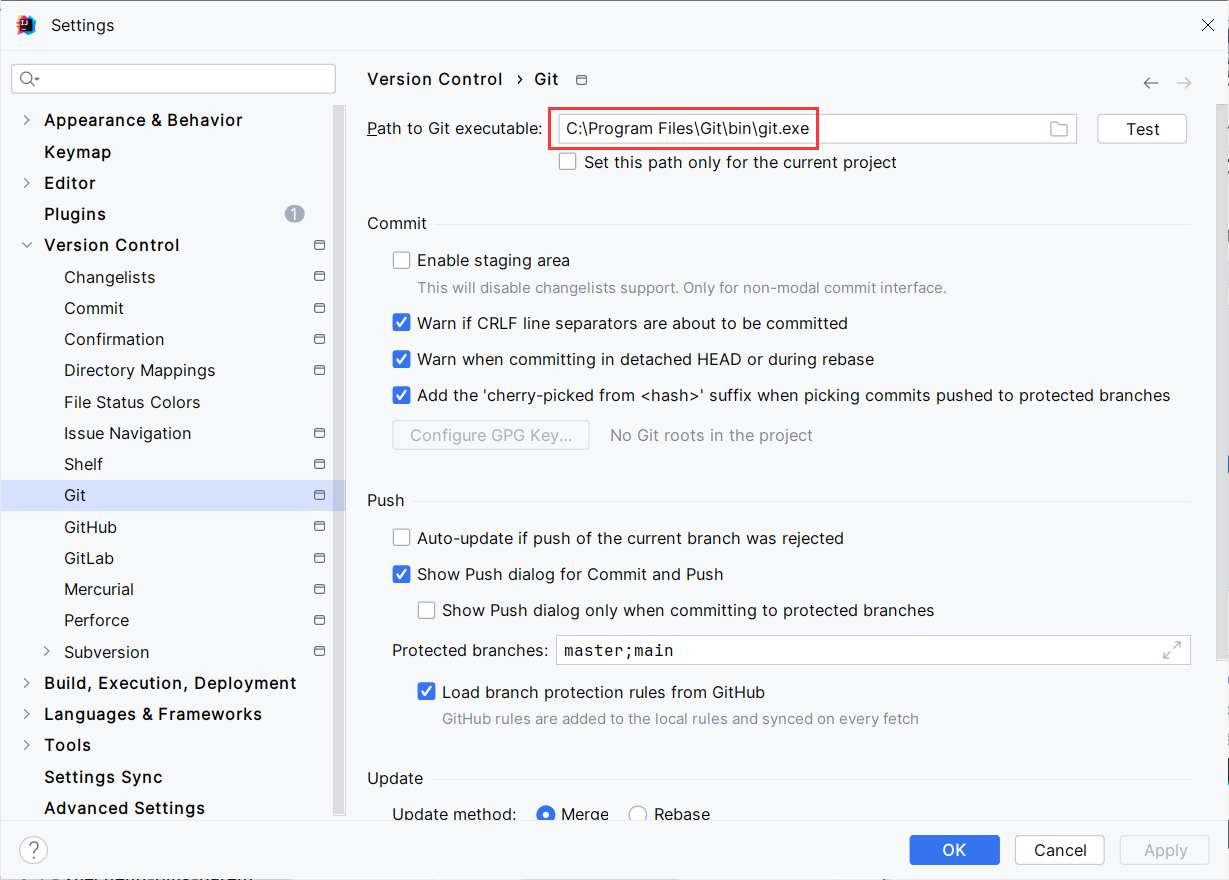
搭建Gogs:
Gogs是一个轻量级的远程仓库,是在虚拟机里面的,本项目使用Gogs作为Git远程仓库。进入Gogs:
http://192.168.101.65:10880
账号:gogs,密码:gogs
关联远程仓库:
我这里项目已经创建好了,我想要关联远程仓库,就不按照视频的方法进行。
点击VCS-Create Git Repositoty,选择当前项目的文件夹作为仓库,全选当前项目中所有文件,输入文字,然后点击commit。就可以把项目上传到本地仓库。
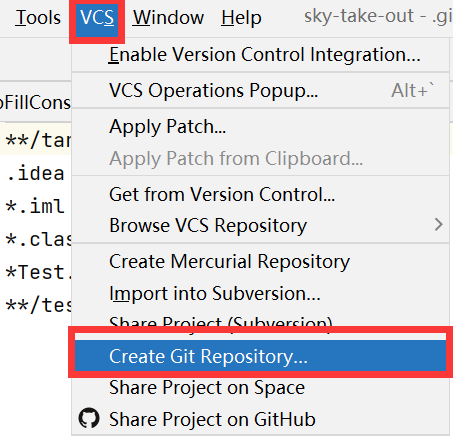
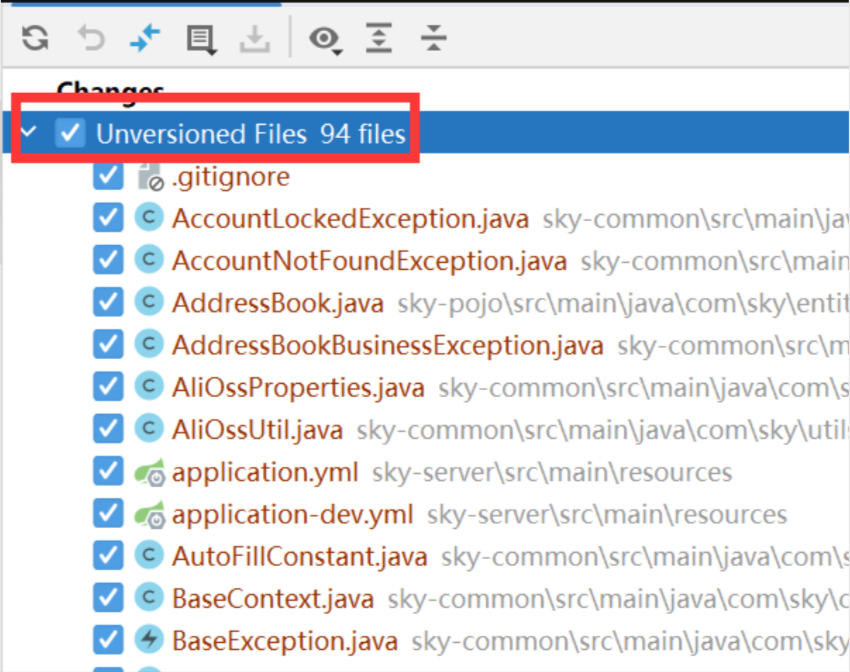

然后点击向上的按钮,点击Define remote,会跳出一个弹窗,弹窗的地址填写下面网页中的地址:
![]()

我直接使用现成的仓库,复制下面的HTTP地址,粘贴到上面弹窗中,然后会有输入账号密码的弹窗填gogs的账号密码:

然后就会出现项目内容:

如果忘记gogs密码:
可以在用户设置处更改密码;也可以在管理面板,用户管理,编辑处让管理员指定密码:
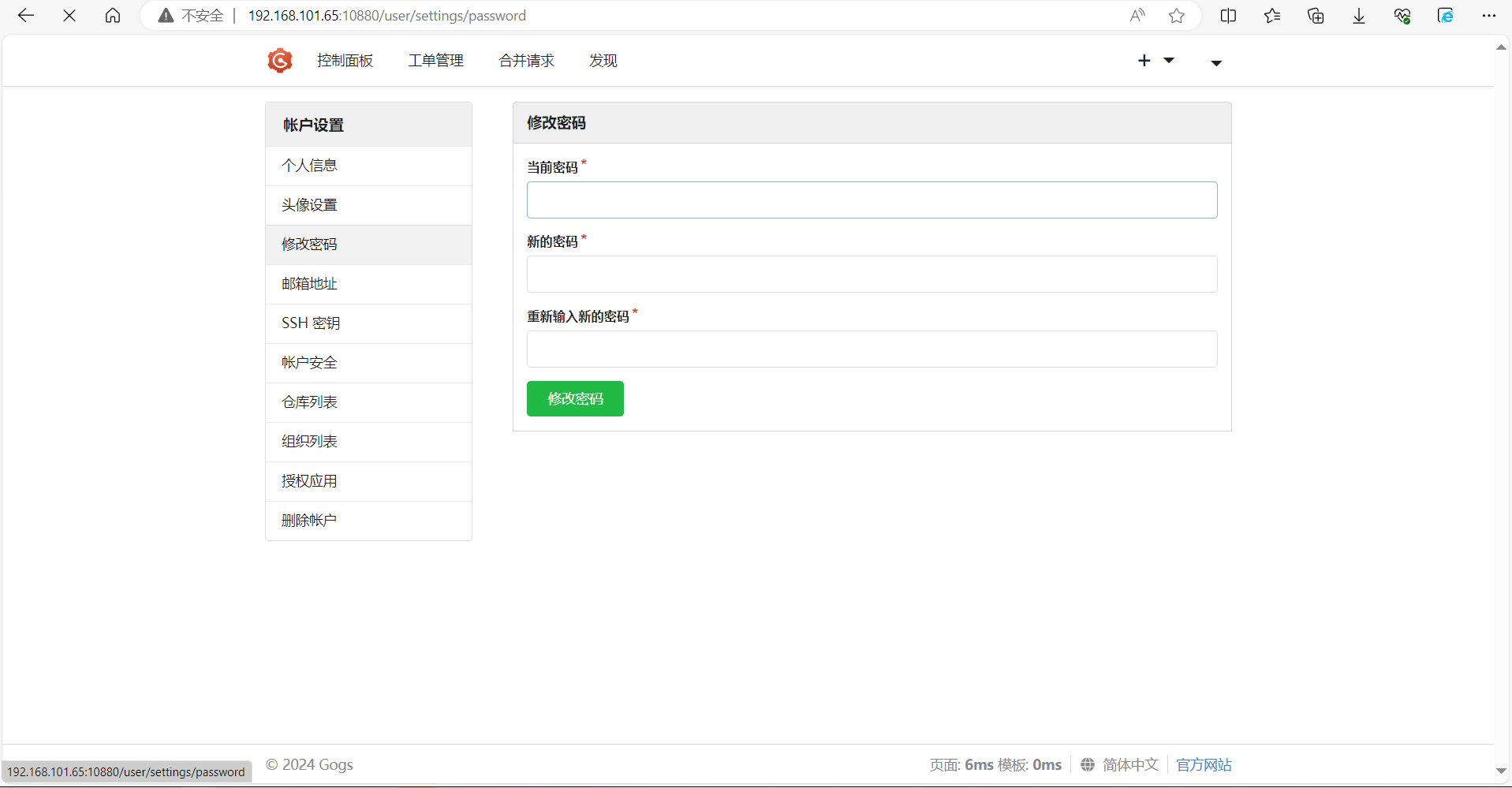
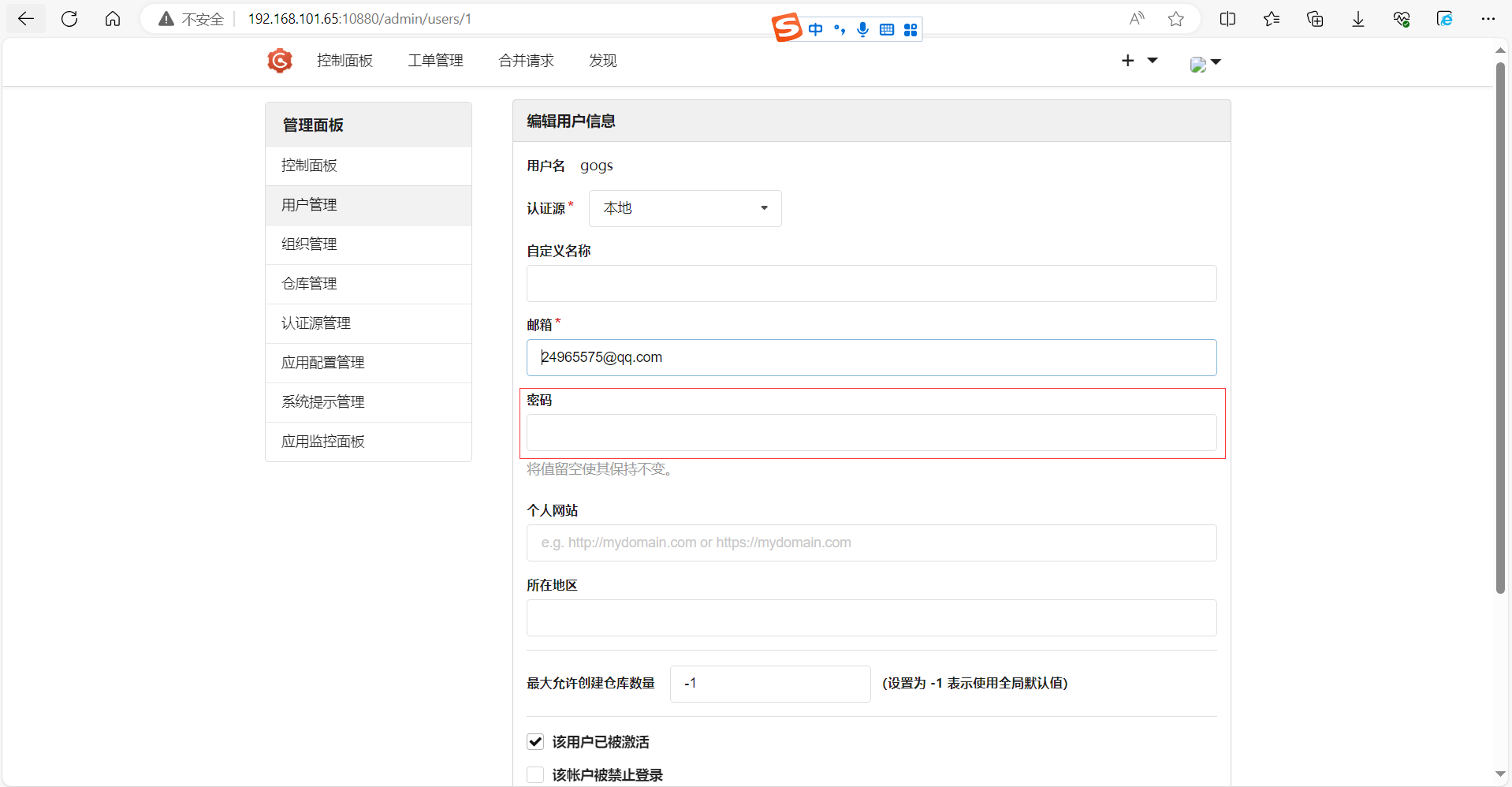
如何还是提示密码错误,可以在IDEA中,把文件名改掉(改成不存在的,会提示输入密码),也可以选不保存忘记密码:
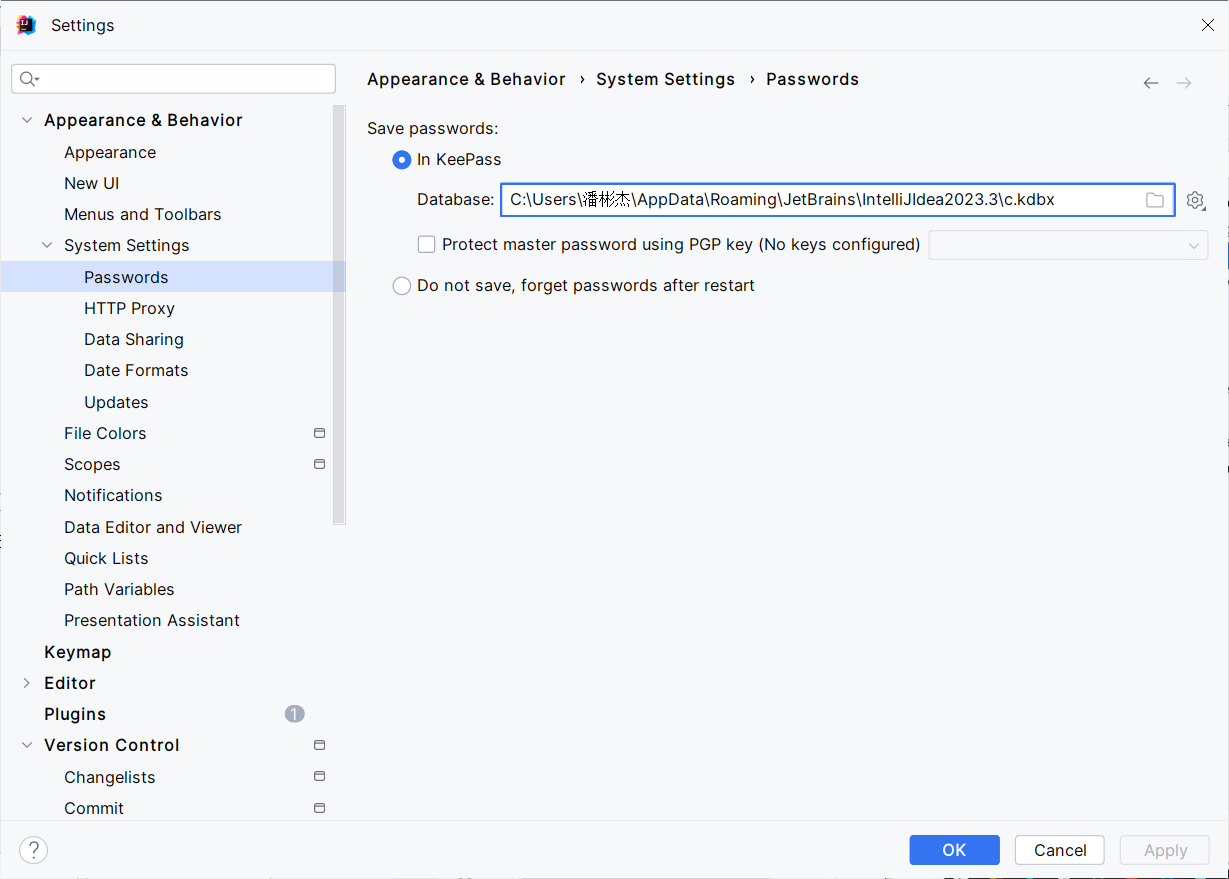
配置.gitignore文件
把下面文件夹中的内容复制到IDEA的.gitignore文件中。
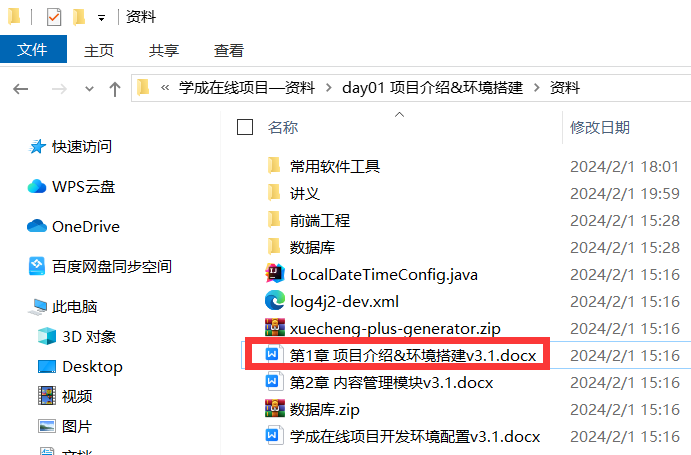
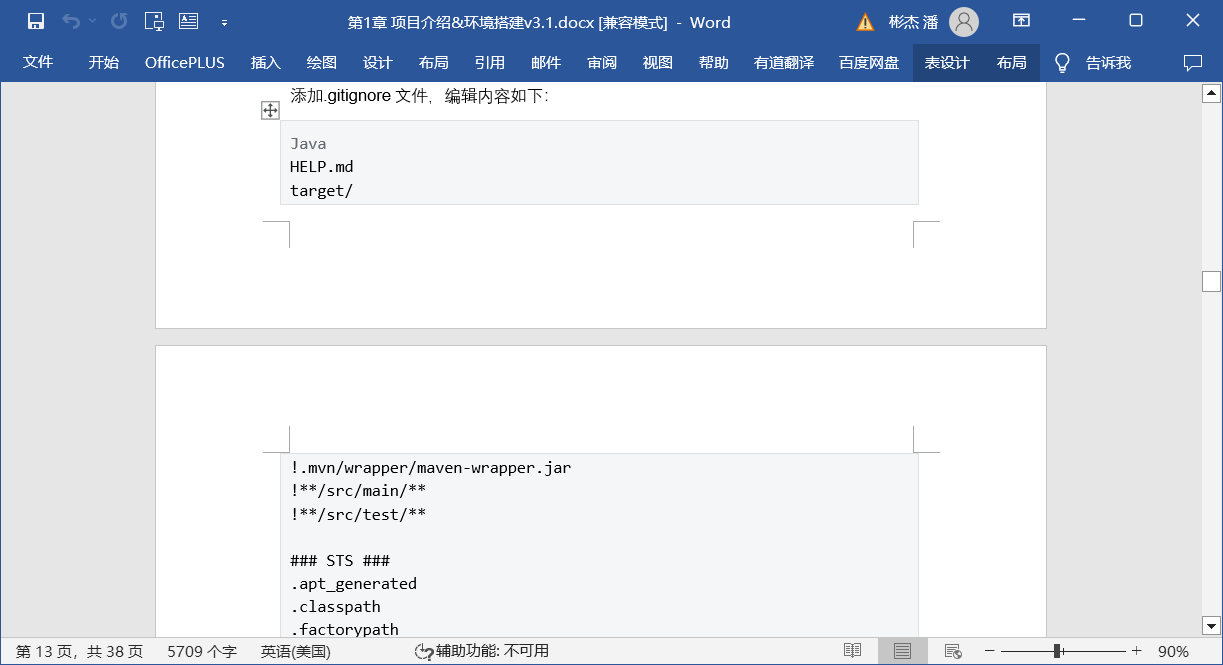
选中.gitignore,先commit然后push到远程仓库。
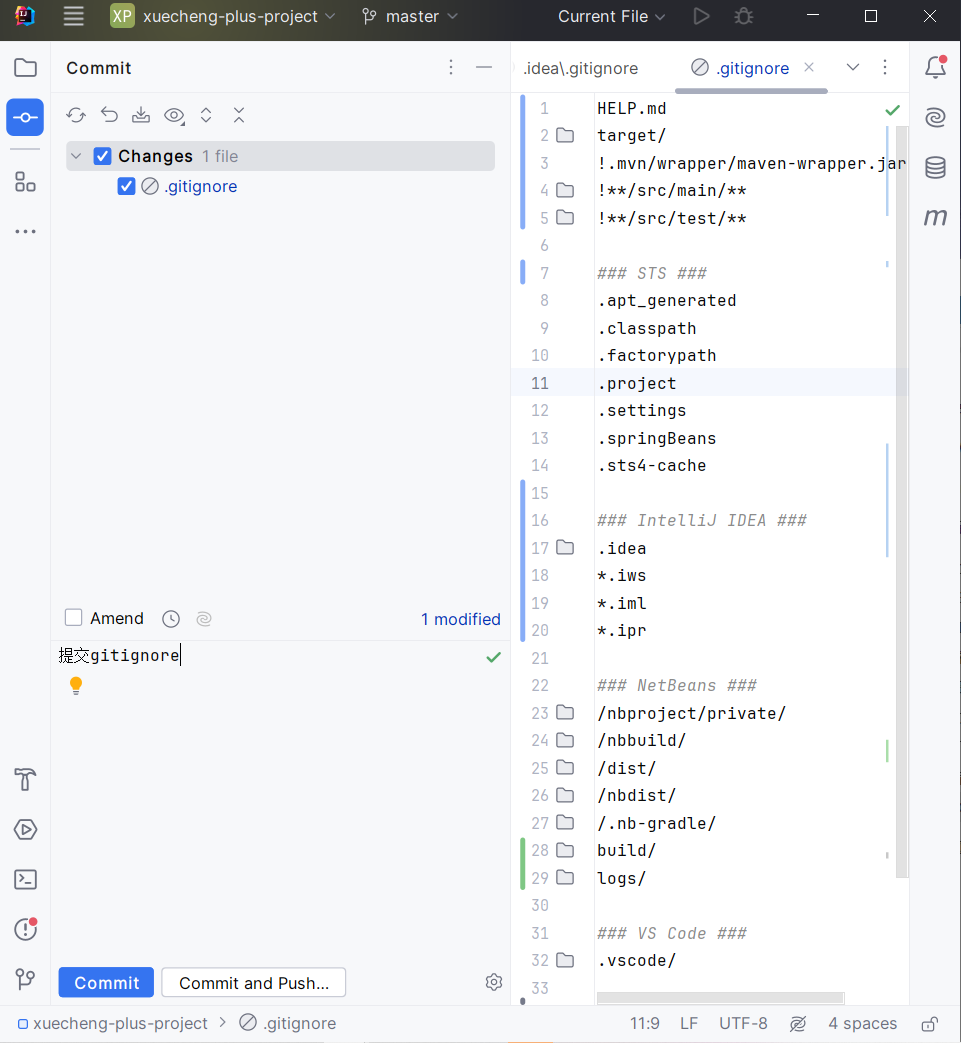
关于分支:
老师每一天的授课内容都会创建一个分支。如果想看看第1天的代码,就可以切换到第1天的分支,然后该分支只会显示第1天的代码。
分支在Git中相当于一个独立的工作流,每个分支都可以有不同的提交历史和代码改动。
可以通过在Git界面右键分支,点击Checkout来切换分支。
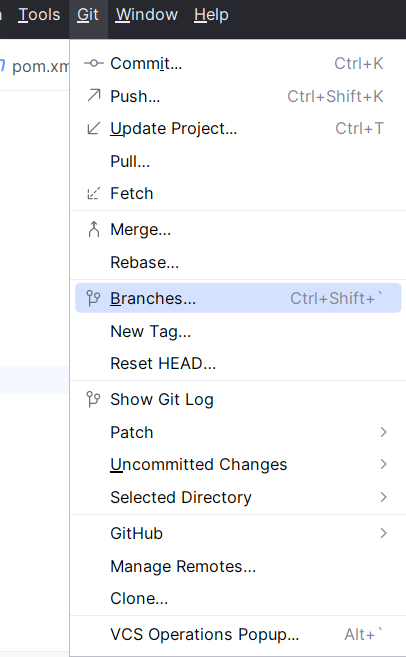

1.5 创建工程 P7
父工程职责:把所有依赖的版本确定下来,模块的聚合作用。
基础工程:基础的代码。所有的微服务依赖于基础工程。
首先创建名为xuecheng-plus-project的工程,把src文件删掉,然后创建xuecheng-plus-parent的模块。
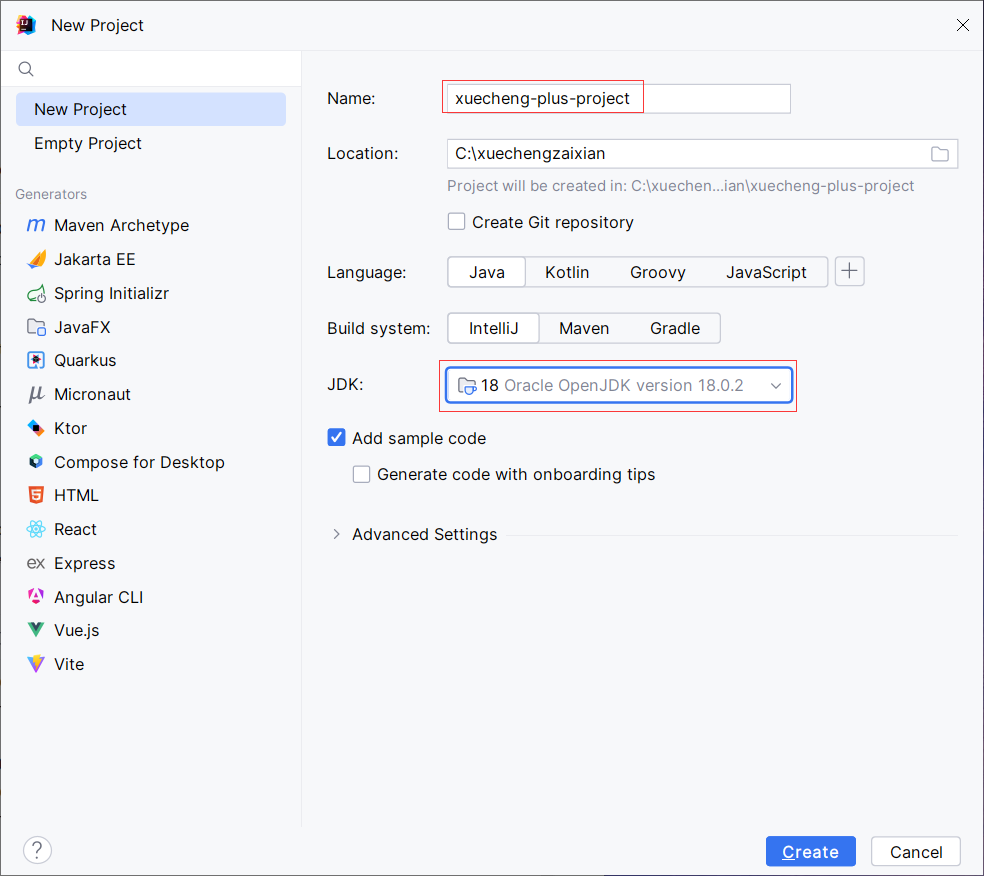
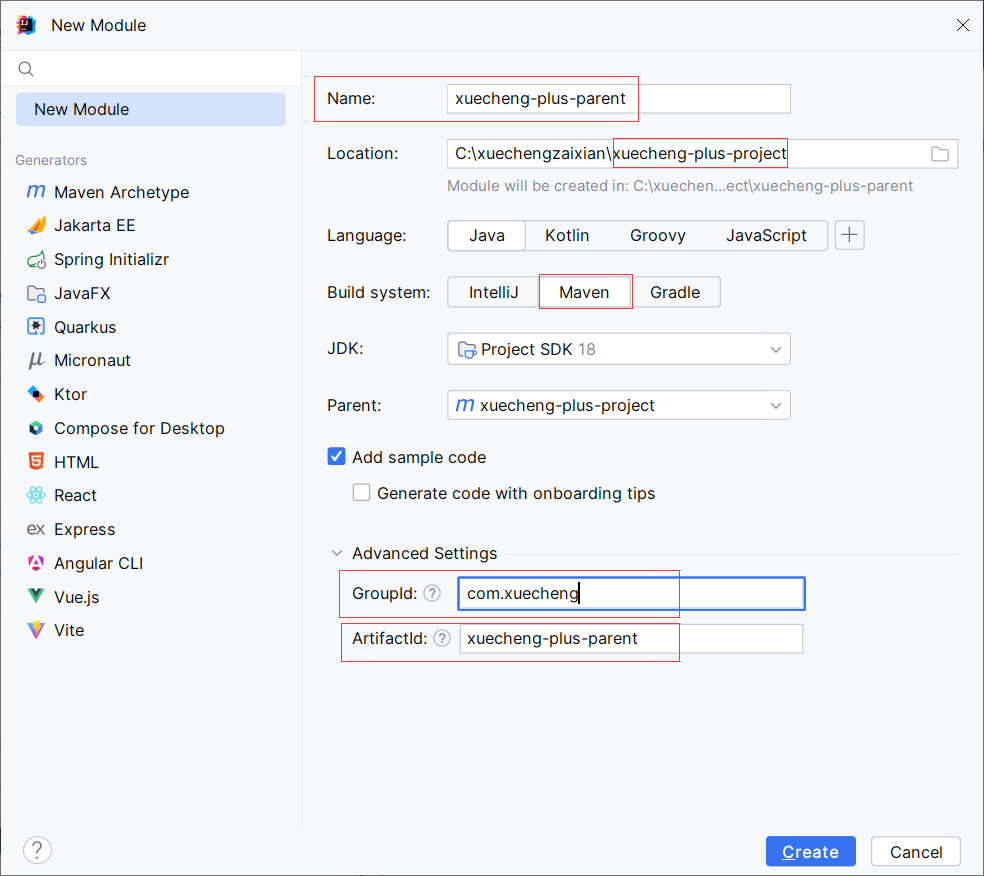
项目结构大概如下,然后把第1章里的pom.xml代码复制到父工程的pom.xml文件中:
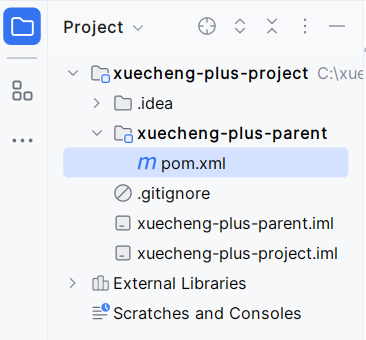
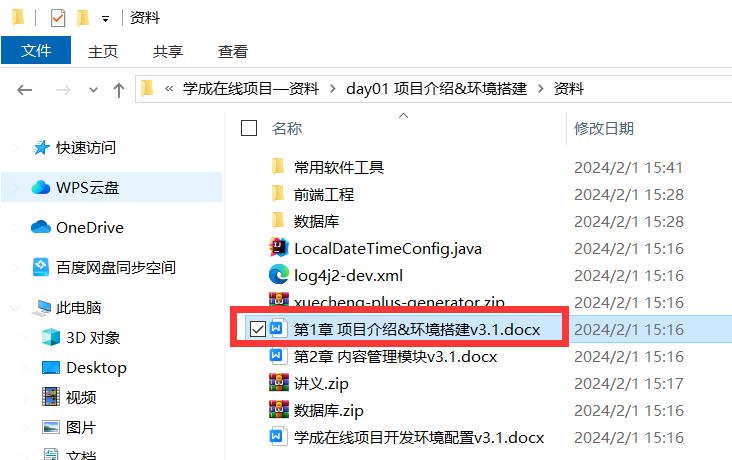
首先用properties标签把所有依赖的版本确定,然后dependencyManagement标签来引入对应的依赖。
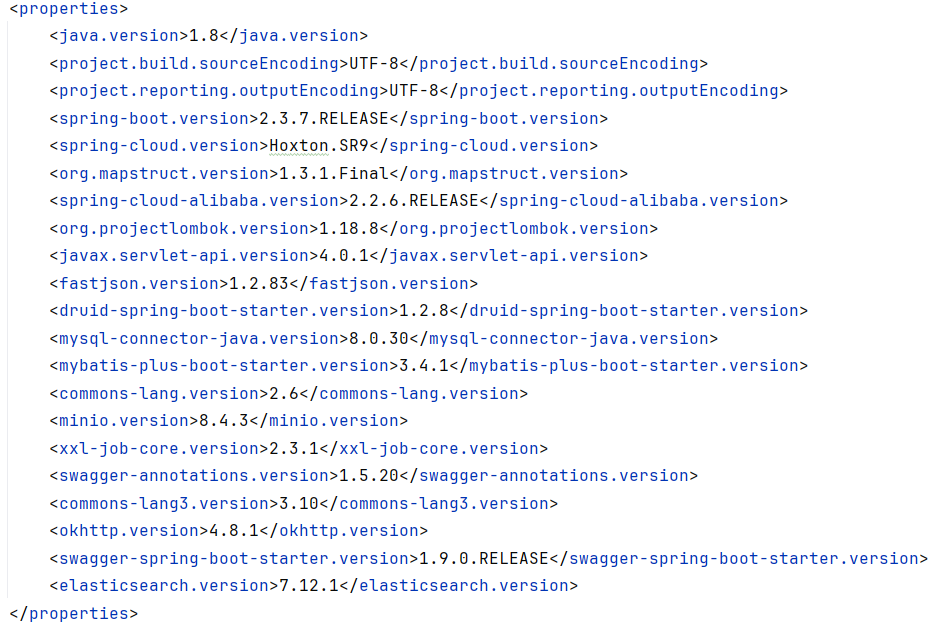
下面创建xuecheng-plus-base模块,这个模块和parent模块是并列关系。base模块里除了src和pom.xml文件外其它东西删掉,包括一些启动类和配置项都要删除,只留下基本结构。
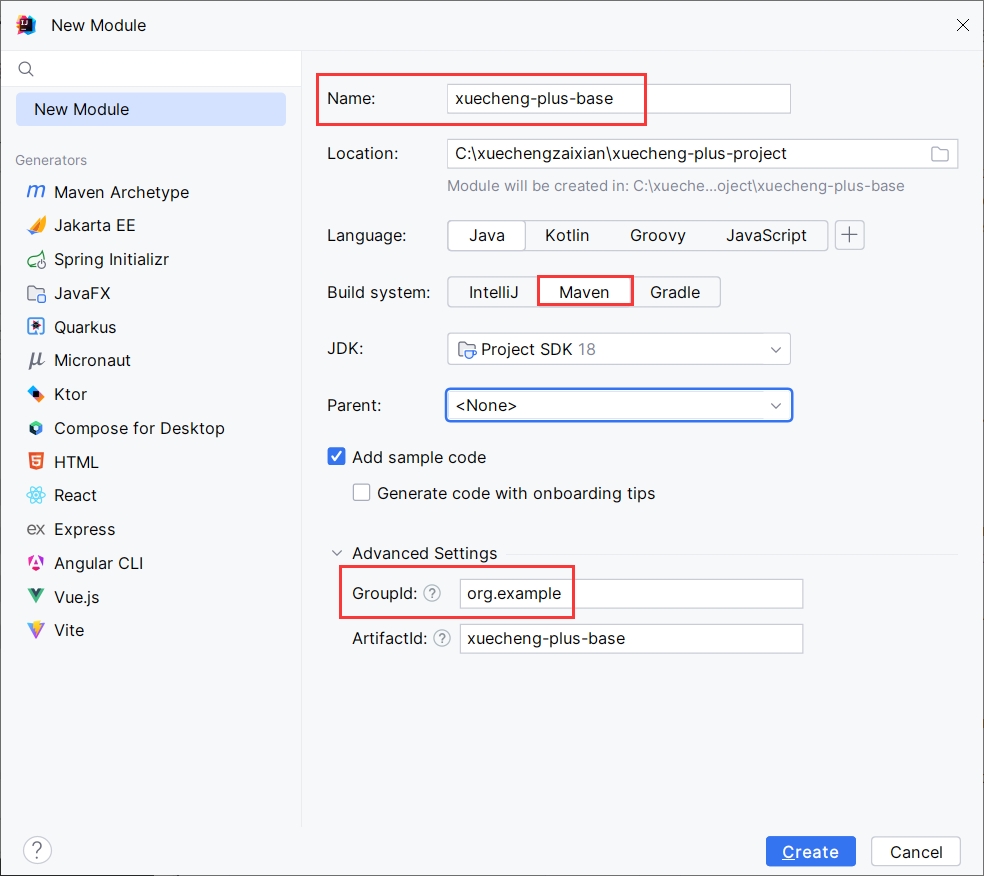
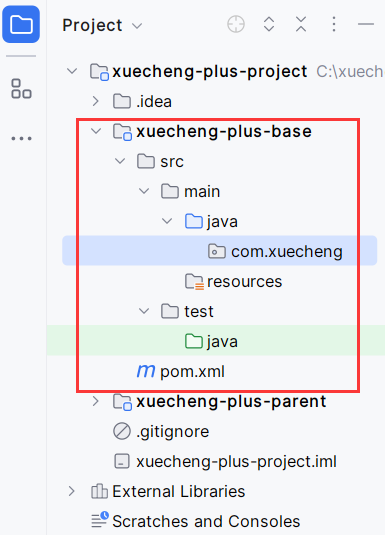
所有模块都是直接或间接继承父模块,所以要把父工程的坐标(下面红框里)复制,然后粘贴到base模块的<parent>标签下

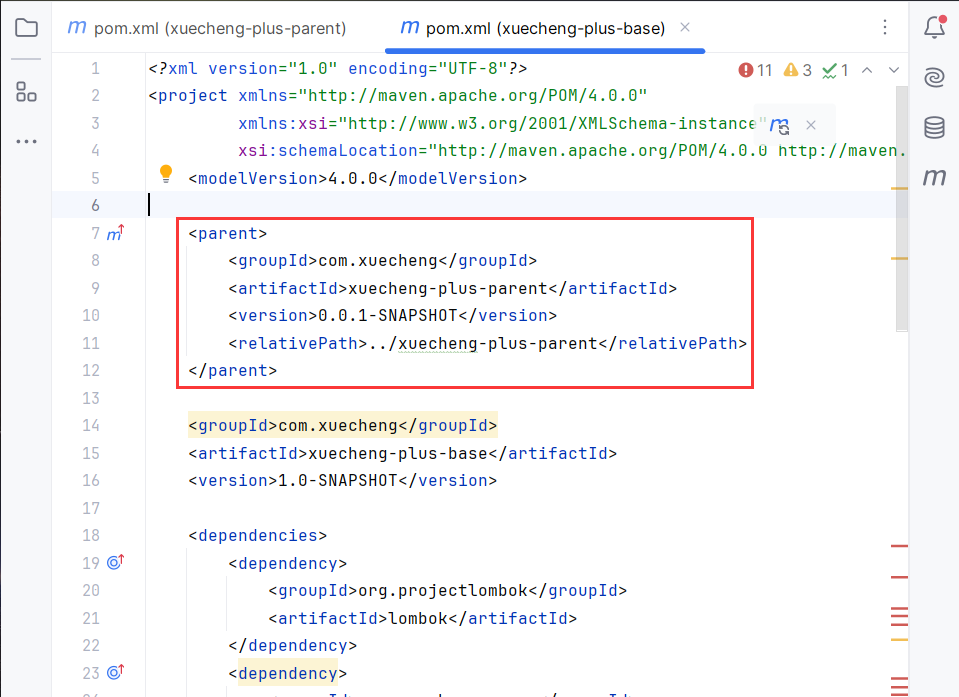
然后把下面文件中base模块pom.xml中的<dependencies>标签下的内容单独复制,粘贴替换base模块的pom.xml中的<dependencies>下的内容。


1.6 Git面试 P8
可以在Git面板看到所有commit提交到本地仓库的版本。小铅笔所在的就是当前的分支。

面试题1:Git代码冲突怎么处理?
冲突的原因:本地文件的版本浴目标分支中文件的版本不一致时,当存在同一行的内容不同时在进行合并时会出现冲突。
场景:多个分支向主分支合并时(A同事和B同事开发过程中对同一文件的同一行内容进行修改)。同一个分支下pull或push操作时。
在IDEA里commit是提交到本地仓库(是本地机上的一个目录)。push是把本地仓库提交到远程仓库。
可以通过图形界面修改
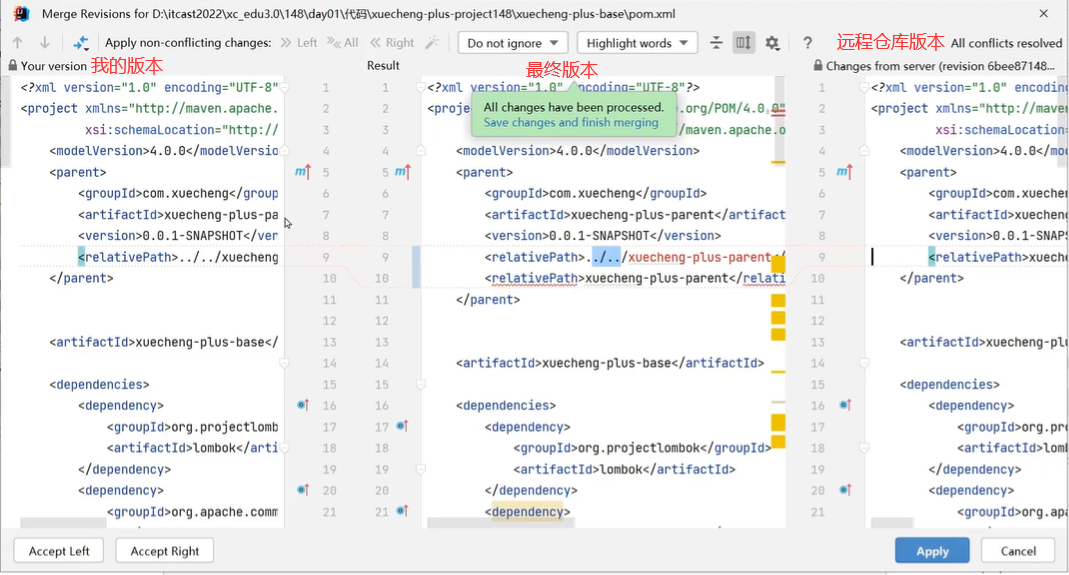
通过代码行修改方式如下:

然后要add将文件添加到暂存区,commit将文件提交,最后push提交到远程仓库。
面试题2:你是在哪个分支开发?
我们不是直接在主分支开发,由技术经理创建独立的开发分支,我们是在独立的开发分支中进行开发,最后由技术经理将开发分支合并到主分支(技术经理对代码进行审查最终合并到主分支)。
1.7 Maven面试 P9
面试题1:Maven指令的作用
mvn clean 清除target目录中的生成结果
mvn compile 编译源代码(生成target目录,然后会有classes文件)

mvn test 执行单元测试
mvn package 打包(打成的jar包会放在target目录)
mvn install 打包并把打好的包上传到本地仓库
mvn deploy 打包并把打好的包上传到远程仓库
面试题2:Maven依赖版本冲突怎么处理?
maven的依赖版本冲突一般是由于间接依赖导致一个jar包有多个不同的版本。比如:A依赖了B的1.0版本,C依赖了B的2.0版本,项目依赖A和C,从而间接依赖了B的1.0和2.0版本,此时B有两个版本引入到了项目中,可能会出现ClassNotFoundException和NoSuchMethodError等错误。
处理版本冲突可以使用以下方法:
1.使用exclusions排除依赖
比如:我们只依赖B的1.0版本,此时可以在依赖C时排除对B的依赖。
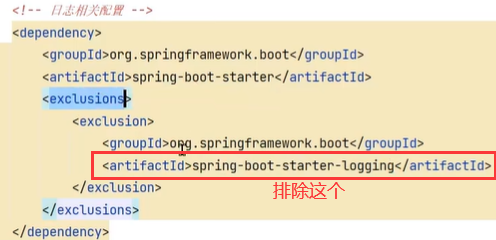
2.使用dependencyManagement锁定版本号
通常在父工程对依赖的版本同一管理
比如:我们只依赖B的1.0版本,此时可以在父工程中限定B的版本为1.0
1.8 数据库环境 P10
数据库用的是虚拟docker容器里的数据库。
数据库用户名:root,密码:mysql。
输入下面启动运行:
systemctl start docker
sh /data/soft/restart.sh
我是在Navicat中对虚拟机中MySQL的连接下新建了一个数据库:

右键表,然后点击运行sql文件,选择下面的xcplus_content.sql这个文件打开,最后可以看到表都加载到了数据库中:
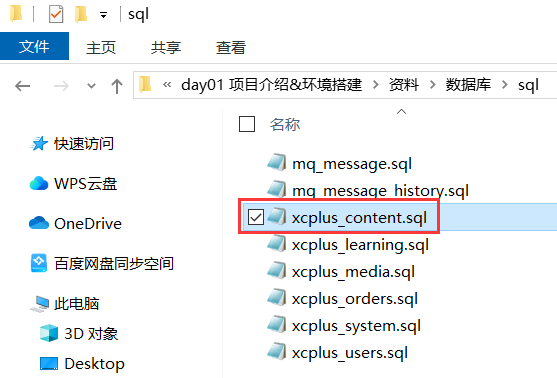
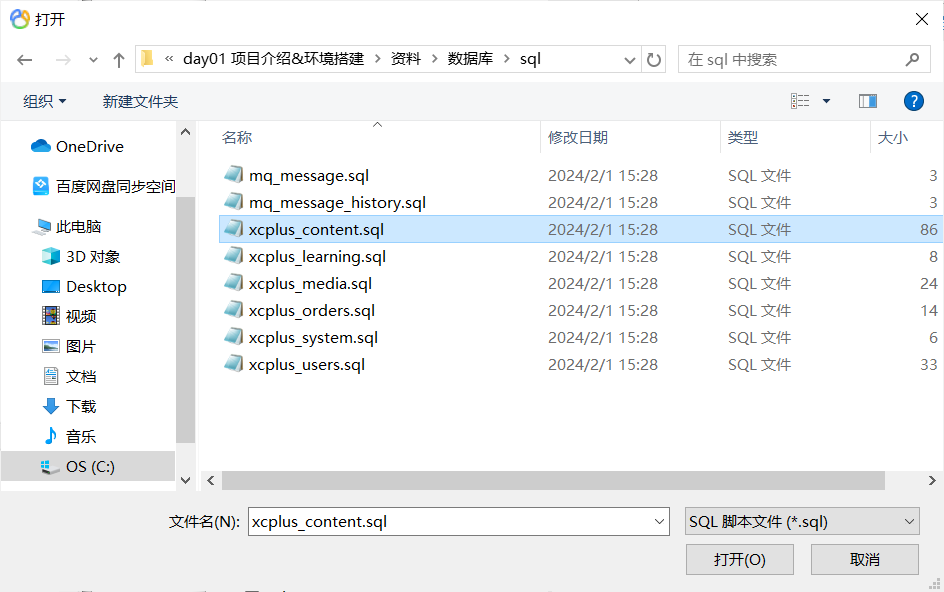
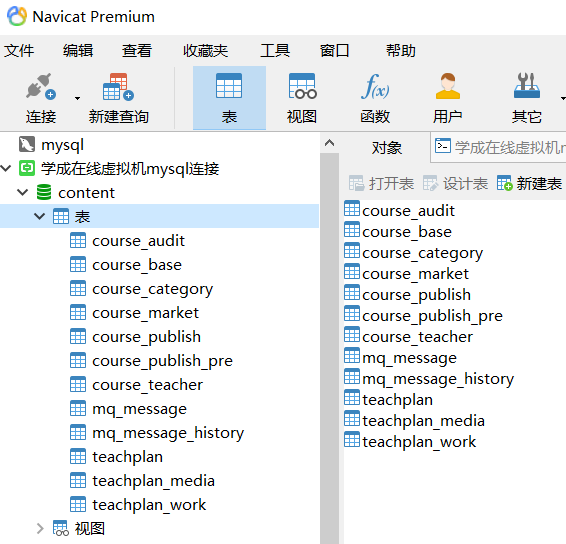
1.9 存储引擎及区别 P11
1.InnoDB(InnoDB用于事务处理,具有ACID事务支持等特性,如果要执行大量insert和update操作,应该选择这个):支持事务。使用的锁颗粒度默认为行级锁,可以支持更高的并发,也可以支持表锁。支持外键约束,外键约束降低了表的查询速度,增加了表之间的耦合度。
2.MyISAM(管理非事务表,提供高速存储和检索以及全文搜索能力):不提供事务支持。只支持表级锁。不支持外键。
3.memory:数据存储在内存中。
1.10 MySQL建表注意 P12
注意选择存储引擎,如果要支持事务需要选择InnoDB。
日期类型如果要记录时分秒选择datetime,只记录年月日使用date;固定长度字符选择char,不固定长度字符varchar(varchar比char节省空间但速度没有char快);对于内容介绍类的长广文本字段使用text或longtext类型;如果存储图片等二进制数据使用blob或longblob类型;对金额字段使用DECIMAL。
如果要存储text、blob字段建议单独建一张表,使用外键关联。
尽量不要定义外键,保证表的独立性,可以存在外键意义的字段。
注意字段的约束,如:非空、唯一、主键等。
1.11 (内容管理)创建工程 P15
这一节具体可以参考day01/资料中的第2章讲义。
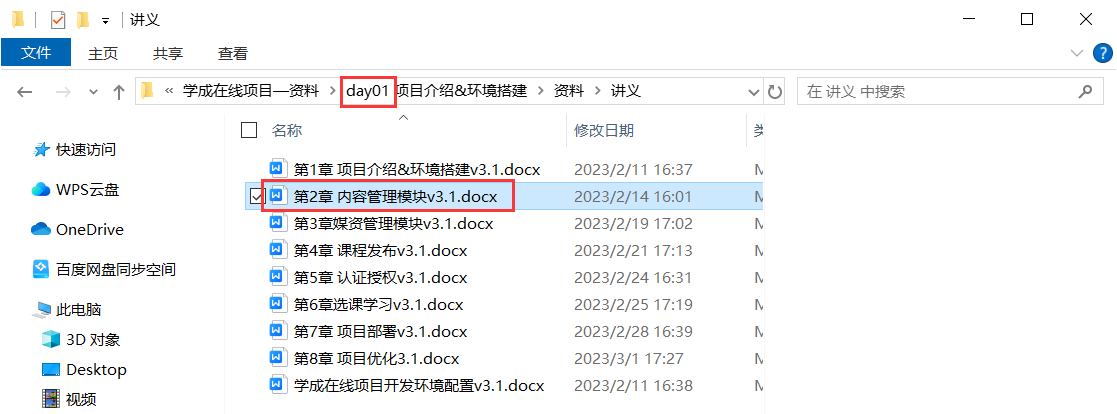
在xuecheng-plus-content下面创建xuecheng-plus-content-api、xuecheng-plus-content-model和xuecheng-plus-content-service这三个模块。
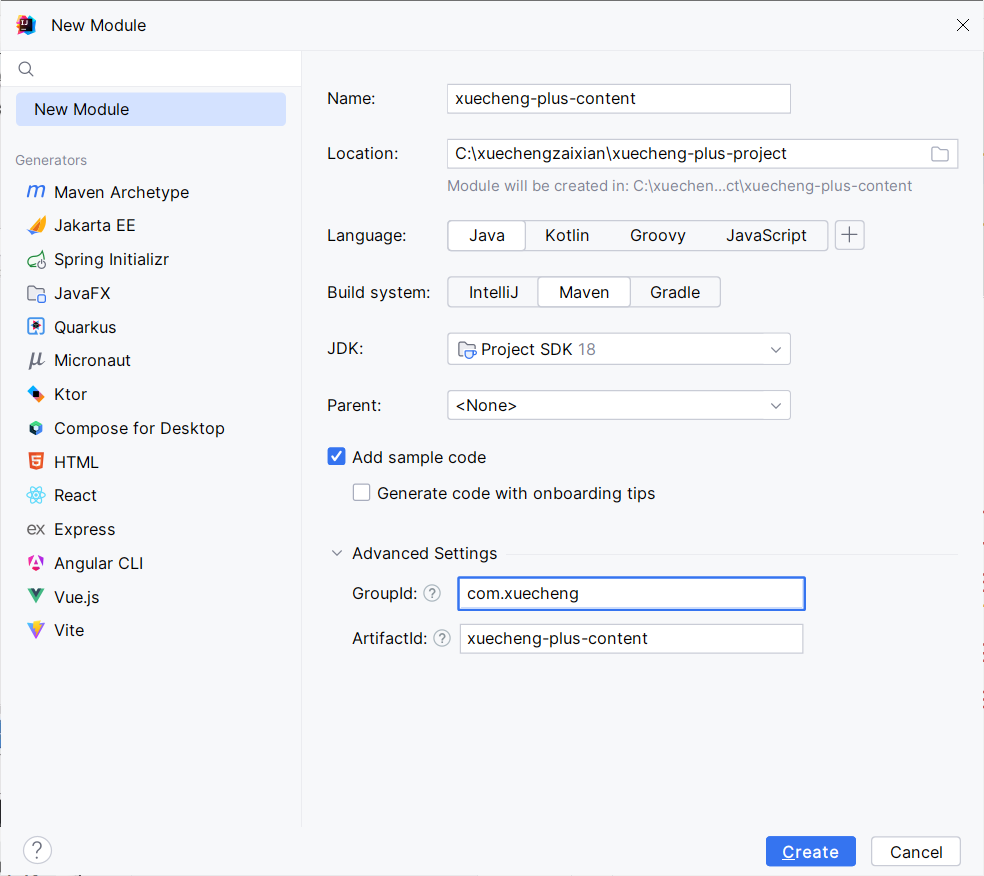
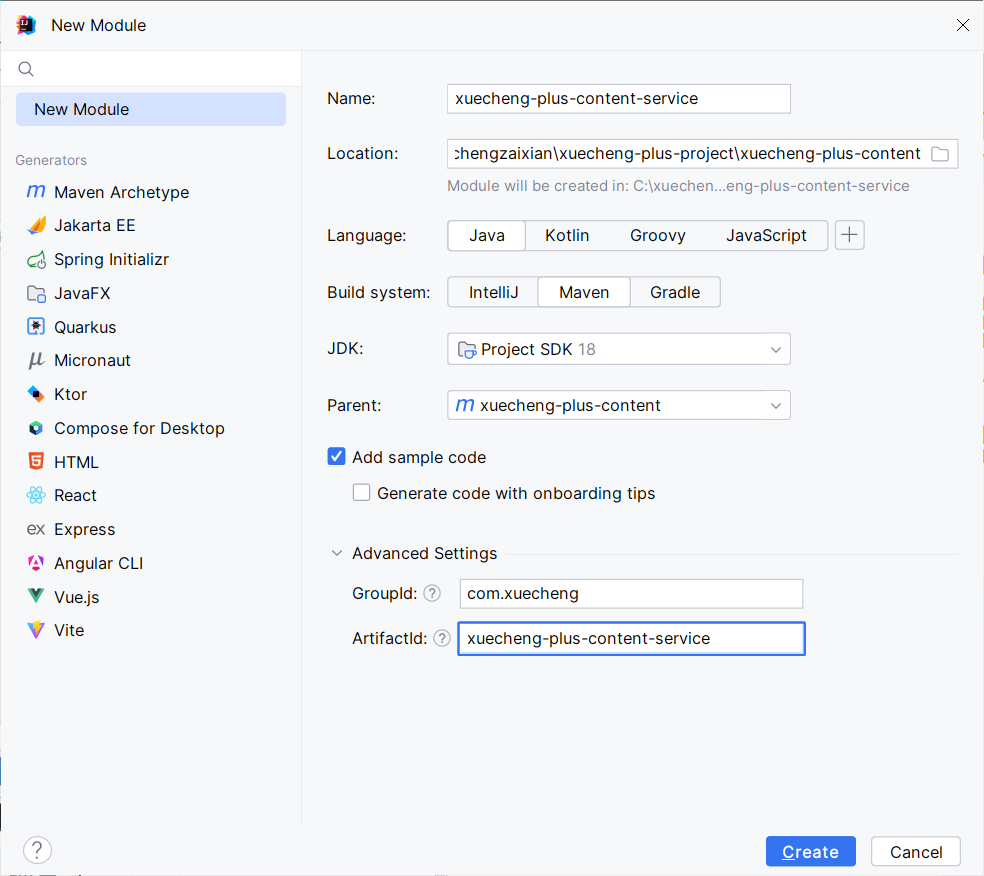
新建的目录结构如下:

模块之间依赖关系如下:

xuecheng-plus-content-model依赖xuecheng-plus-base。
xuecheng-plus-content-service依赖xuecheng-plus-model。
xuecheng-plus-content-api依赖xuecheng-plus-content-service。因为看图,api依赖service也依赖model,但因为service依赖model,所以api如果依赖了service变相也依赖了model。
xuecheng-plus-content-model的pom.xml文件:
<?xml version="1.0" encoding="UTF-8"?>
<project xmlns="http://maven.apache.org/POM/4.0.0" xmlns:xsi="http://www.w3.org/2001/XMLSchema-instance"
xsi:schemaLocation="http://maven.apache.org/POM/4.0.0 https://maven.apache.org/xsd/maven-4.0.0.xsd">
<modelVersion>4.0.0</modelVersion>
<parent>
<artifactId>xuecheng-plus-content</artifactId>
<groupId>com.xuecheng</groupId>
<version>0.0.1-SNAPSHOT</version>
</parent>
<artifactId>xuecheng-plus-content-model</artifactId>
<dependencies>
<dependency>
<groupId>com.xuecheng</groupId>
<artifactId>xuecheng-plus-base</artifactId>
<version>0.0.1-SNAPSHOT</version>
</dependency>
</dependencies>
</project>
xuecheng-plus-content-service的pom.xml文件:
<?xml version="1.0" encoding="UTF-8"?>
<project xmlns="http://maven.apache.org/POM/4.0.0" xmlns:xsi="http://www.w3.org/2001/XMLSchema-instance"
xsi:schemaLocation="http://maven.apache.org/POM/4.0.0 https://maven.apache.org/xsd/maven-4.0.0.xsd">
<modelVersion>4.0.0</modelVersion>
<parent>
<artifactId>xuecheng-plus-content</artifactId>
<groupId>com.xuecheng</groupId>
<version>0.0.1-SNAPSHOT</version>
</parent>
<artifactId>xuecheng-plus-content-service</artifactId>
<dependencies>
<dependency>
<groupId>com.xuecheng</groupId>
<artifactId>xuecheng-plus-content-model</artifactId>
<version>0.0.1-SNAPSHOT</version>
</dependency>
</dependencies>
</project>
xuecheng-plus-content-api的pom.xml文件:
<?xml version="1.0" encoding="UTF-8"?>
<project xmlns="http://maven.apache.org/POM/4.0.0" xmlns:xsi="http://www.w3.org/2001/XMLSchema-instance"
xsi:schemaLocation="http://maven.apache.org/POM/4.0.0 https://maven.apache.org/xsd/maven-4.0.0.xsd">
<modelVersion>4.0.0</modelVersion>
<parent>
<artifactId>xuecheng-plus-content</artifactId>
<groupId>com.xuecheng</groupId>
<version>0.0.1-SNAPSHOT</version>
</parent>
<artifactId>xuecheng-plus-content-api</artifactId>
<dependencies>
<dependency>
<groupId>com.xuecheng</groupId>
<artifactId>xuecheng-plus-content-service</artifactId>
<version>0.0.1-SNAPSHOT</version>
</dependency>
</dependencies>
</project>
二、课程模块开发
2.1 课程查询 需求分析 P16
操作流程(一步一步要怎么操作)就是业务流程,然后弄清在操作流程中需要哪些数据。
2.2 课程查询 生成PO类 P17
具体的搭建步骤可以看资料中下面这个文件里的内容:
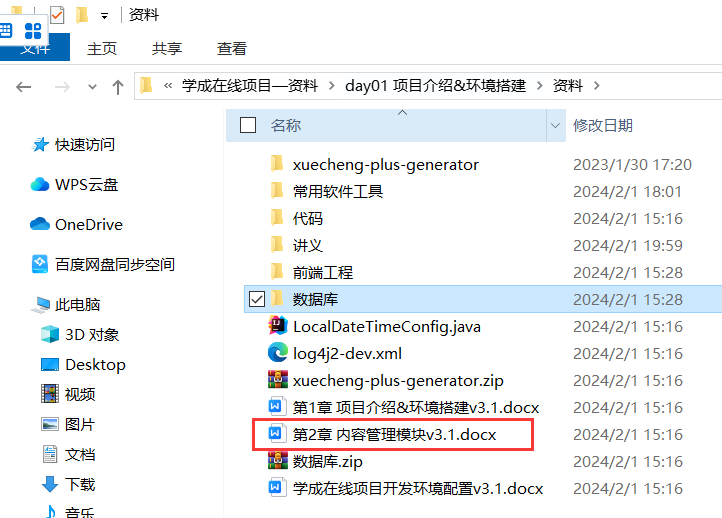
course_base文件是课程基本信息文件。
表结构如下。
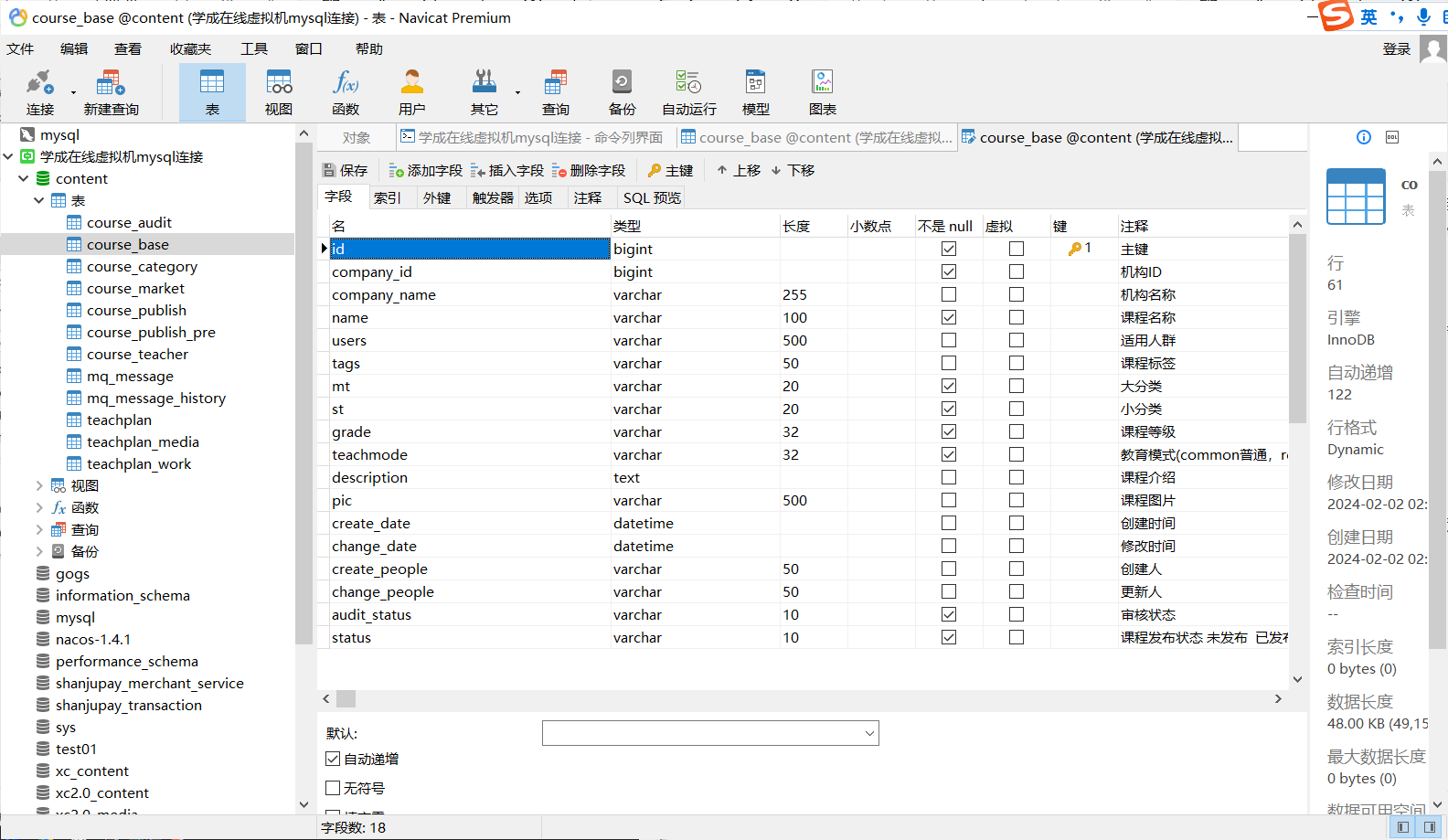
首先把xuecheng-plus-generator这个代码生成器解压出来,然后放到xuecheng-plus-project这个总工程下面。
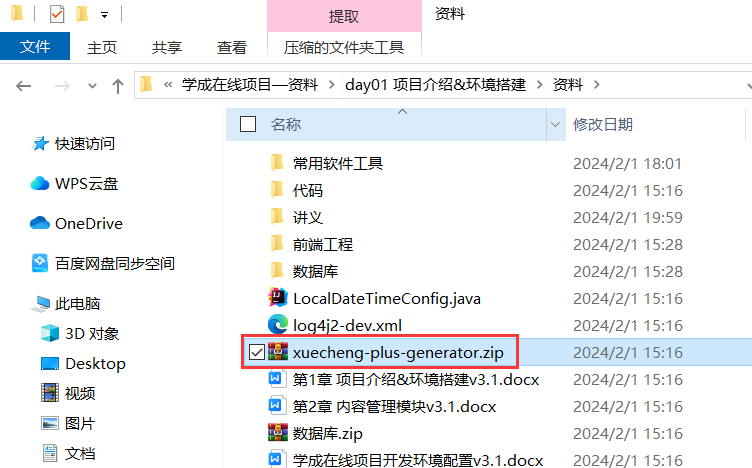
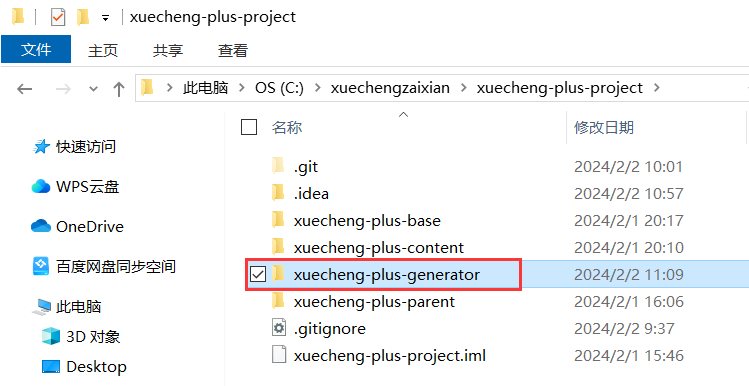
此时该模块还是灰色的,右键pom.xml然后点击Add as Maven Project,可以使其变成maven工程。
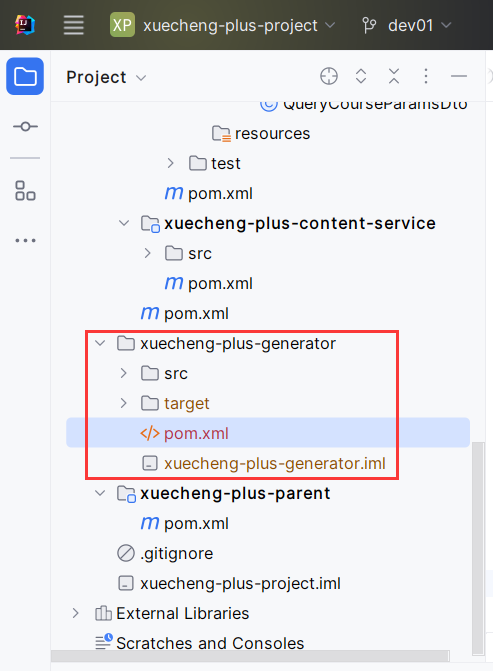
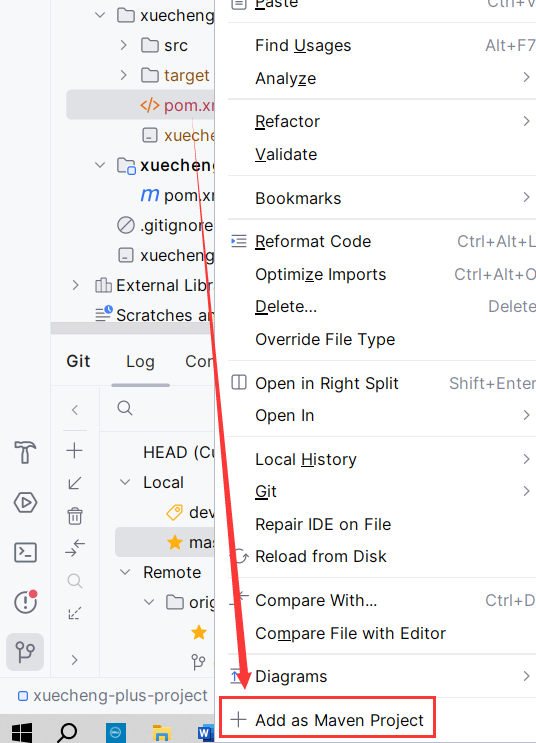
修改generator下的ContentCodeGenerator类:

修改下面数据的连接配置,像我的表叫content,可以去掉前面xc402:

先把java下面的content删掉,然后运行ContentCodeGenerator的main方法:
main方法执行完后,可以看到生成了content包,model下面有po类。把po下面的所有po类复制粘贴到xuecheng-plus-content-model下的po包中:
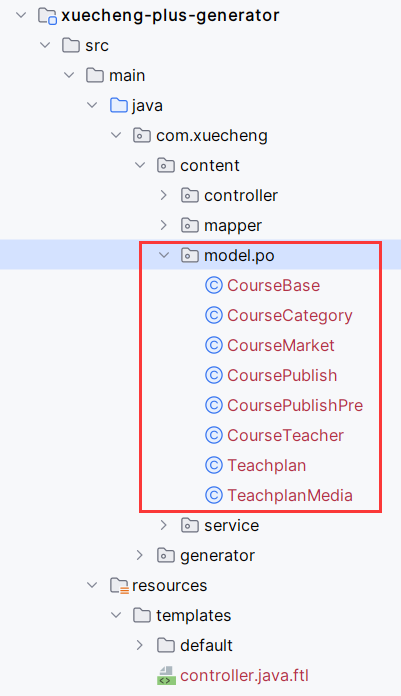
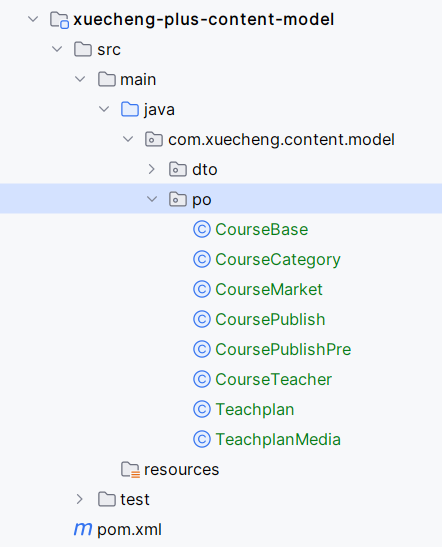
发现有一些报错,主要的原因是缺乏了依赖。
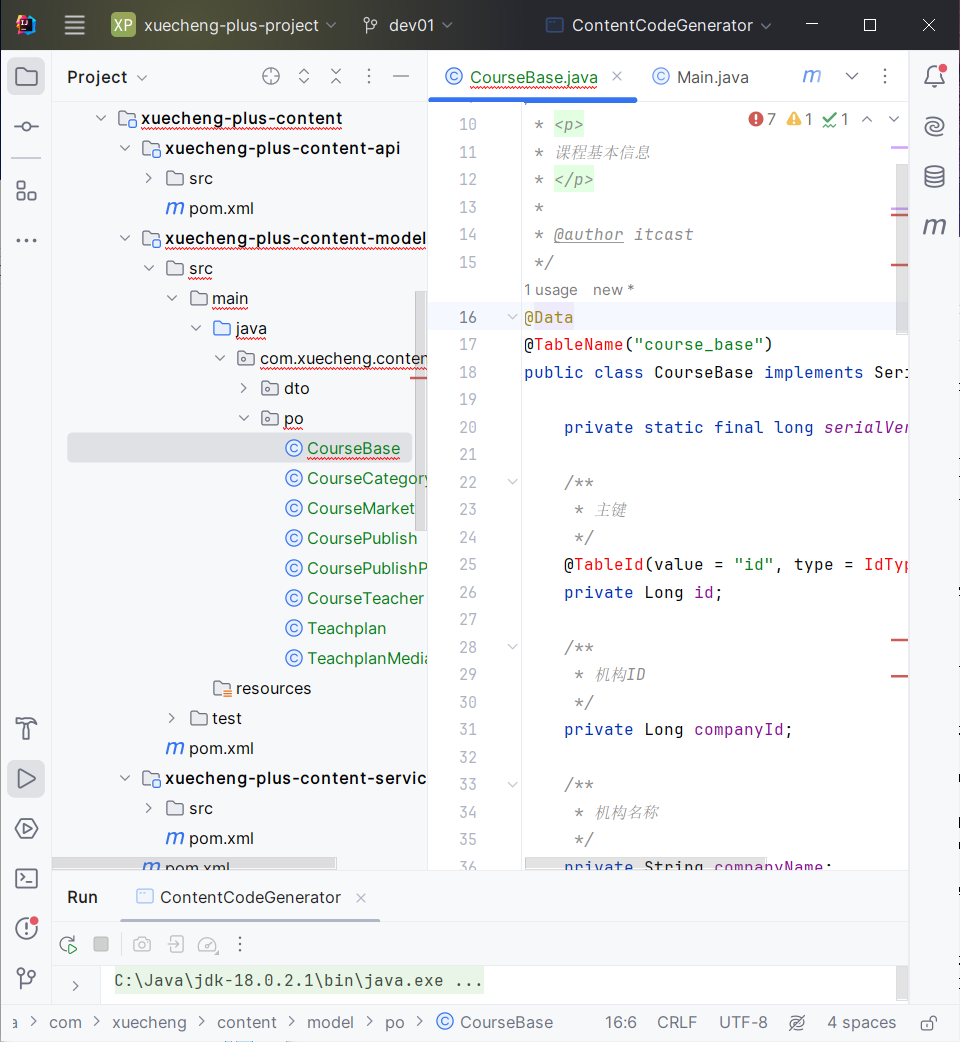
可以加入如下的依赖到model模块的pom.xml文件中:
<!--存在mybatisplus注解添加相关注解保证不报错-->
<dependency>
<groupId>com.baomidou</groupId>
<artifactId>mybatis-plus-annotation</artifactId>
<version>${mybatis-plus-boot-starter.version}</version>
</dependency>
<dependency>
<groupId>com.baomidou</groupId>
<artifactId>mybatis-plus-core</artifactId>
<version>${mybatis-plus-boot-starter.version}</version>
</dependency>
<dependency>
<groupId>org.projectlombok</groupId>
<artifactId>lombok</artifactId>
</dependency>
现在就不会报错了:
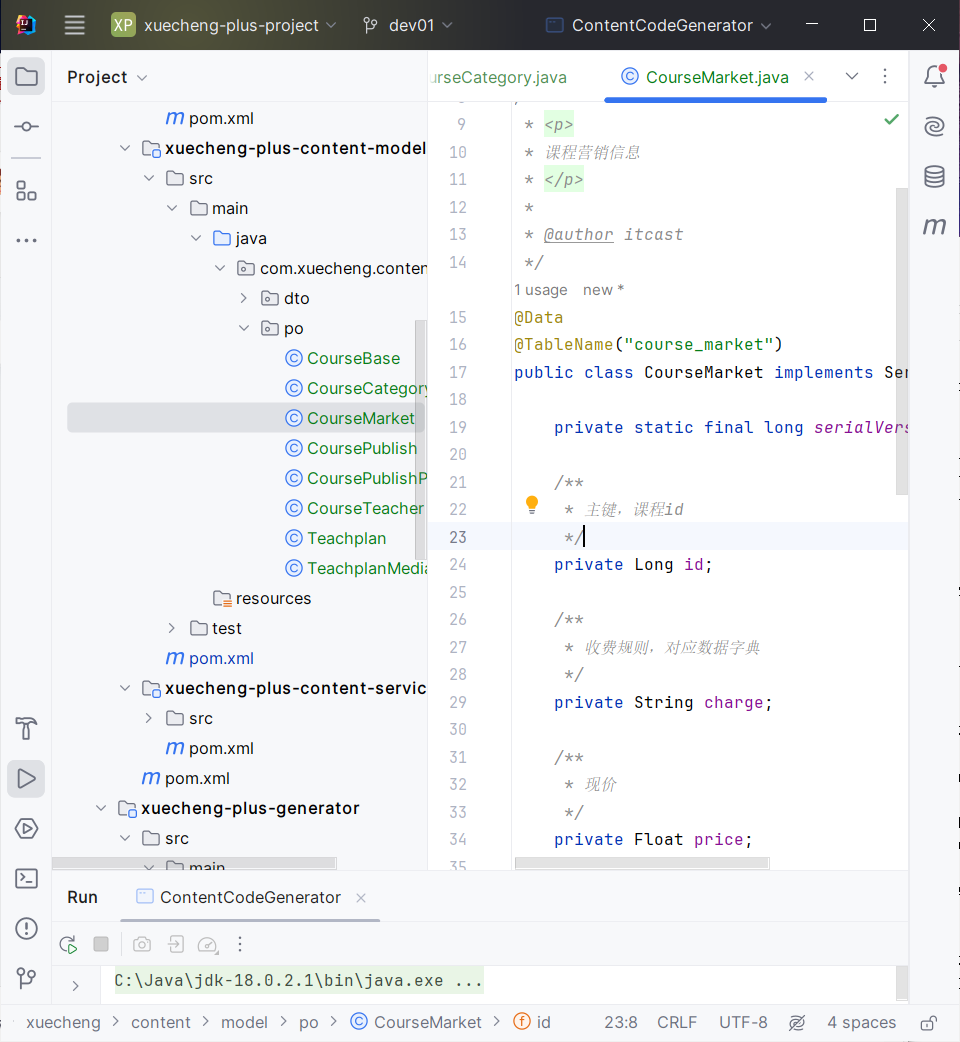
2.3 课程查询 设计分析 P18
2.4 课程查询 接口定义 P19
该节内容可以参考下面的文档进行配置,所以我只罗列关键步骤。
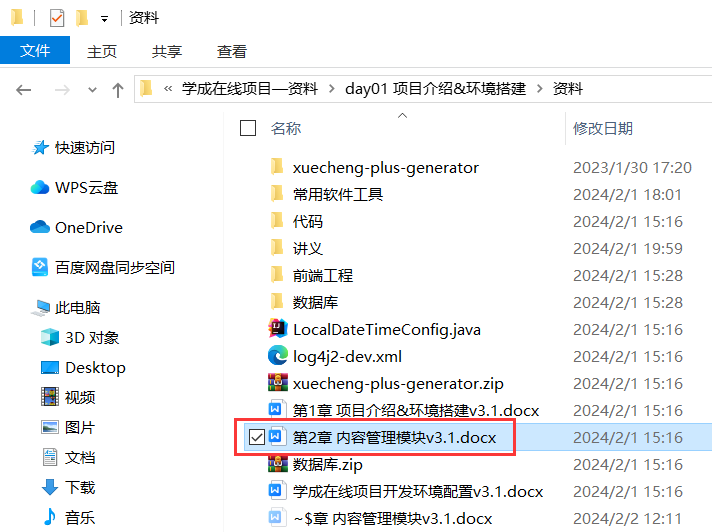
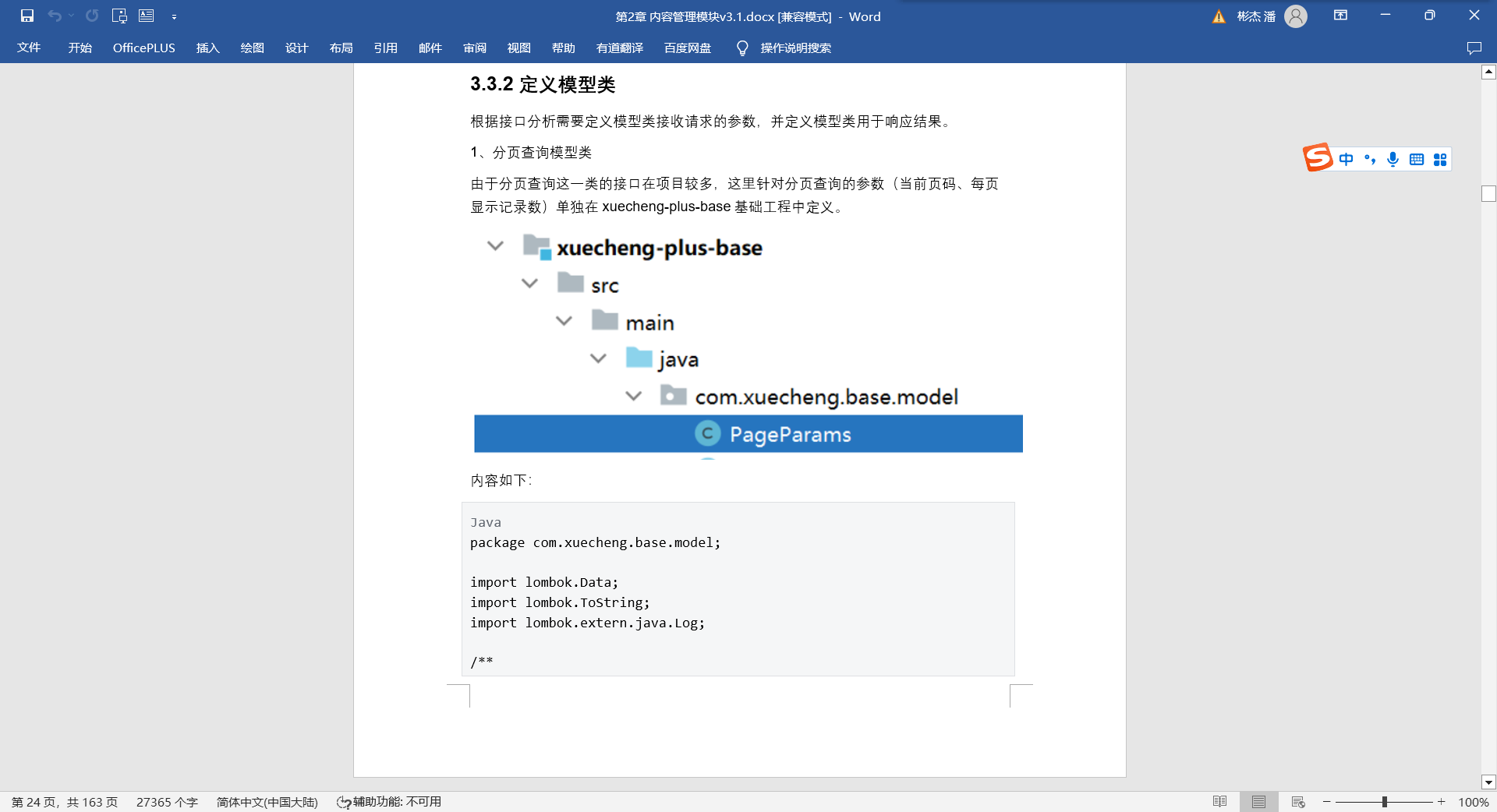
第1步:定义分页查询模型类。在xuecheng-plus-base下面的src\main\java\com\xuecheng\base\model下面创建PageParams类,写入代码。
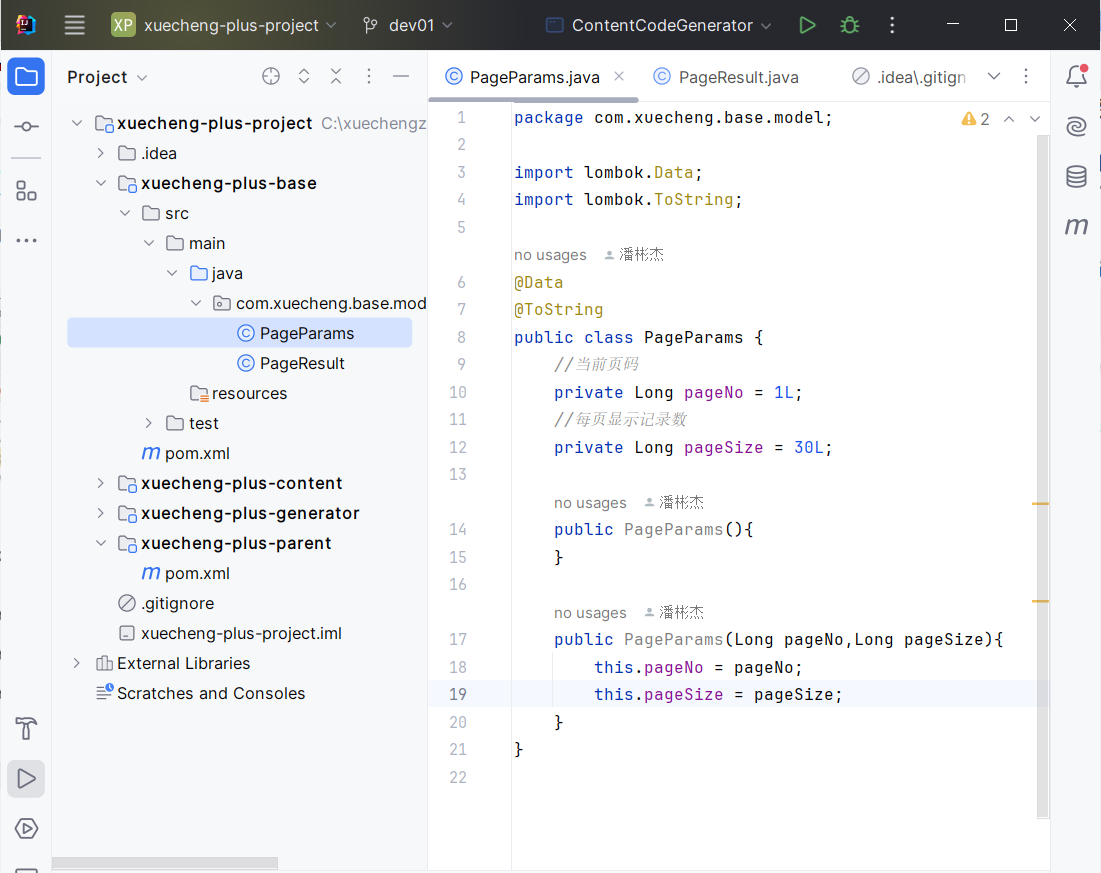
第2步:定义条件模型类。在xuecheng-plus-content/xuecheng-plus-content-model下面src/main/java/com/xuecheng/content/model下创建dto包,创建QueryCourseParamsDto类:
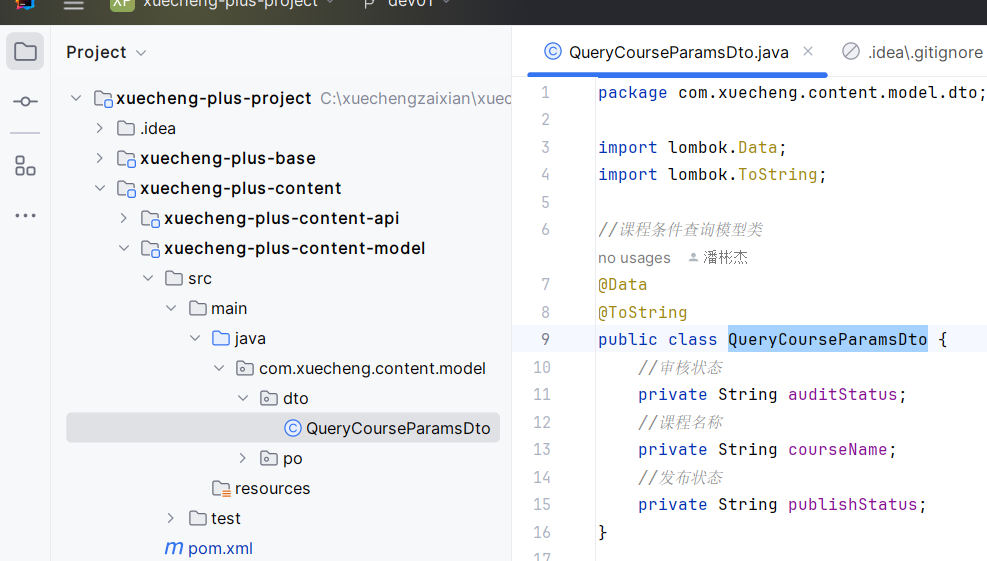
第3步:定义响应模型类。
PageResult分为2部分,1部分是数据,另1部分是分页信息。
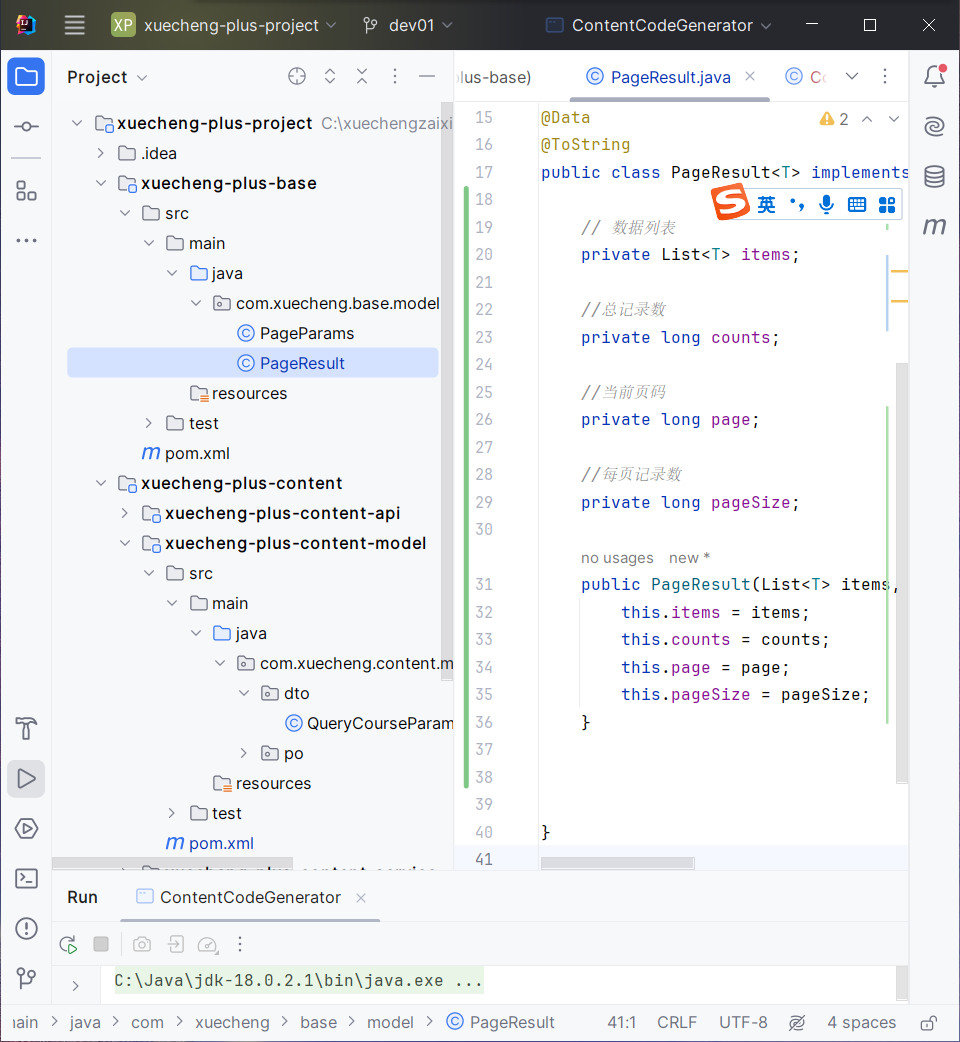
第4步:把依赖放到xuecheng-plus-content-api的pom.xml中
详细请见文档:
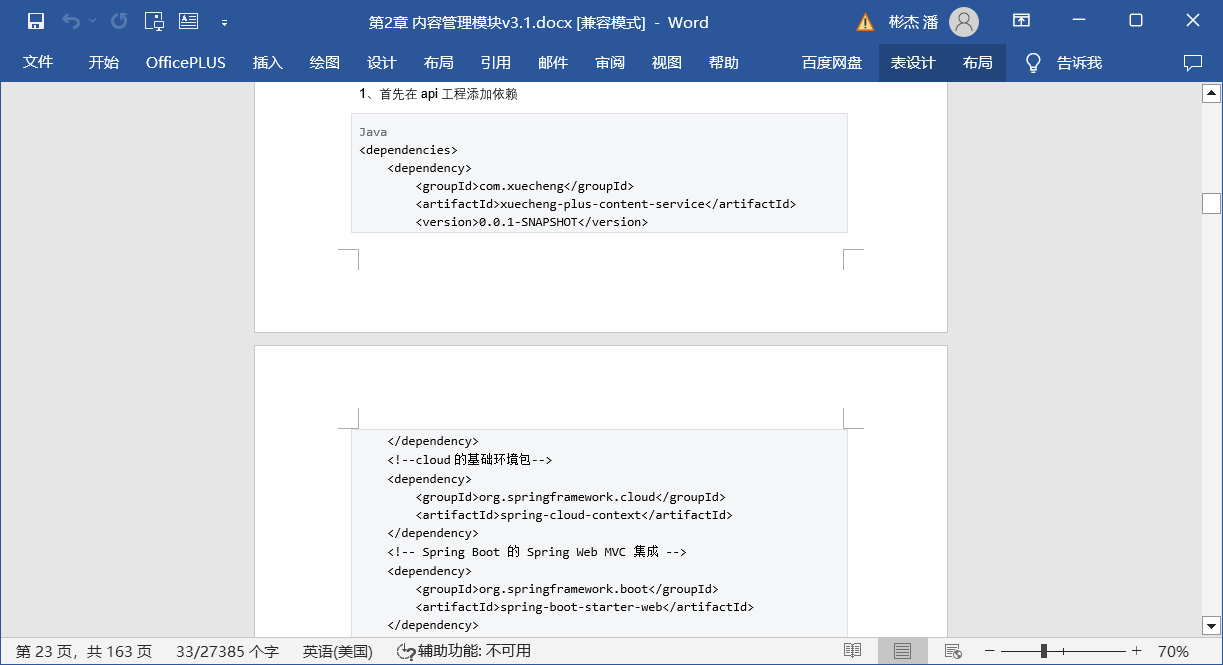

我个人导入的时候cloud的基础环境包有点问题,然后我修改了<parent>里面的代码:
第5步:在xuecheng-plus-content-api的com/xuecheng下面创建content/api,然后创建一个CourseBaseInfoController类:
@RestController
public class CourseBaseInfoController {
@RequestMapping("/course/list")
public PageResult<CourseBase> list(PageParams pageParams,@RequestBody QueryCourseParamsDto queryCourseParamsDto){
return null;
}
}第6步:在xuecheng-plus-content-api的com/xuecheng下面创建ContentApplication启动类,注意这个类一定是要在xucheng下面(不要放到content下)。
@SpringBootApplication
public class ContentApplication {
public static void main(String[] args){
SpringApplication.run(ContentApplication.class,args);
}
}log4j2-dev.xml在下面的位置,粘贴到下面位置:
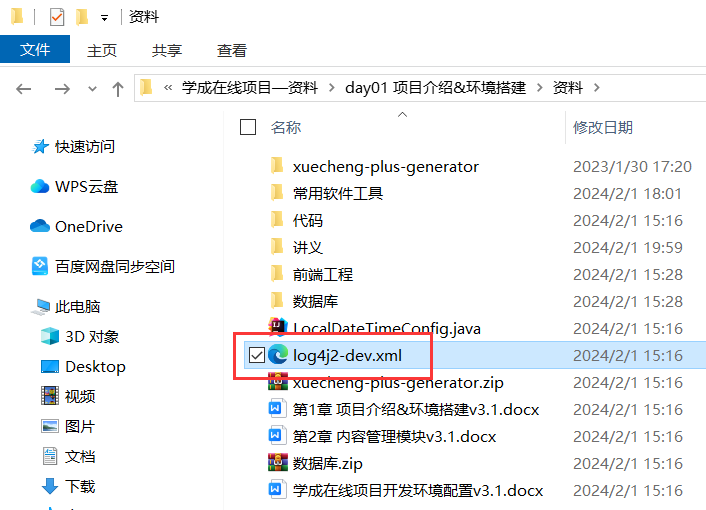
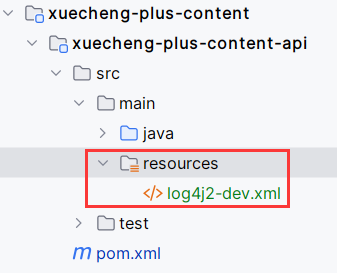
在xuecheng-plus-content的xuecheng-plus-content-api下面的resources下创建bootstrap.yml文件,然后写入如下代码,注意把url中端口后的数据库名称改成自己的:

点击启动类中下面按钮启动项目:

重点:请求localhost:63040/content/course/list出现的是下面的情况(政策现象):

请求的数据和接口不匹配,加上pageNo和pageSize仍旧不行。
![]()
localhost:63040/content/course/list?pageNo=1&pageSize=30是因为第二个参数要接受json数据转化为Java对象,而现在没有这个json数据。
![]()
@RequestBody这个注解对参数的要求为true,因此不行。修改方式如下给@RequestBody加一个required=false。
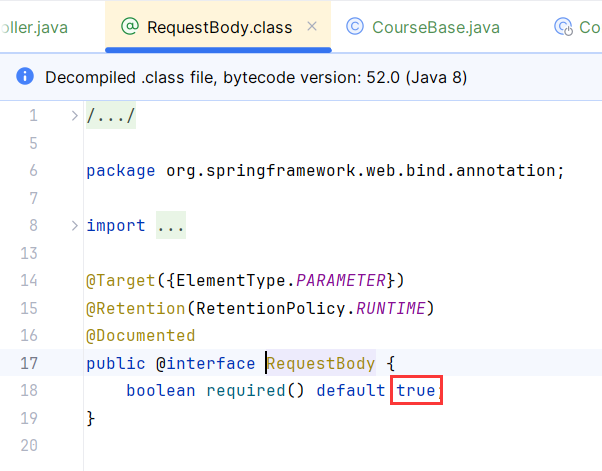

现在再请求就没有任何问题了:

控制台也显示成功:

前端和controller层间用vo传递数据,controller和service层间用DTO传输数据,service和dao层间用po传输数据。

如果有多个前端,比如手机、PC,传入的参数个数不同,就需要有VO(避免让负责手机前端的工程师误认为有5个参数),比如VO1对应手机是3个参数,VO2对应PC是5个参数。如果没有多个前端,就只有1个前端,那就只需要用DTO即可,不需要VO。

2.5 课程查询 swagger P20
swagger可以在线生成接口文档。
首先加入swagger依赖(之前已加完),然后要在配置文件bootstrap.yml中进行配置:
swagger:
title: "学成在线内容管理系统"
description: "内容系统管理系统对课程相关信息进行管理"
base-package: com.xuecheng.content
enabled: true
version: 1.0.0在启动类上加@EnableSwagger2Doc注解
然后重启项目
在浏览器中输入:localhost:63040/content/swagger-ui.html,然后可以看到如下的界面:

在类上加@Api注解,在方法上加@ApiOperation接口,把@RequestMapping改成@PostMapping:
@Api(value="课程信息管理接口",tags="课程信息管理接口")
@RestController
public class CourseBaseInfoController {
@ApiOperation("课程查询接口")
@PostMapping("/course/list")
public PageResult<CourseBase> list(PageParams pageParams,@RequestBody(required=false) QueryCourseParamsDto queryCourseParamsDto){
return null;
}
}效果如下:
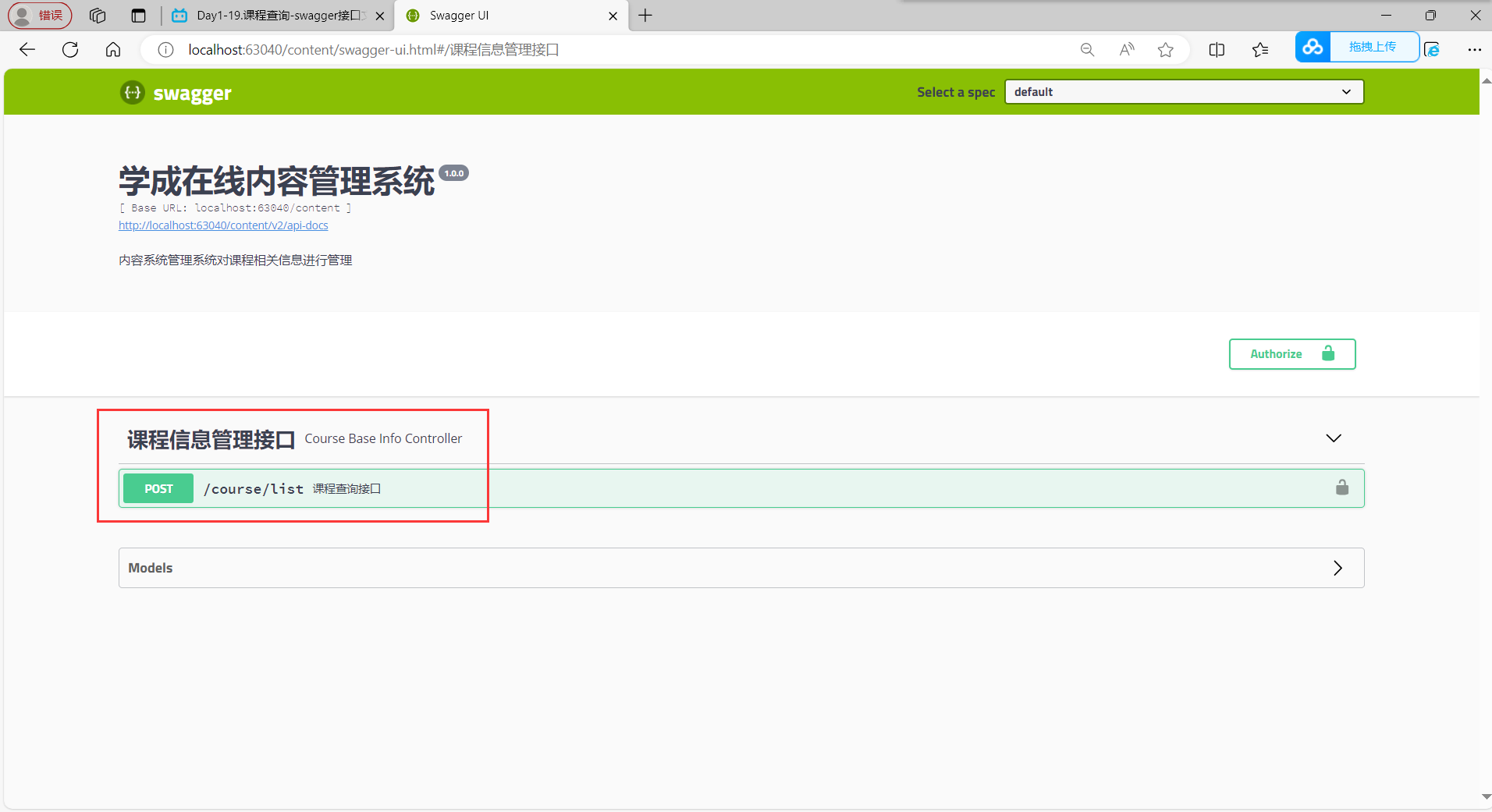
@ApiModelProperty可以加在属性上,用来给属性备注名称。

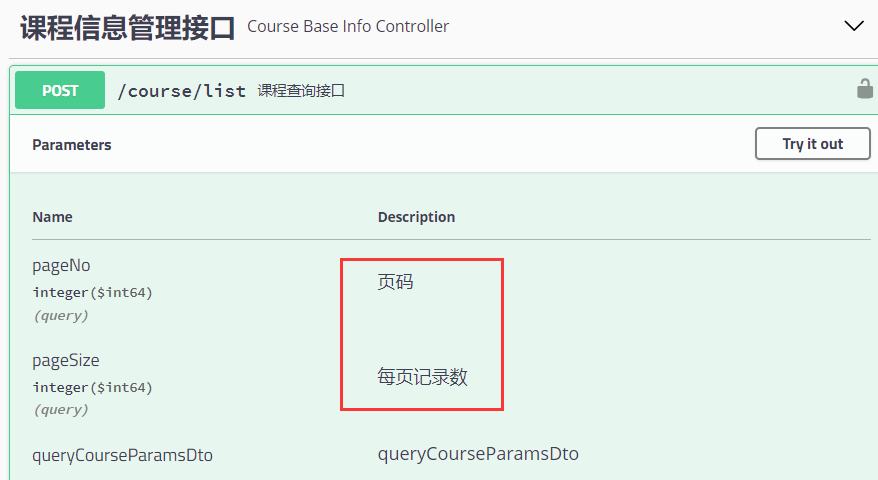
swagger里还可以进行接口测试

但发现日期不太好看
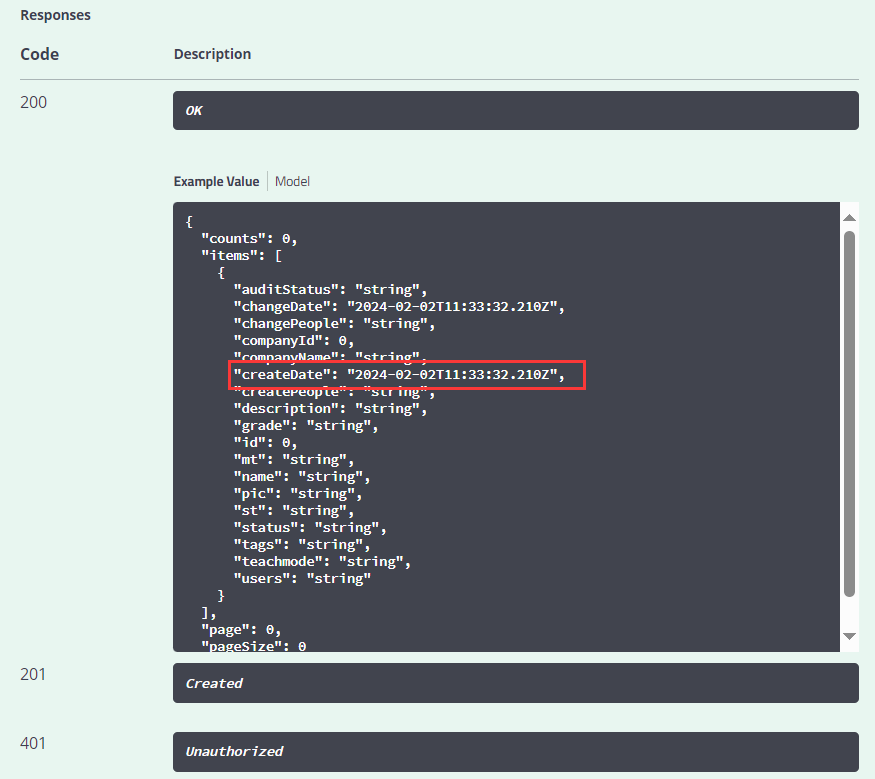
可以直接从下面这个文件中取出LocalDateTimeConfig这个工具类:


然后放到如下的位置:
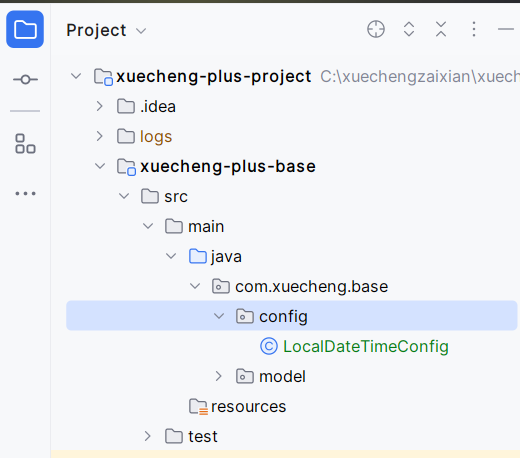
重启项目,重新测试:
2.6 SpringBoot常用注解 P21
@ResponseBody : 将数据以json的格式响应给前端(侧重返回,定义在类上)
@RequestBody :将json数据转化为java对象(侧重接收,定义在方法上)
@PathVariable : 接收请求路径中占位符的值
![]()
@Autowired:是基于类型的注入。
@Resource:基于名称注入。
2.7 项目开发流程 P22
1.产品人员设计产品原型。
2.讨论需求。
3.分模块设计接口。
4.出接口文档。
5.将接口文档给到前端人员,前后端分离开发。
6.开发完毕进行测试。
7.测试完毕发布项目,由运维人员进行部署安装。
2.8 课程查询 DAO接口 P23
前后端分离开发,先定义controller层的接口,生成接口文档,然后再前后端一起开发。
要从底层开始写,从持久层开始写。
在xuecheng-plus-content-service下面的com/xuecheng下面创建content包,在content下创建mapper包。
然后把xuecheng-plus-generator下的com/xuecheng/content/mapper下的所有文件拷贝到上面service的mapper包下。
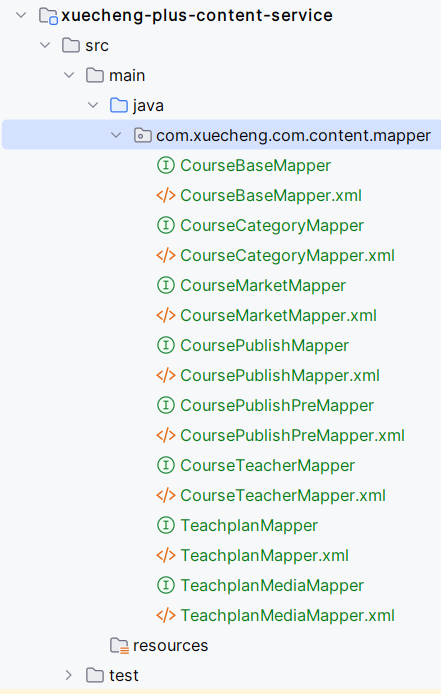
然后要进行单元测试,首先把xuecheng-plus-content-service的依赖补全,把如下这些依赖复制粘贴到service:

在service的test下创建resources:
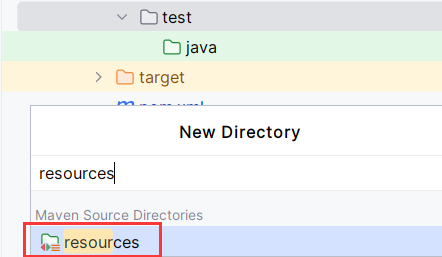
把api模块定义的2个配置文件,拷贝到service模块:
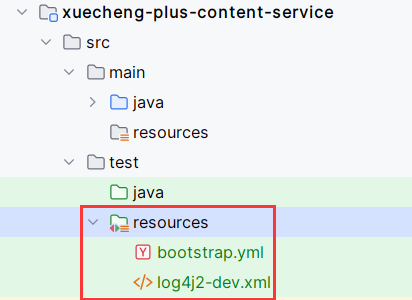
配置文件只需要像下面这样:
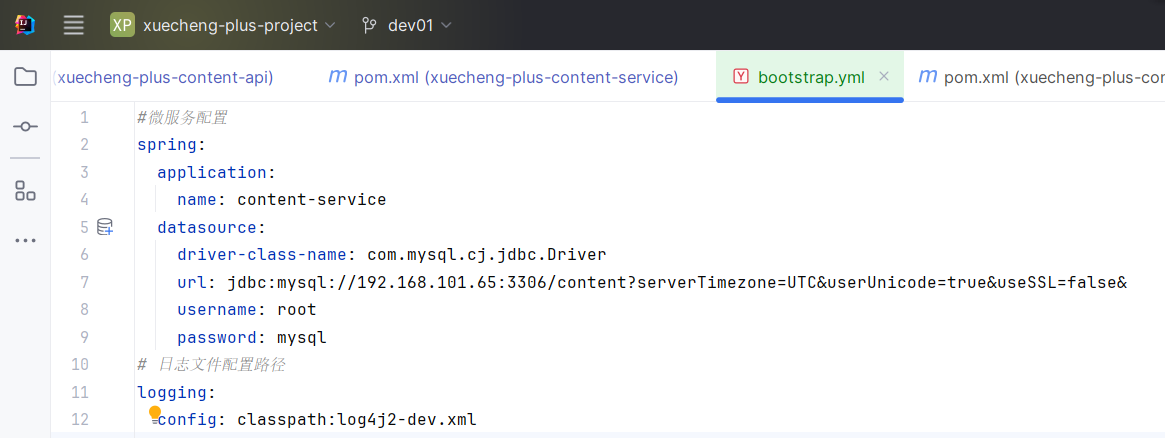
在service的test/java下创建com/xuecheng包,然后把api的启动类拷贝到com/xuecheng下,删掉生成接口文档的注解:

分页插件会自动加limit语句
分页插件的原理:分页参数会放到ThreadLocal中,mybatis plus有一个拦截器,可以拦截执行的sql,根据数据库类型添加对应的分页语句重写sql,在末尾拼加limit。
在xuecheng-plus-content-service的java/com/xuecheng/content下创建一个config包,然后创建MybatisPlusConfig类,把代码都写入进去:
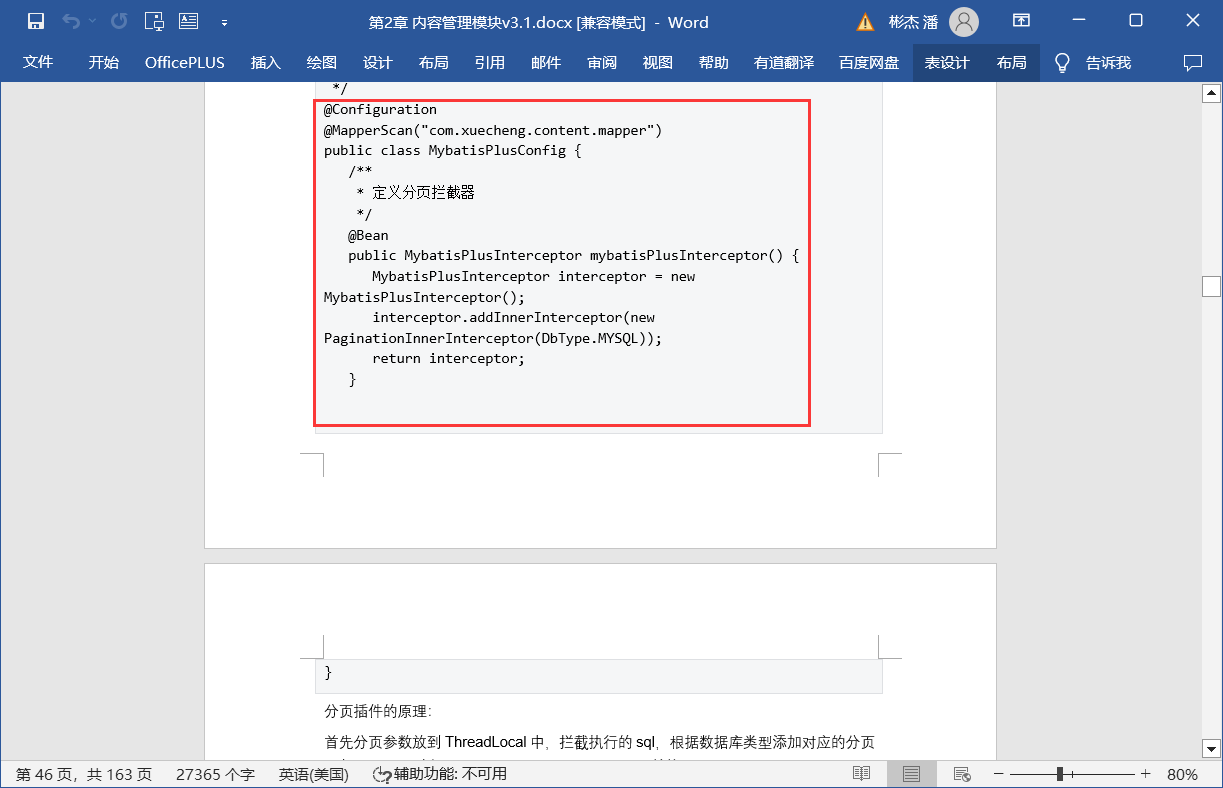
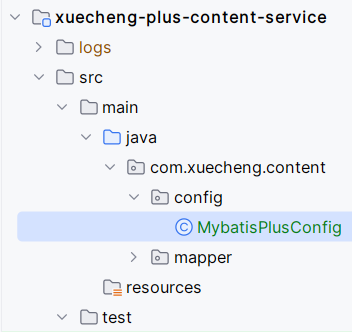
在service模块的test/java/com/xuecheng/content下创建CourseBaseMapperTests,写入如下内容:
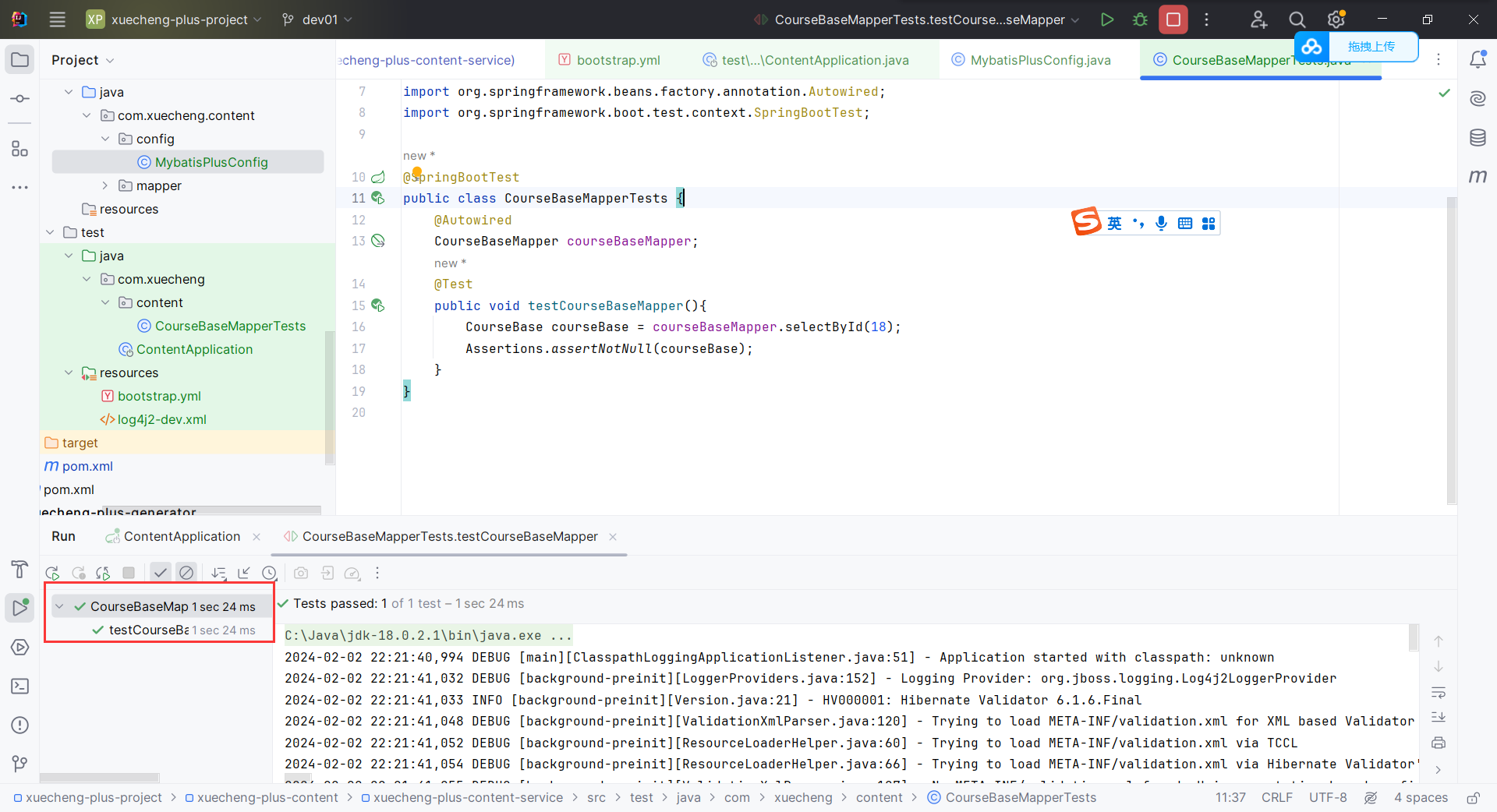
如果左侧为绿√,代表测试通过,也可以打个断点看看:

CourseBaseMapperTests代码如下:
@SpringBootTest
public class CourseBaseMapperTests {
@Autowired
CourseBaseMapper courseBaseMapper;
@Test
public void testCourseBaseMapper(){
CourseBase courseBase = courseBaseMapper.selectById(18);
Assertions.assertNotNull(courseBase);
//详细进行分页查询的单元测试
//查询条件
QueryCourseParamsDto courseParamsDto = new QueryCourseParamsDto();
courseParamsDto.setCourseName("java"); //课程名称查询条件
//拼装查询条件
LambdaQueryWrapper<CourseBase> queryWrapper = new LambdaQueryWrapper<>();
//根据名称模糊查询.在sql中拼接course_base.name like '%值%'
queryWrapper.like(StringUtils.isNotEmpty(courseParamsDto.getCourseName()),CourseBase::getName,courseParamsDto.getCourseName());
//根据课程审核状态查询 course_base.audit_status= ?
queryWrapper.eq(StringUtils.isNotEmpty(courseParamsDto.getAuditStatus()),CourseBase::getAuditStatus,courseParamsDto.getAuditStatus());
//分页参数对象
PageParams pageParams = new PageParams();
pageParams.setPageNo(1L);
pageParams.setPageSize(2L);
//创建page分页参数对象,参数:当前页码,每页记录数。
Page<CourseBase> page = new Page<>(pageParams.getPageNo(), pageParams.getPageSize());
//开始进行分页查询
Page<CourseBase> pageResult = courseBaseMapper.selectPage(page, queryWrapper);
//数据列表
List<CourseBase> items = pageResult.getRecords();
//总记录数
long total = pageResult.getTotal();
//List<T> items,long counts,long page,long pageSize
PageResult<CourseBase> courseBasePageResult = new PageResult<CourseBase>(items,total,pageParams.getPageNo(),pageParams.getPageSize());
System.out.println(courseBasePageResult);
}
}在末尾打上断点,进行断点调试:

看一下是否有LIMIT语句:

看一下结果数据是否完整:

如果觉得数据有问题可以把SQL语句复制到Navicat中,然后把参数逐一替换问号,进行执行、

2.9 数据字典表 P24
下拉框的文字来源于数据字典表,方便前端进行修改替换展示。

数据字典由code编码和文字组成,通过编码来指代文字。
在Navicat中创建一个新的数据库,xc_system,uff8mb4_general_ci。然后执行.sql文件,全称是xcplus_system.sql。

虚拟机里面的Mysql已经有了这个数据库,名字叫作xcplus-system,所以我们不用创建,只需要知道流程。
2.10 (课程查询)service P25
在xuecheng-plus-base的xuecheng-plus-content-service下的src/main/java/com/xuecheng/content下创建service包,在service包下创建CourseBaseInfoService接口,写入如下代码:
//课程信息管理接口
public interface CourseBaseInfoService {
/**
* 课程分页查询
* @param pageParams 分页查询参数
* @param queryCourseParamsDto 查询条件
* @return 查询结果
*/
public PageResult<CourseBase> queryCourseBaseList(PageParams pageParams, QueryCourseParamsDto queryCourseParamsDto);
}再在service包下创建impl包,在impl包下创建实现类CourseBaseInfoServiceImpl,写入如下代码(注意一定要把return null改过了):
@Slf4j
@Service
public class CourseBaseInfoServiceImpl implements CourseBaseInfoService {
@Autowired
CourseBaseMapper courseBaseMapper;
@Override
public PageResult<CourseBase> queryCourseBaseList(PageParams pageParams, QueryCourseParamsDto courseParamsDto) {
//拼装查询条件
LambdaQueryWrapper<CourseBase> queryWrapper = new LambdaQueryWrapper<>();
//根据名称模糊查询.在sql中拼接course_base.name like '%值%'
queryWrapper.like(StringUtils.isNotEmpty(courseParamsDto.getCourseName()),CourseBase::getName,courseParamsDto.getCourseName());
//根据课程审核状态查询 course_base.audit_status= ?
queryWrapper.eq(StringUtils.isNotEmpty(courseParamsDto.getAuditStatus()),CourseBase::getAuditStatus,courseParamsDto.getAuditStatus());
//创建page分页参数对象,参数:当前页码,每页记录数。
Page<CourseBase> page = new Page<>(pageParams.getPageNo(), pageParams.getPageSize());
//开始进行分页查询
Page<CourseBase> pageResult = courseBaseMapper.selectPage(page, queryWrapper);
//数据列表
List<CourseBase> items = pageResult.getRecords();
//总记录数
long total = pageResult.getTotal();
//List<T> items,long counts,long page,long pageSize
PageResult<CourseBase> courseBasePageResult = new PageResult<CourseBase>(items,total,pageParams.getPageNo(),pageParams.getPageSize());
return courseBasePageResult;
}
}然后要进行单元测试,复制service模块test下原有的CourseBaseMapperTests粘贴到自己的路径下,然后改名为CourseBaseInfoServiceTests,写入如下代码:
@SpringBootTest
public class CourseBaseInfoServiceTests {
@Autowired
CourseBaseInfoService courseBaseInfoService;
@Test
public void testCourseBaseInfoService(){
//查询条件
QueryCourseParamsDto courseParamsDto = new QueryCourseParamsDto();
courseParamsDto.setCourseName("java"); //课程名称查询条件
courseParamsDto.setAuditStatus("202004");
//分页参数对象
PageParams pageParams = new PageParams();
pageParams.setPageNo(1L);
pageParams.setPageSize(2L);
PageResult<CourseBase> courseBasePageResult = courseBaseInfoService.queryCourseBaseList(pageParams, courseParamsDto);
System.out.println(courseBasePageResult);
}
}
看一下控制台输出没太大问题:

2.11 (课程查询)接口测试 P26
完善xuecheng-plus-content-api下的CourseBaseInfoController的代码:
@Api(value="课程信息管理接口",tags="课程信息管理接口")
@RestController
public class CourseBaseInfoController {
@Autowired
CourseBaseInfoService courseBaseInfoService;
@ApiOperation("课程查询接口")
@PostMapping("/course/list")
public PageResult<CourseBase> list(PageParams pageParams,@RequestBody(required=false) QueryCourseParamsDto queryCourseParamsDto){
PageResult<CourseBase> courseBasePageResult = courseBaseInfoService.queryCourseBaseList(pageParams, queryCourseParamsDto);
return courseBasePageResult;
}
}用swagger来测试没有问题:
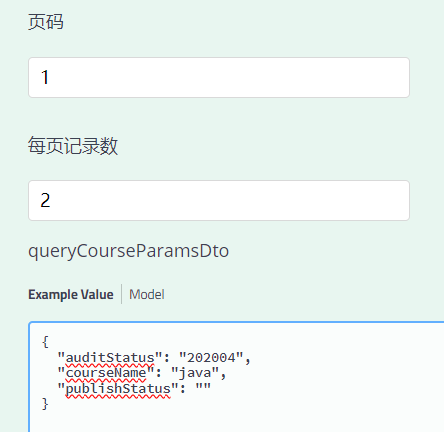
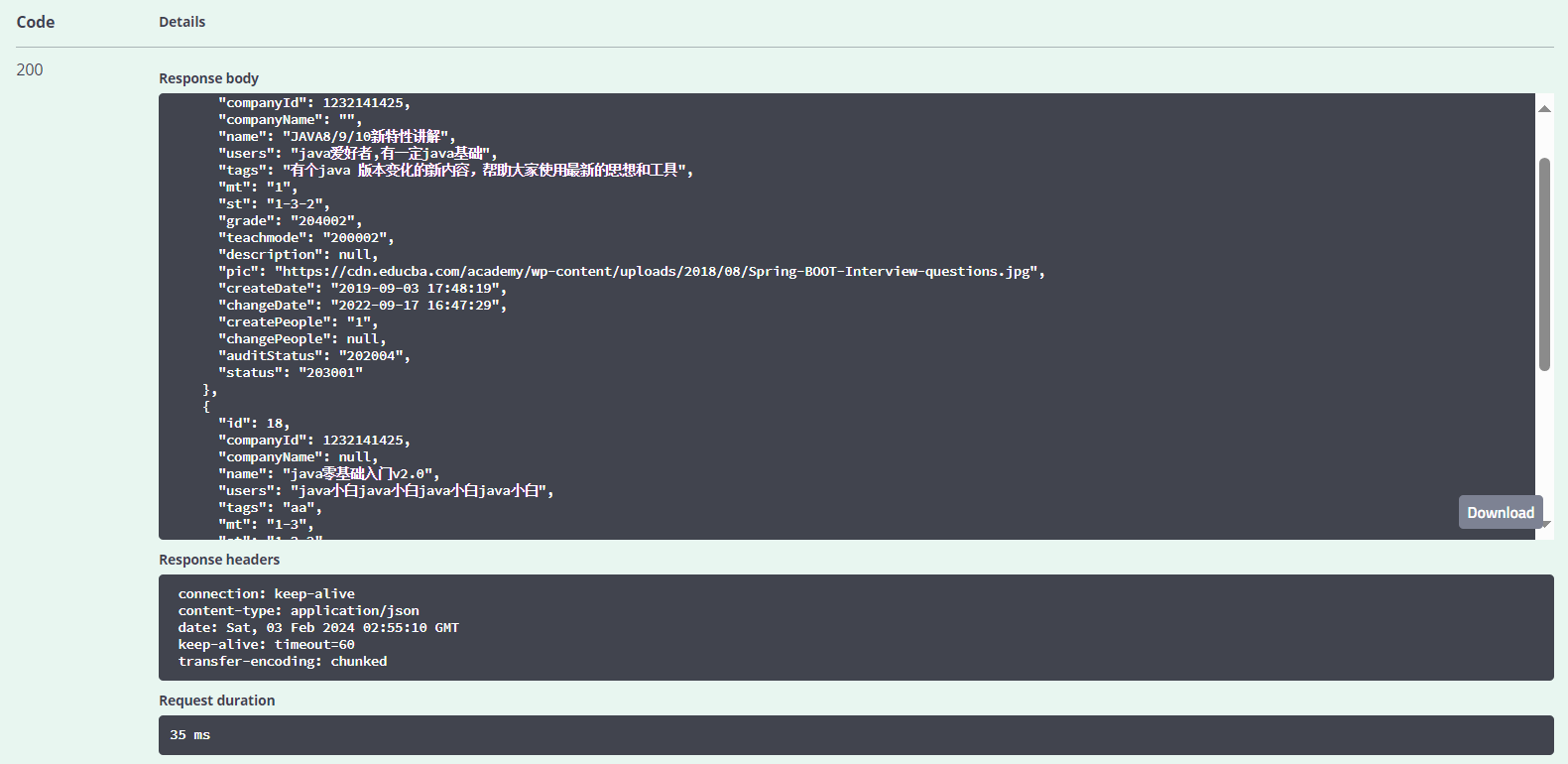
点击请求这里的地球,然后点击如下,生成一个Http的请求。
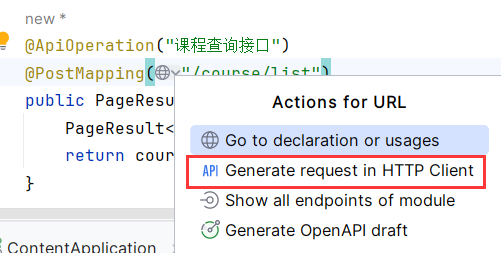
把swagger上面的参数转移到下面:
###
POST http://localhost:63040/content/course/list?pageNo=1&pageSize=2
Content-Type: application/json
{
"auditStatus": "202004",
"courseName": "java",
"publishStatus": ""
}同样可以查询出结果:
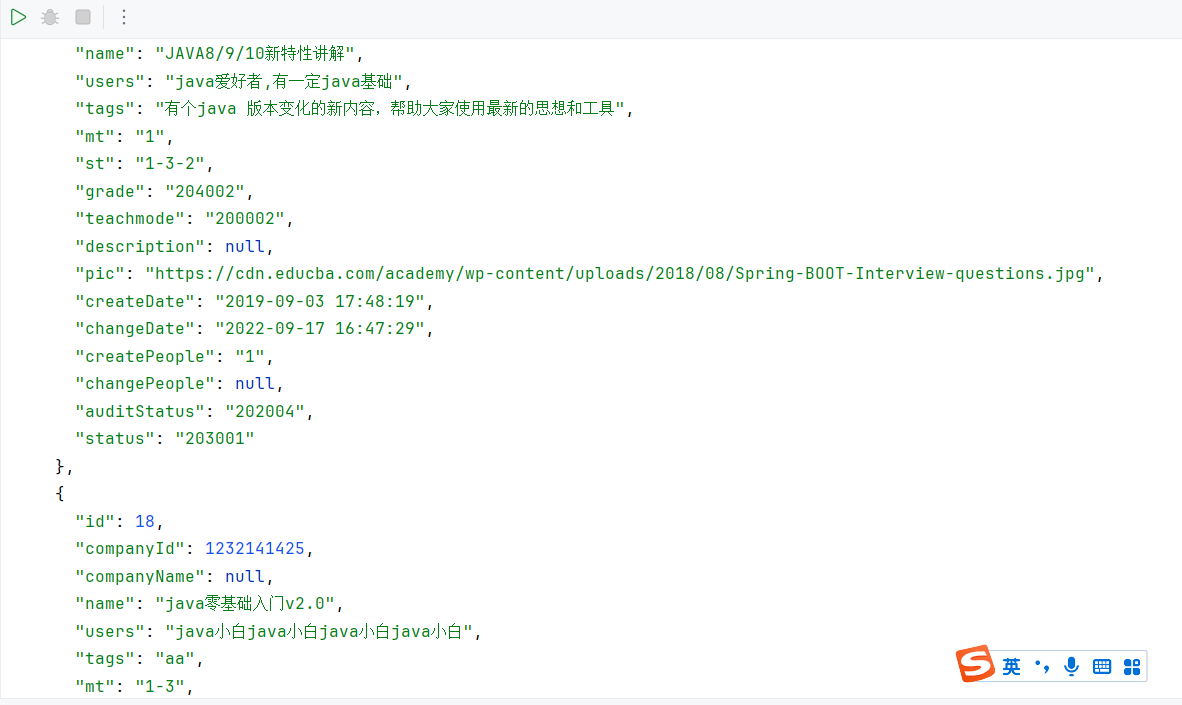
现在可以把这些查询的文件,统一放到一个包下方便管理。
在xuecheng-plus-project下面创建一个api-test包,在包下创建一个文件名为:xc-content-api.http用来存放请求测试的语句,然后再创建一个http-client.env.json文件,用来配置相应的环境变量。

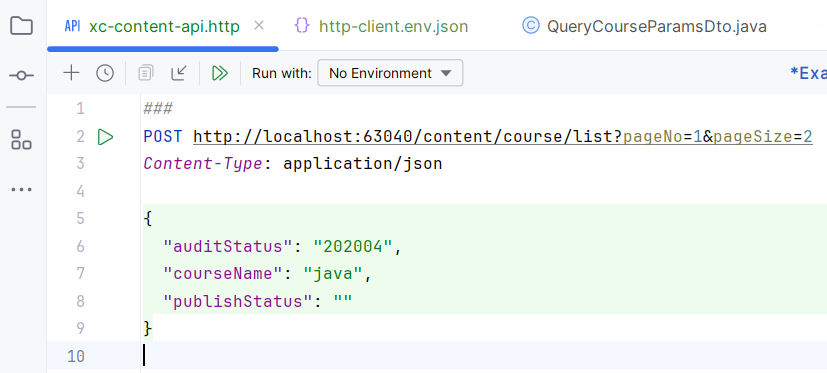
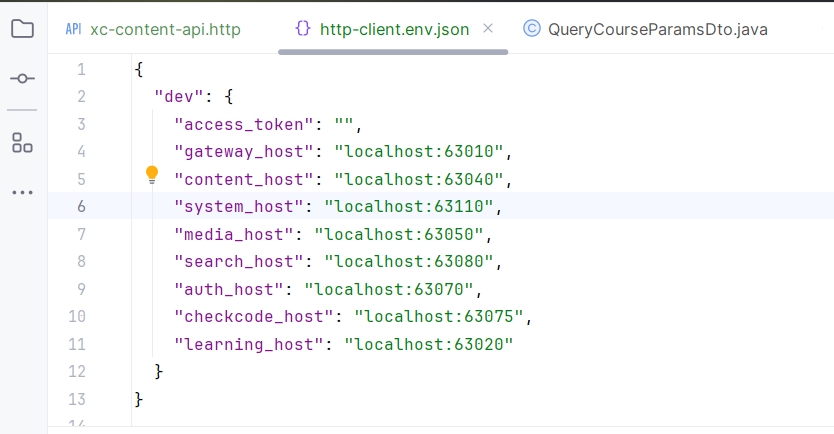
效果如下:
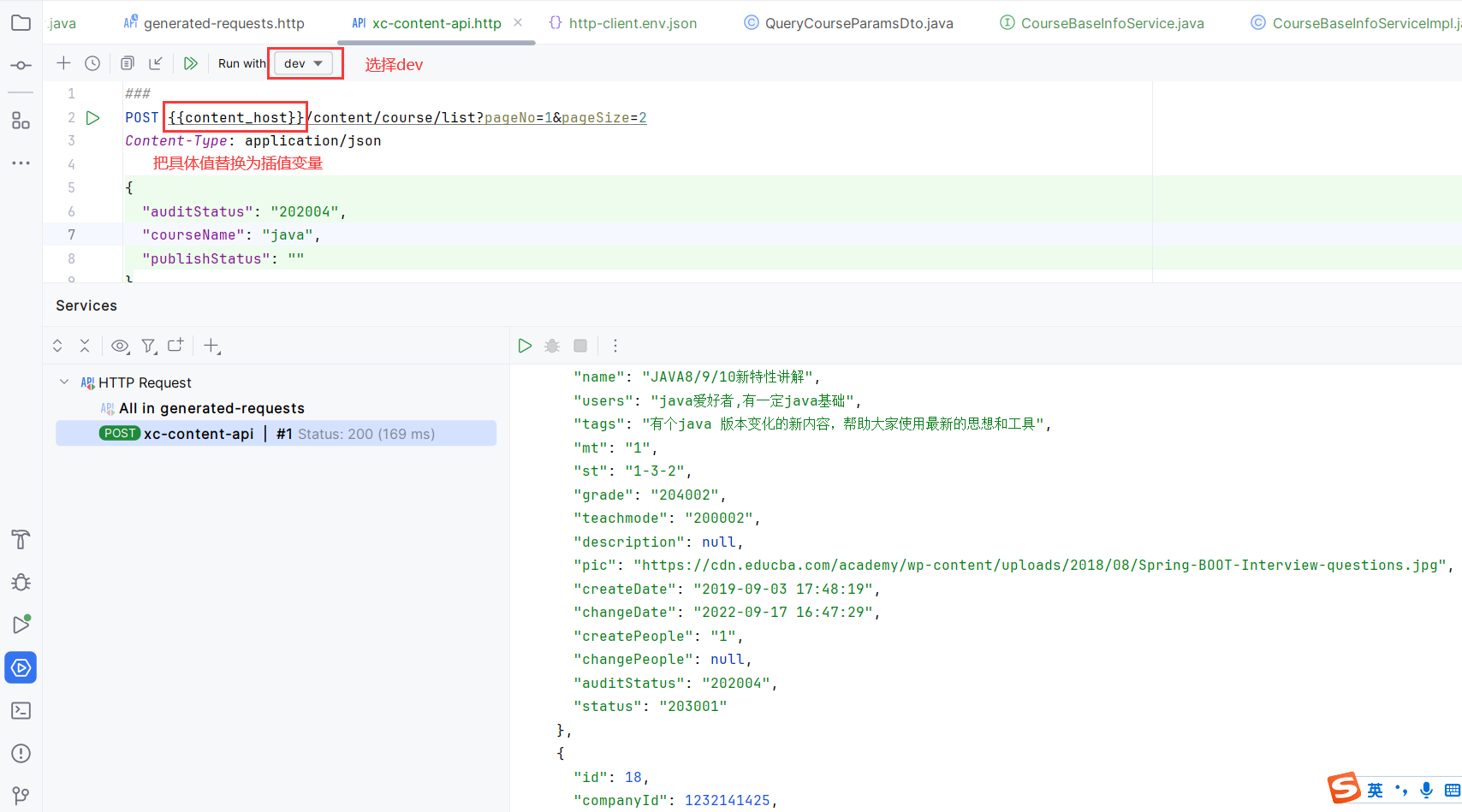
2.12 部署前端和管理服务 P27
安装完node和npm看看版本(我用的是《苍穹外卖》配置的版本,经测试可以,表明项目可以向下兼容):
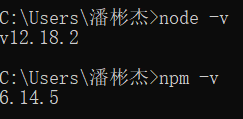
用IDEA打开project-xczx2-portal-vue-ts,右键package.json,点击show npm scripts:
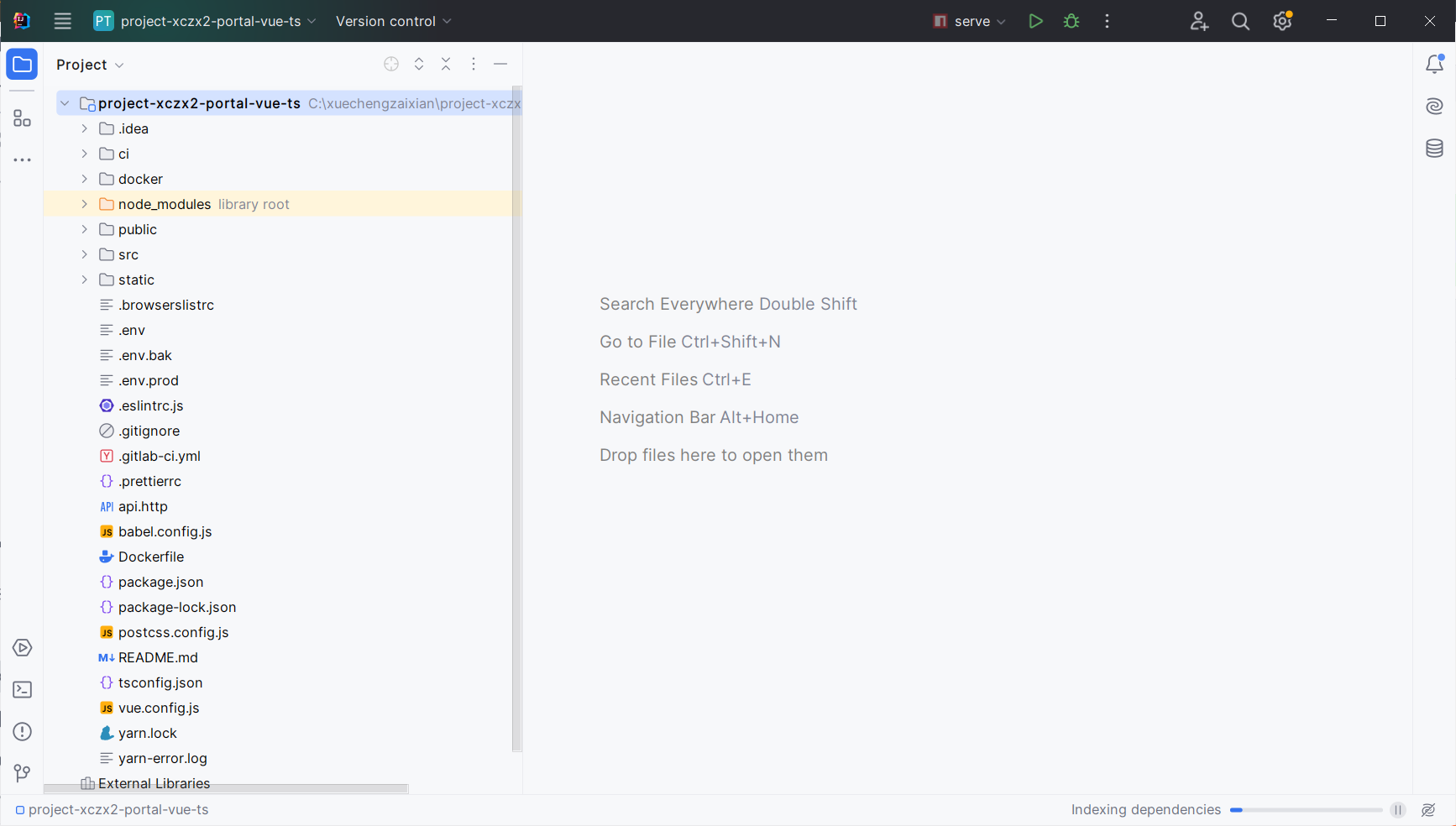
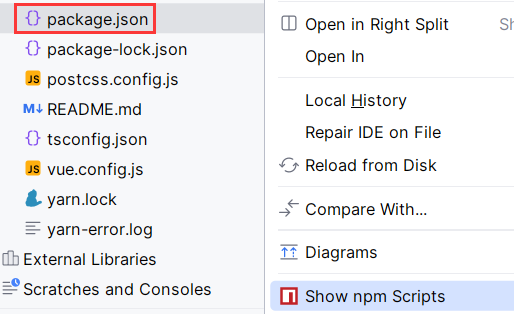
右键serve,然后点击Edit serve Settings。然后配置好Node和nmp的版本。最后Run serve:
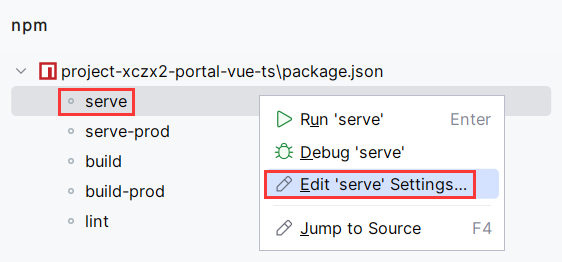
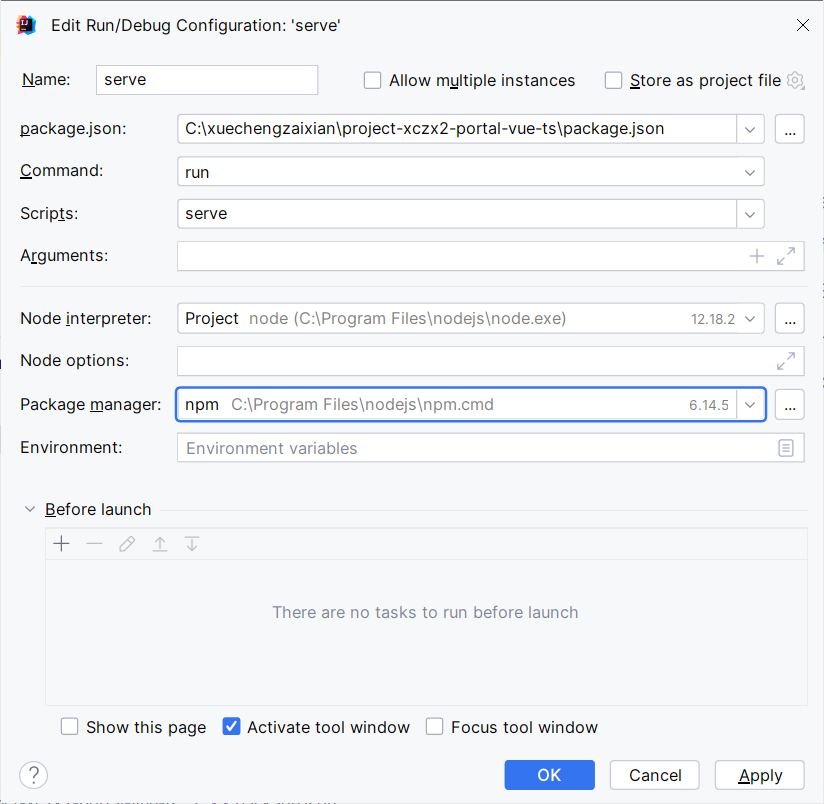
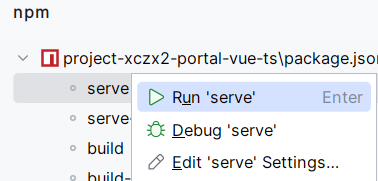 4
4
成功后点击链接访问即可:

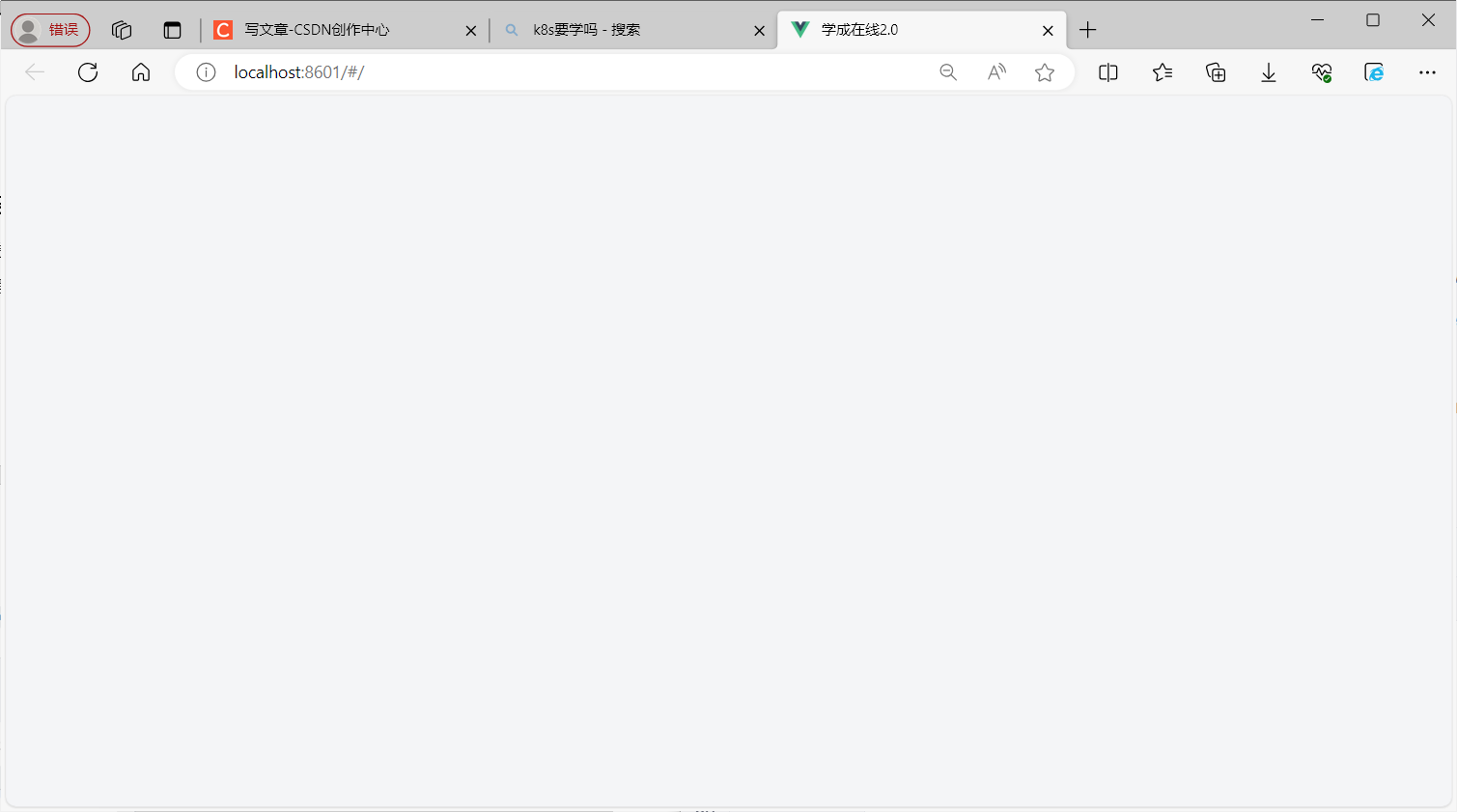
打开开发者工具,all报错,这是系统管理服务,请求的是63110端口。

打开第2天的资料,把xuecheng-plus-system放到project里,把pom.xml转化为maven工程,把api模块的配置文件中的数据库修改为我们自己的数据库。
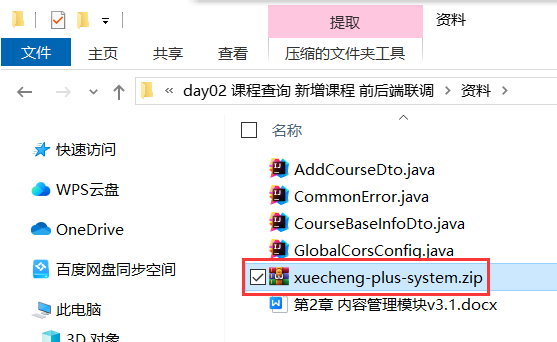
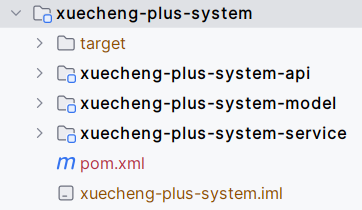
运行Api模块下的SystemApplication启动类。

出现的是跨域问题:

2.13 跨域三种方案 P28
判断是否跨域请求是基于浏览器的同源策略,同源策略是浏览器的一种安全机制,从一个地址请求另一个地址,如果协议、主机、端口三者全部一致则不属于跨域,否则有一个不一致就是跨域。
从http://localhost:8601到http://localhost:8602,因为端口不同,所以是跨域
从http://192.168.101.10:8601到http://192.168.101.11:8601,由于主机不同,是跨域
从http://192.168.101.10:8601到https://192.168.101.10:8601,由于协议不用,是跨域
方法1:JSONP
方法2:添加响应头
Access-Control-Allow-Origin: http://localhost:8601服务器收到请求判断这个Origin是否允许跨域,如果允许则在响应头中说明允许该来源的跨域请求。
Access-Control-Allow-Origin: *方法3:通过nginx代理跨域
由于服务器之间没有跨域,浏览器可以通过nginx去访问。

Nginx和浏览器之间不是跨域的(协议、服务器、端口都一样),通过Nginx代理去访问服务器。
2.14 定义cors过滤器 P29
在xuecheng-plus-system的xuecheng-plus-content-api下的config包下创建一个GlobalCorsConfig类,写入如下代码:
@Configuration
public class GlobalCorsConfig {
@Bean
public CorsFilter corsFilter() {
CorsConfiguration config = new CorsConfiguration();
//允许白名单域名进行跨域调用
config.addAllowedOrigin("*");
//允许跨越发送cookie
config.setAllowCredentials(true);
//放行全部原始头信息
config.addAllowedHeader("*");
//允许所有请求方法跨域调用
config.addAllowedMethod("*");
UrlBasedCorsConfigurationSource source = new UrlBasedCorsConfigurationSource();
source.registerCorsConfiguration("/**", config);
return new CorsFilter(source);
}
}
现在解决了跨域问题,前端页面能正常显示。
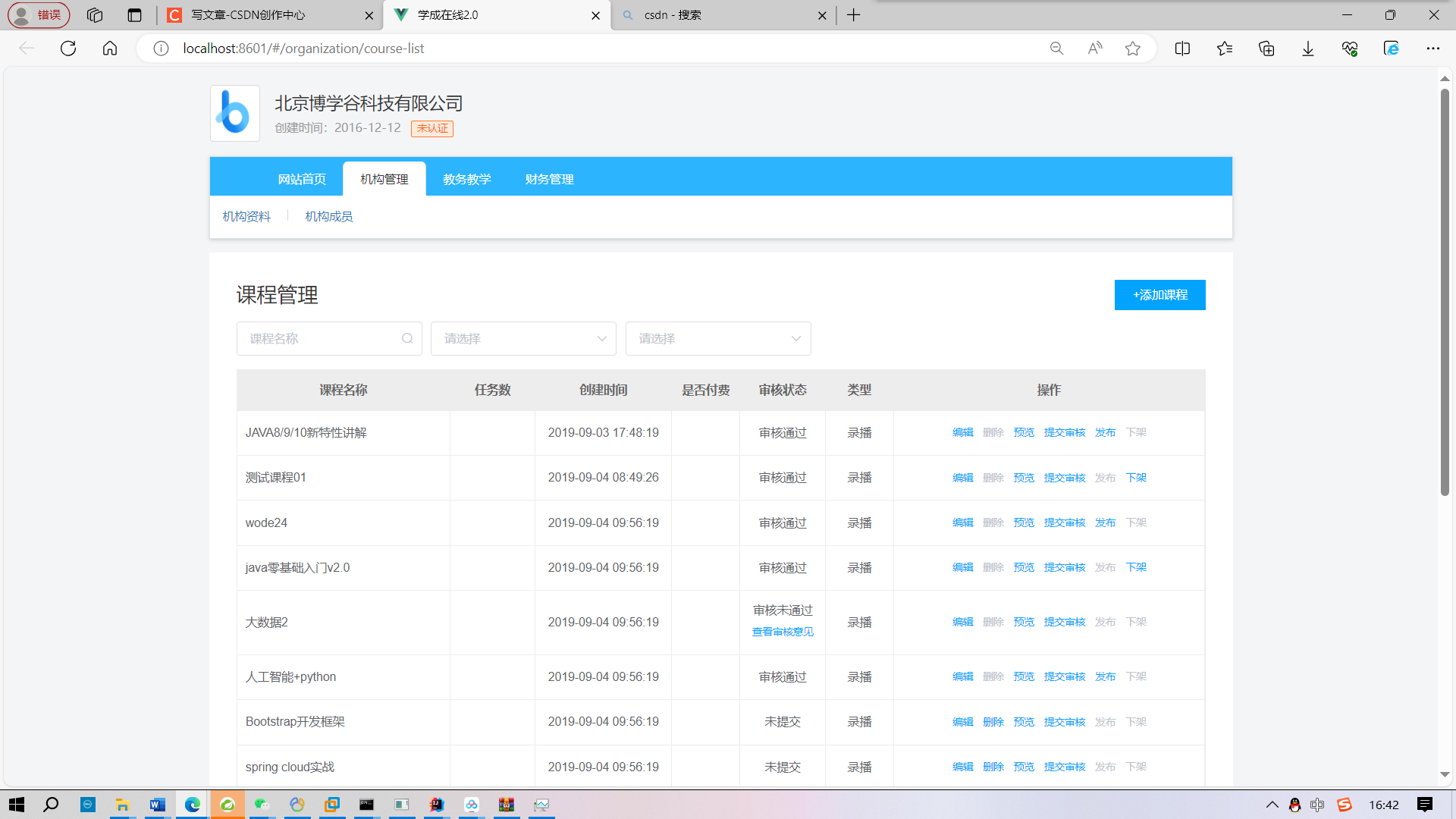
2.15 课程查询前后端联调 P30
前端.env是重要文件,修改了要重新启动项目。
当前内容管理模块打开:VUE_APP_SERVER_API_URL=http://localhost:63040
引入网关后会打开:VUE_APP_SERVER_API_URL=http://localhost:63010
前后端联调的过程。
测试:输入java,看是否出现课程。点击下拉框,看是否有文字。
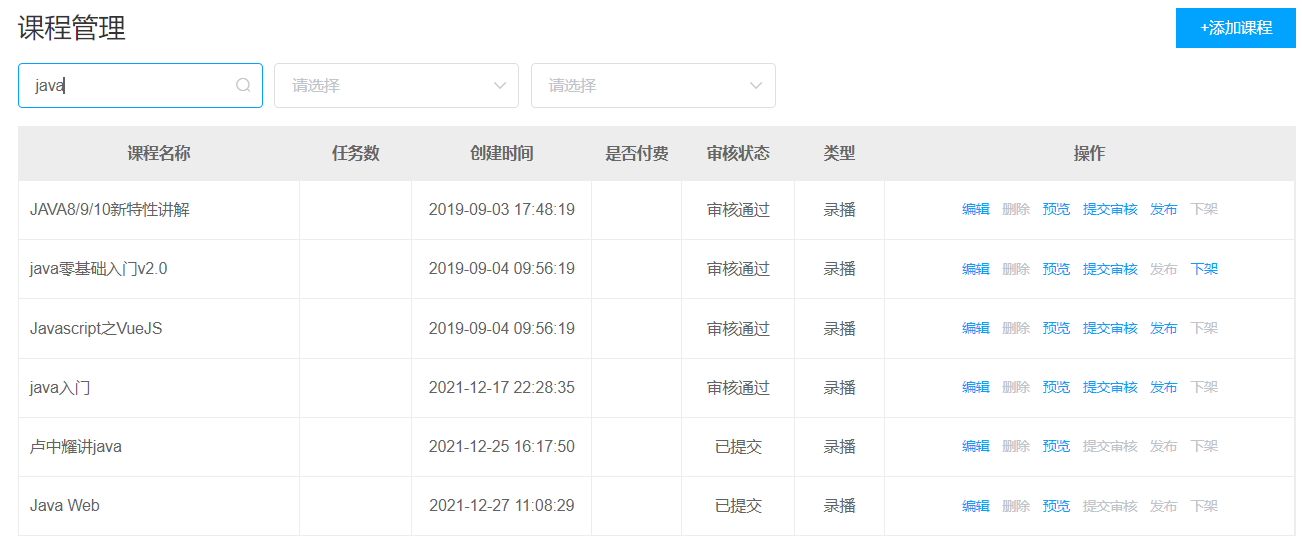

2.16 (分类查询)接口定义 P31
下表是树形结构,是三级结构。

在xuecheng-plus-content的xuecheng-plus-content-model下的dto中,定义一个新类CourseCategoryTreeDto,写入如下代码:
@Data
public class CourseCategoryTreeDto extends CourseCategory implements java.io.Serializable{
List<CourseCategoryTreeDto> childrenTreeNodes;
}在xuecheng-plus-content的xuecheng-plus-content-api/src/main/java/com/xuecheng/content/api下新增一个类CourseCategoryController,写入如下代码:
@RestController
public class CourseCategoryController {
@GetMapping("/course-category/tree-nodes")
public List<CourseCategoryTreeDto> queryTreeNodes(){
return null;
}
}
2.17 (分类查询)树型查询 P32
方法1:表的自连接。
select
one.id one_id,
one.label one_label,
two.id two_id,
two.label two_label
from course_category one
inner join course_category two
on two.parentid = one.id
where one.parentid = '1'
and one.is_show = '1'
and two.is_show = '1'
order by one.orderby,two.orderby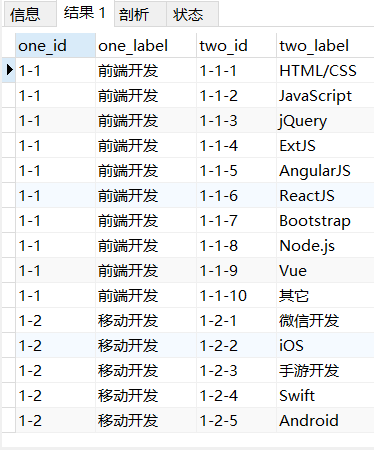
方法2:递归
向下递归,由根节点找子节点。
with recursive t1 as (
select * from course_category where id='1'
union all
select t2.* from course_category t2 inner join t1 on t1.id=t2.parentid
)
select * from t1
order by t1.id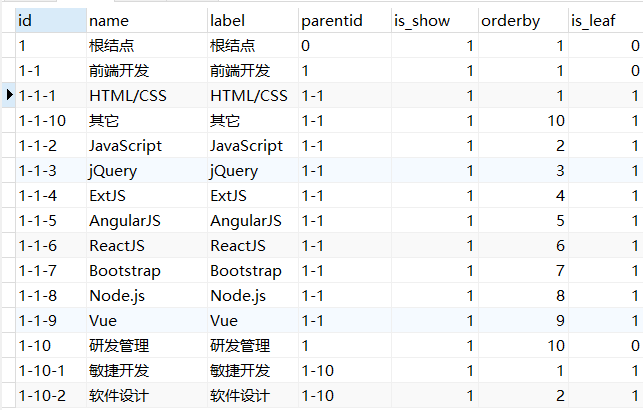
向上递归,由子节点找根节点。
with recursive t1 as (
select * from course_category where id='1-1-1'
union all
select t2.* from course_category t2 inner join t1 on t1.parentid = t2.id
)
select * from t1
order by t1.id

2.18 (分类查询)开发测试 P33
在xuecheng-plus-content的xuecheng-plus-content-service下的mapper中增加CourseCategoryMapper中的代码:
public interface CourseCategoryMapper extends BaseMapper<CourseCategory> {
//使用递归查询分类
public List<CourseCategoryTreeDto> selectTreeNodes(String id);
}在xuecheng-plus-content的xuecheng-plus-content-service下的mapper中增加CourseCategoryMapper.xml中的代码:
<select id="selectTreeNodes" parameterType="string" resultType="com.xuecheng.content.model.dto.CourseCategoryTreeDto">
with recursive t1 as (
select * from course_category where id=#{id}
union all
select t2.* from course_category t2 inner join t1 on t1.id = t2.parentid
)
select * from t1
order by t1.id
</select>在xuecheng-plus-content的xuecheng-plus-content-service的test下的java/com/xuecheng/content下,把CourseBaseMapperTests拷贝一份起名CourseCategoryMapperTests:
写入如下代码:
@SpringBootTest
public class CourseCategoryMapperTests {
@Autowired
CourseCategoryMapper courseCategoryMapper;
@Test
public void testCourseBaseMapper(){
List<CourseCategoryTreeDto> courseCategoryTreeDtos = courseCategoryMapper.selectTreeNodes("1");
System.out.println(courseCategoryTreeDtos);
}
}
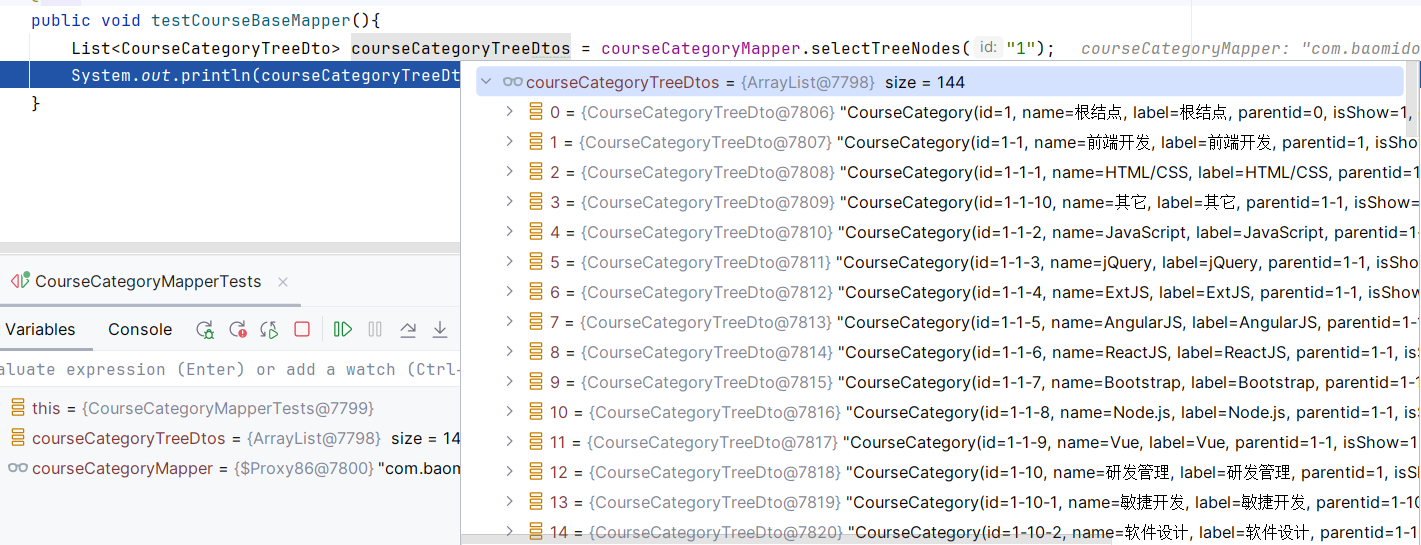
在xuecheng-plus-content的xuecheng-plus-content-service下的service下创建CourseCategoryService接口,写入如下代码:
public interface CourseCategoryService {
public List<CourseCategoryTreeDto> queryTreeNodes(String id);
}在xuecheng-plus-content的xuecheng-plus-content-service下的service下创建CourseCategoryServiceImpl类,写入如下代码:
@Slf4j
@Service
public class CourseCategoryServiceImpl implements CourseCategoryService {
@Autowired
CourseCategoryMapper courseCategoryMapper;
@Override
public List<CourseCategoryTreeDto> queryTreeNodes(String id) {
//调用mapper递归查询出分类信息
List<CourseCategoryTreeDto> courseCategoryTreeDtos = courseCategoryMapper.selectTreeNodes(id);
//找到每个节点的子节点,最终封装成List<CourseCategoryTreeDto>
//先将list转成map,key就是结点的id,value就是CourseCategoryTreeDto对象,目的是为了方便从map获取结点。filter(item->!id.equals(item.getId()))把根节点拍出
Map<String, CourseCategoryTreeDto> mapTemp = courseCategoryTreeDtos.stream().filter(item->!id.equals(item.getId())).collect(Collectors.toMap(key -> key.getId(), value -> value));
//定义一个list作为最终返回的list
List<CourseCategoryTreeDto> courseCategoryList = new ArrayList<>();
//从头遍历List<CourseCategoryTreeDto>,一边遍历一边找子节点放在父节点的childrenTreeNodes
courseCategoryTreeDtos.stream().filter(item->!id.equals(item.getId())).forEach(item->{
if(item.getParentid().equals(id)){
courseCategoryList.add(item);
}
//找到节点的父节点
CourseCategoryTreeDto courseCategoryTreeDto = mapTemp.get(item.getParentid());
if(courseCategoryTreeDto!=null) {
if (courseCategoryTreeDto.getChildrenTreeNodes() == null) {
//如果该父节点的ChildrenTreeNodes属性为空要new一个集合,因为要向该集合中放它的子节点
courseCategoryTreeDto.setChildrenTreeNodes(new ArrayList<CourseCategoryTreeDto>());
}
//到每个节点的子节点放在父节点的childrenTreeNodes属性中
courseCategoryTreeDto.getChildrenTreeNodes().add(item);
}
});
return courseCategoryList;
}
}在xuecheng-plus-content的xuecheng-plus-content-service下的test下创建CourseCategoryServiceTests测试类,写入如下代码:
@SpringBootTest
public class CourseCategoryServiceTests {
@Autowired
CourseCategoryService courseCategoryService;
@Test
public void testCourseBaseInfoService(){
List<CourseCategoryTreeDto> courseCategoryTreeDtos = courseCategoryService.queryTreeNodes("1");
System.out.println(courseCategoryTreeDtos);
}
}单元测试的效果如下:
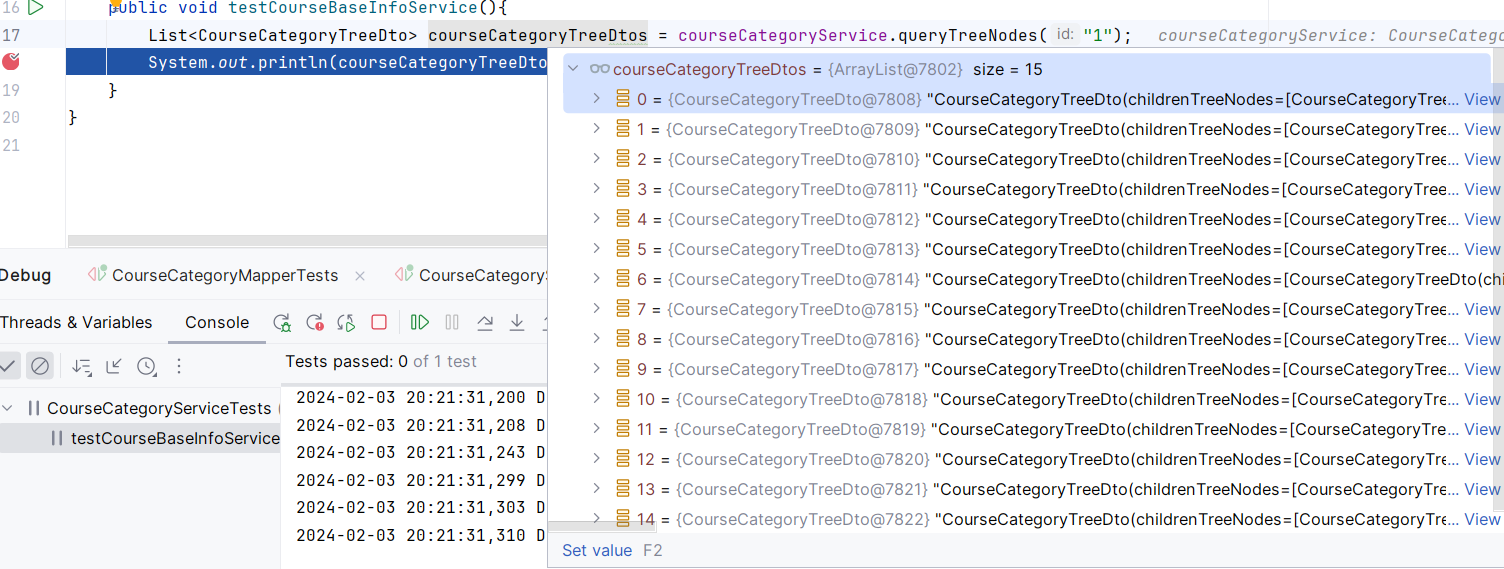
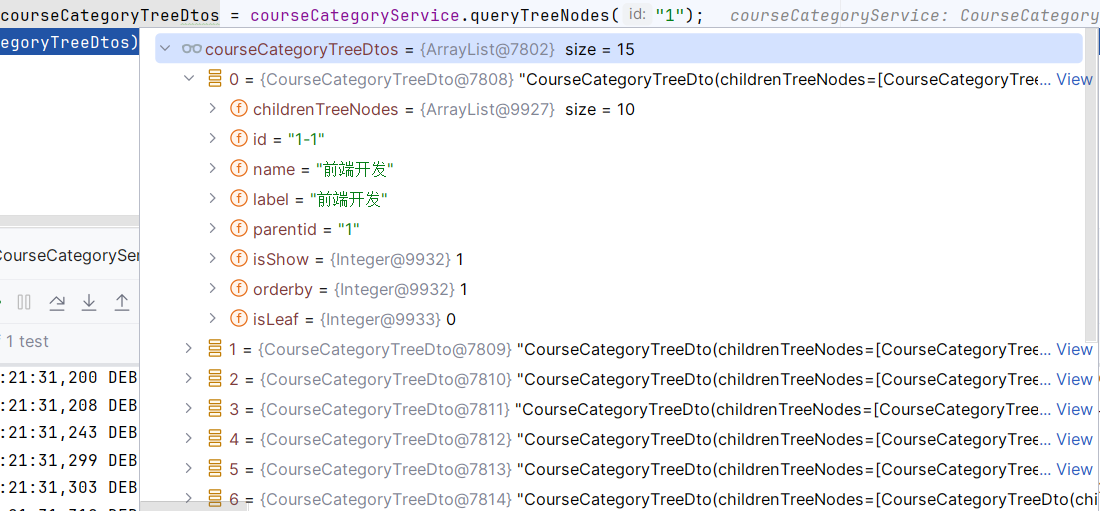
在xuecheng-plus-content-api的CourseCategoryController下完善代码如下:
@RestController
public class CourseCategoryController {
@Autowired
CourseCategoryService courseCategoryService;
@GetMapping("/course-category/tree-nodes")
public List<CourseCategoryTreeDto> queryTreeNodes(){
return courseCategoryService.queryTreeNodes("1");
}
}先把xuecheng-plus-content的xuecheng-plus-content-api下的ContentApplication启动。
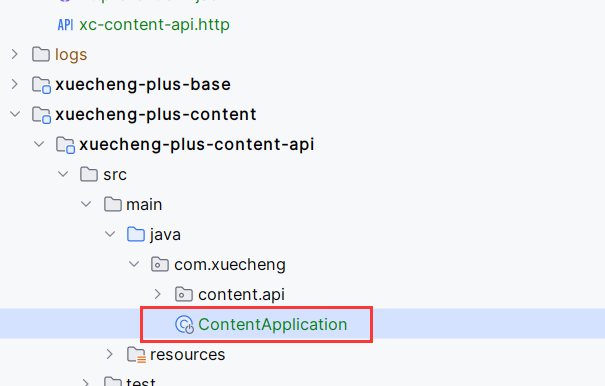
然后在api-test包下的xc-content-api.http中添加如下代码:
### 查询课程分类
GET {{content_host}}/content/course-category/tree-nodes可以看到正常输出结果:
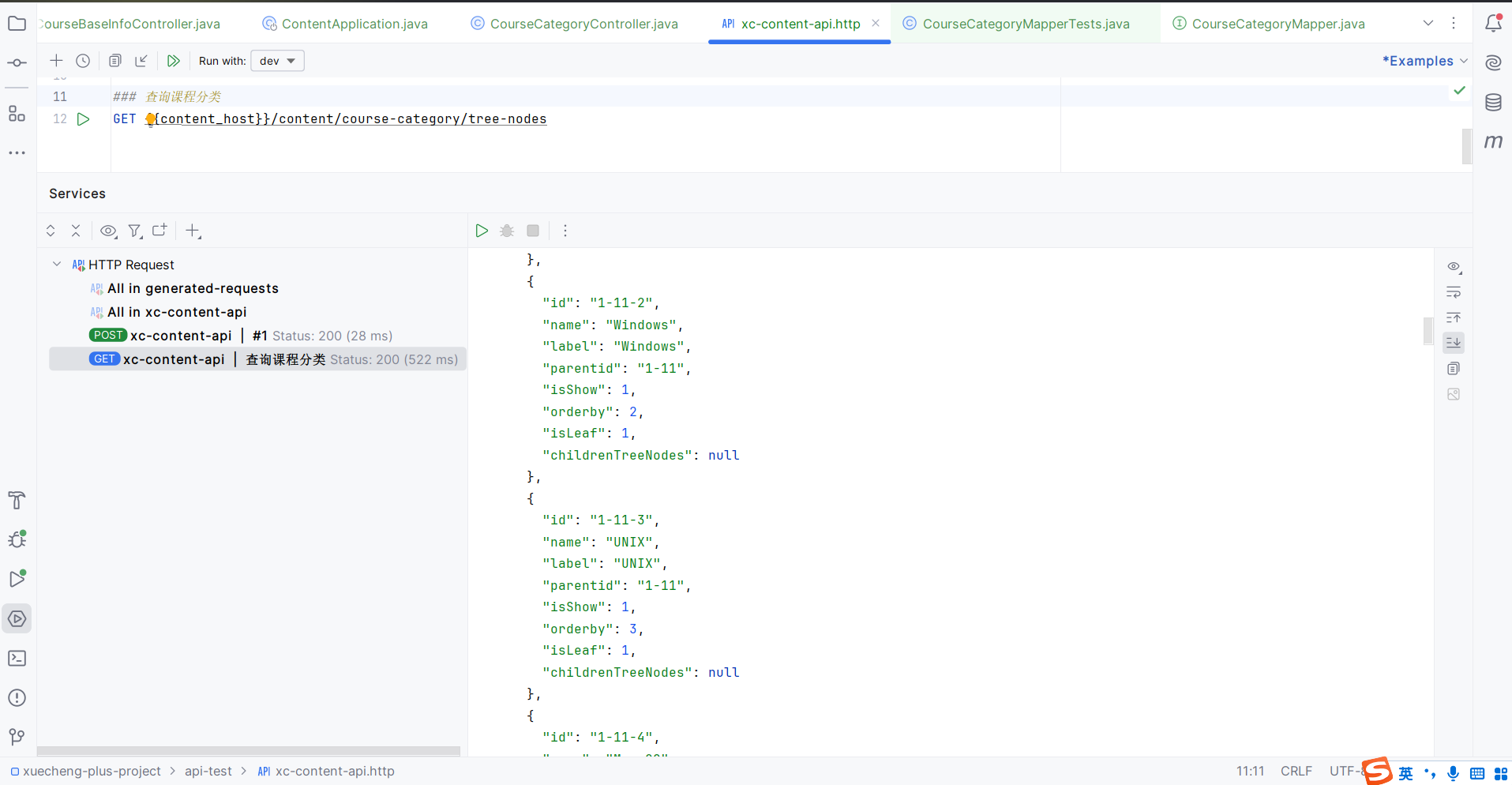
在前后端联调的时候可以看到课程分类有了结果:
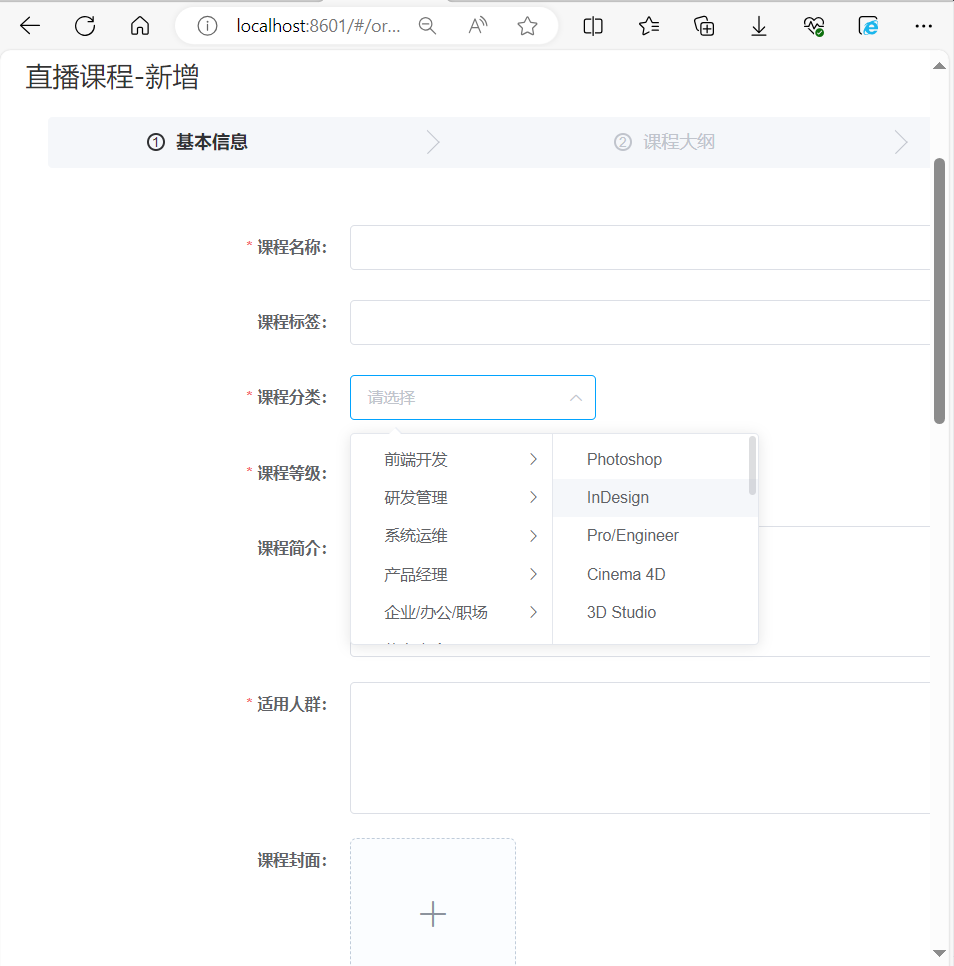
2.19 (新增课程)接口定义 P34
2.20 (新增课程)接口开发 P35
把下面2个Dto类复制到xuecheng-plus-content的xuecheng-plus-content-api的dto下面:
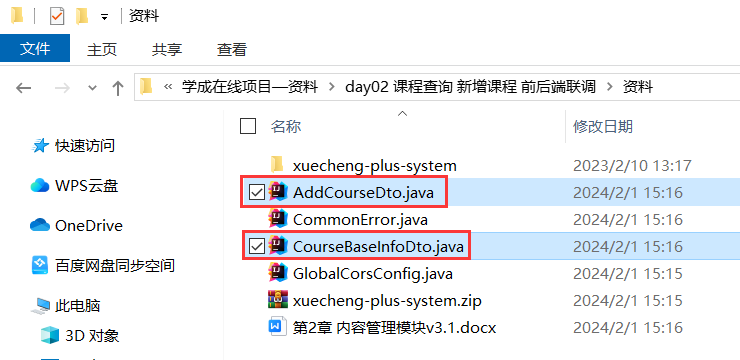
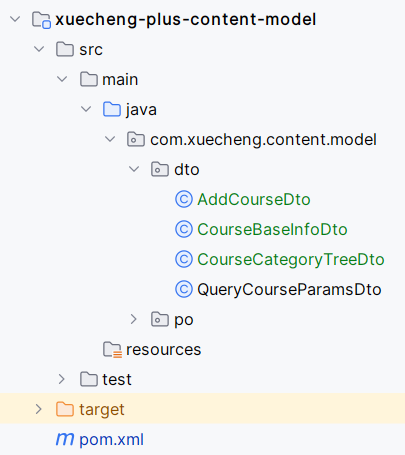
在xuecheng-plus-content的xuecheng-plus-content-api下的CourseBaseInfoController中写入如下代码:
@ApiOperation("新增课程")
@PostMapping("/content/course")
public CourseBaseInfoDto createCourseBase(@RequestBody AddCourseDto addCourseDto){
return null;
}在xuecheng-plus-content的xuecheng-plus-content-service的service下的CourseBaseInfoService中添加接口:
public CourseBaseInfoDto createCourseBase(Long companyId,AddCourseDto addCourseDto);在xuecheng-plus-content的xuecheng-plus-content-service的service/impl下的CourseBaseInfoServiceImpl中添加代码:
@Autowired
private CourseMarketMapper courseMarketMapper;
@Autowired
private CourseCategoryMapper courseCategoryMapper;
@Transactional
@Override
public CourseBaseInfoDto createCourseBase(Long companyId, AddCourseDto dto) {
//参数的合法性校验
if (StringUtils.isBlank(dto.getName())) {
throw new RuntimeException("课程名称为空");
}
if (StringUtils.isBlank(dto.getMt())) {
throw new RuntimeException("课程分类为空");
}
if (StringUtils.isBlank(dto.getSt())) {
throw new RuntimeException("课程分类为空");
}
if (StringUtils.isBlank(dto.getGrade())) {
throw new RuntimeException("课程等级为空");
}
if (StringUtils.isBlank(dto.getTeachmode())) {
throw new RuntimeException("教育模式为空");
}
if (StringUtils.isBlank(dto.getUsers())) {
throw new RuntimeException("适应人群为空");
}
if (StringUtils.isBlank(dto.getCharge())) {
throw new RuntimeException("收费规则为空");
}
//向课程基本信息表course_base写入数据
CourseBase courseBaseNew = new CourseBase();
//将传入的页面的参数放到courseBase对象中
BeanUtils.copyProperties(dto,courseBaseNew); //只要属性名相同就可以拷贝
courseBaseNew.setCompanyId(companyId);
courseBaseNew.setCreateDate(LocalDateTime.now());
//审核状态默认为未提交
courseBaseNew.setAuditStatus("202002");
//发布状态为未发布
courseBaseNew.setStatus("203001");
//插入数据库
int insert = courseBaseMapper.insert(courseBaseNew);
if(insert<=0){
throw new RuntimeException("添加课程失败");
}
//向课程营销表course_market写入数据
CourseMarket courseMarketNew = new CourseMarket();
//将页面输入的数据拷贝到courseMarketNew
BeanUtils.copyProperties(dto,courseMarketNew);
//课程的id
Long courseId = courseBaseNew.getId();
courseMarketNew.setId(courseId);
//保存营销信息
saveCourseMarket(courseMarketNew);
//从数据库查询课程的详细信息,包括两部分
CourseBaseInfoDto courseBaseInfo = getCourseBaseInfo(courseId);
return courseBaseInfo;
}
//查询课程信息
public CourseBaseInfoDto getCourseBaseInfo(long courseId){
//从课程基本信息表查询
CourseBase courseBase = courseBaseMapper.selectById(courseId);
if(courseBase==null){
return null;
}
//从课程营销表查询
CourseMarket courseMarket = courseMarketMapper.selectById(courseId);
//组装在一起
CourseBaseInfoDto courseBaseInfoDto = new CourseBaseInfoDto();
BeanUtils.copyProperties(courseBase,courseBaseInfoDto);
BeanUtils.copyProperties(courseMarket,courseBaseInfoDto);
//通过courseCategoryMapper查询分类信息,将分类名称放在courseBaseInfoDto对象
return courseBaseInfoDto;
}
//单独写一个方法保存营销信息,逻辑:存在则更新,不存在则添加
private int saveCourseMarket(CourseMarket courseMarketNew){
//参数的合法性校验
String charge = courseMarketNew.getCharge();
if(StringUtils.isEmpty(charge)){
throw new RuntimeException("收费规则为空");
}
//如果课程收费,价格没有填写也需要抛出异常
if(charge.equals("201001")){
if(courseMarketNew.getPrice()==null || courseMarketNew.getPrice().floatValue()<=0){
throw new RuntimeException("课程的价格不能为空并且必须大于0");
}
}
//从数据库查询营销信息,存在则更新,不存在则添加
Long id = courseMarketNew.getId();
CourseMarket courseMarket = courseMarketMapper.selectById(id);
if(courseMarket==null){
//插入数据库
int insert = courseMarketMapper.insert(courseMarketNew);
return insert;
}else{
//将courseMarketNew拷贝到courseMarket
BeanUtils.copyProperties(courseMarketNew,courseMarket);
courseMarket.setId(courseMarket.getId());
//更新
int i = courseMarketMapper.updateById(courseMarket);
return i;
}
}
2.21 (新增课程)接口测试 P36
首先是完善controller的接口。在xuecheng-plus-content的xuecheng-plus-content-api下的CourseBaseInfoController中完善createCourseBase方法:
@ApiOperation("新增课程")
@PostMapping("/course")
public CourseBaseInfoDto createCourseBase(@RequestBody AddCourseDto addCourseDto){
//获取到用户所述机构的id
Long companyId = 1232141425L;
CourseBaseInfoDto courseBase = courseBaseInfoService.createCourseBase(companyId, addCourseDto);
return courseBase;
}然后节约时间跳过单元测试,直接倒api-test下的xc-content-api.http中进行接口测试:
### 新增课程
POST {{content_host}}/content/course
Content-Type: application/json
{
"charge": "201001",
"description": "adsd",
"grade": "204001",
"mt": "1-1",
"name": "java网络编程高级",
"originalPrice": 100,
"phone": "13333333",
"pic": "fdsf",
"price": 10,
"qq": "22333",
"st": "1-1-1",
"tags": "sdsdwe",
"teachmode": "20002",
"users": "初级人员",
"validDays": 365,
"wechat": "223344"
}在controller和service的实现类上打上断点,主要是看看断点调试时接受的数据是否完整。
放行之后数据效果如下:
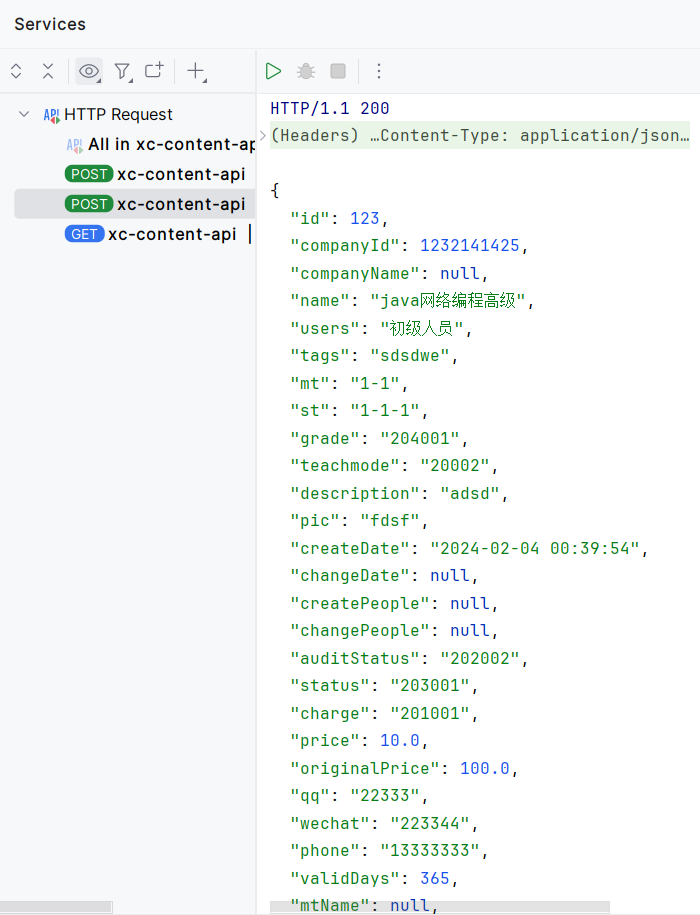
前端可以直接看到之前新增的课程:
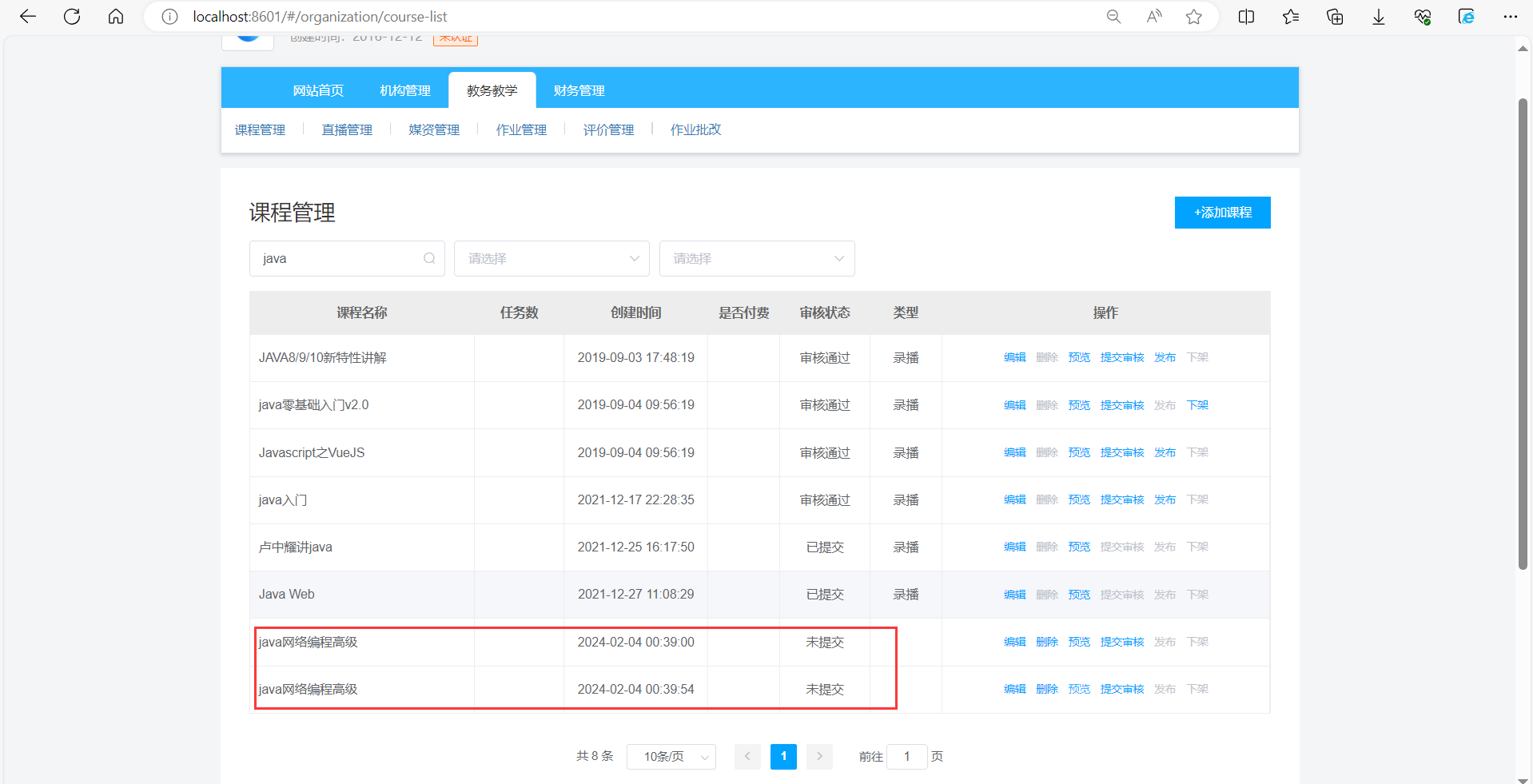
数据库中也有如下数据,没问题:
![]()
前端还暂时无法提交。
2.22 Mybatis相关问题 P37
1.Mybatis分页插件的实现原理:
首先分页参数会被放到ThreadLocal中,拦截执行的sql语句,根据数据库的类型(比如是Mysql就会在末尾添加LIMIT)添加对应的分页语句重写sql。
计算出total总记录数,pageNum当前是第几页,pageSize每页的大小。是否为首页,是否为尾页,总页数等。
2.树型表的标记字段是什么?如何查询MySQL树型表?
树型表的标记字段是parentid即父结点的id。
3.查询一个树型表的方法:
当层级固定时可以用表的自连接进行查询。
如果想灵活查询每个层级可以使用mysql递归方法,使用with RECURSIVE实现。
4.Result Type和Result Map的区别:
Result Type:当查询到的SQL字段的名字和Result Type中模型类型的属性名字对应上的,可以由MyBatis自动完成映射。
Result Map:当查询到的SQL字段的名字和Result Type中模型类型的属性名字对应不上时,需要通过Result Map手动完成映射。
5. #{}和${}的区别
#{}是标记一个占位符,可以防止sql注入。
${}用于在动态sql中拼接字符串,可能导致sql注入。
2.23 自定义异常类型 P38
如果前端名称为空,会报错500。但仅在控制台输出,前端没展示。
如果写很多try-catch代码,会造成代码冗余。
由增强类来捕获异常,原理是AOP面向切面编程。
用@ControllerAdvice注解来控制器增强,用异常处理注解@ExceptionHandler。
在xuecheng-plus-base的base包下创建exception包。
在exception包下创建RestErrorResponse类,和前端约定返回的异常信息模型:
/**
* 错误响应参数包装
*/
public class RestErrorResponse implements Serializable {
private String errMessage;
public RestErrorResponse(String errMessage){
this.errMessage= errMessage;
}
public String getErrMessage() {
return errMessage;
}
public void setErrMessage(String errMessage) {
this.errMessage = errMessage;
}
}
在exception包下创建XueChengPlusException类:
/**
* @description 学成在线项目异常类
* @author Mr.M
* @date 2022/9/6 11:29
* @version 1.0
*/
public class XueChengPlusException extends RuntimeException {
private String errMessage;
public XueChengPlusException() {
super();
}
public XueChengPlusException(String errMessage) {
super(errMessage);
this.errMessage = errMessage;
}
public String getErrMessage() {
return errMessage;
}
public static void cast(CommonError commonError){
throw new XueChengPlusException(commonError.getErrMessage());
}
public static void cast(String errMessage){
throw new XueChengPlusException(errMessage);
}
}
在exception包下创建CommonError类:
/**
* @description 通用错误信息
* @author Mr.M
* @date 2022/9/6 11:29
* @version 1.0
*/
public enum CommonError {
UNKOWN_ERROR("执行过程异常,请重试。"),
PARAMS_ERROR("非法参数"),
OBJECT_NULL("对象为空"),
QUERY_NULL("查询结果为空"),
REQUEST_NULL("请求参数为空");
private String errMessage;
public String getErrMessage() {
return errMessage;
}
private CommonError( String errMessage) {
this.errMessage = errMessage;
}
}
2.24 异常处理开发测试 P39
现在想测试课程名称为空是否会触发XueChengPlusException异常处理。
首先在service模块的service包的impl包下的CourseBaseInfoServiceImpl类中修改下面的代码:
//参数的合法性校验
if (StringUtils.isBlank(dto.getName())) {
//throw new RuntimeException("课程名称为空");
XueChengPlusException.cast("课程名称为空");
}在xuecheng-plus-base的exception下的GlobalExceptionHandler类下的如下位置打上断点:

最后在api-test包下的xc-content-api.http下面,让name参数为空。

在如下位置添加自定义的异常处理语句。

把现价改为负数,会触发异常。
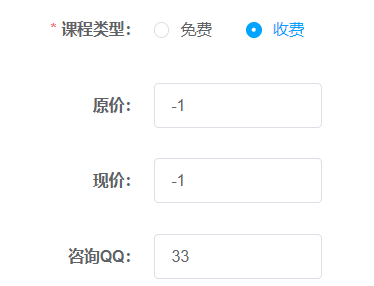

2.25 系统异常处理 P40
处理自定义异常:程序在编写代码时根据校验结果主动抛出自定义异常类对象,抛出异常时指定详细的异常信息,异常处理器捕获异常信息记录异常日志并相应给客户。
2.26 JSR303校验 P41
JSR303是一个校验框架。
使用方式:只需要在模型类中通过注解指定校验规则(比如@NOTEmpty来指定不能为空,@Size来指定长度的下限和上限),对不同的应用场景可以通过分组来切换校验规则使用groups,在controller方法上开启校验@Validated。
前端请求后端接口传输参数,在controller和service中都需要校验。
controller校验请求参数的合法性,包括必填项校验、数据格式校验(是否符合一定的日期格式)。
service校验业务规则的相关内容。
因为service是根据业务规则去校验所以不方便写成通用代码,controller中则可以将校验的代码写成通用代码。
引入如下依赖:
![]()
合法性校验的注解如下:
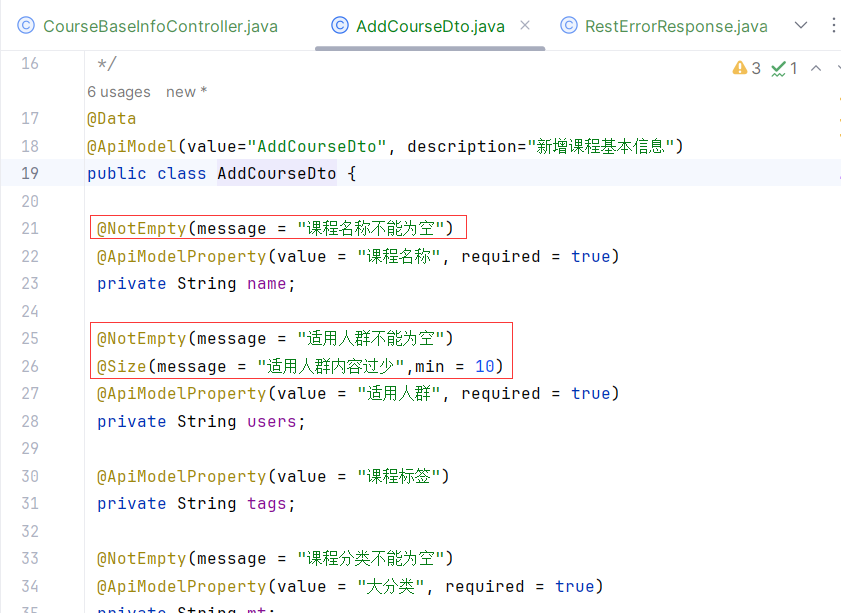
如果想要使用需要激活:

首先要把service层校验屏蔽掉(我是直接删掉):
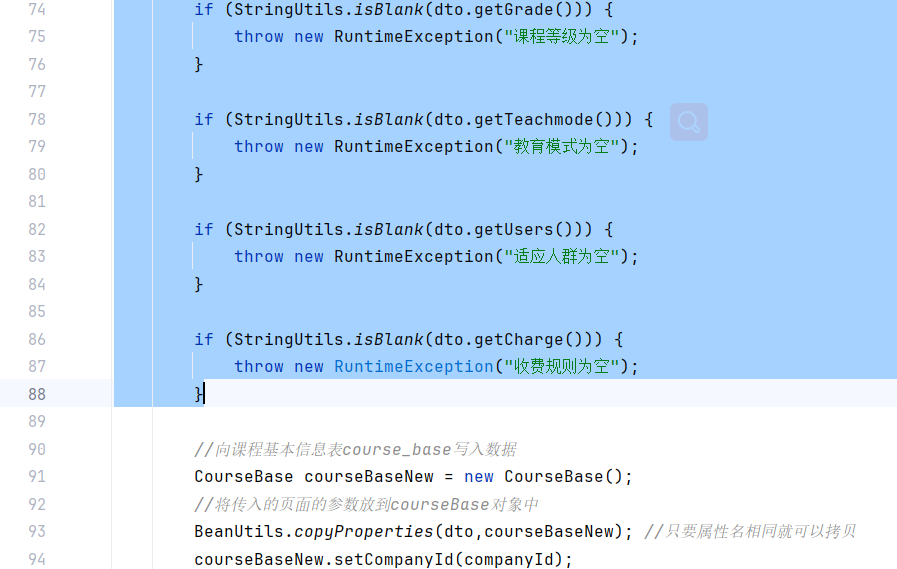
然后记得要把启动类重启一下,代码才能生效。
在xc-content-api.http中把name改为空,走的是系统异常处理,所以一律输出为位置错误,执行过程异常,请重试。
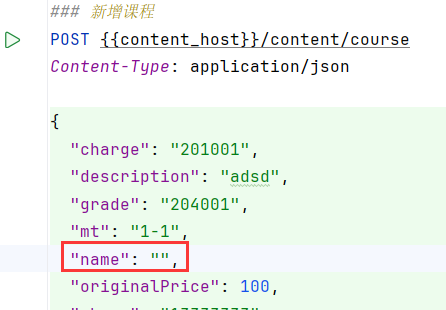

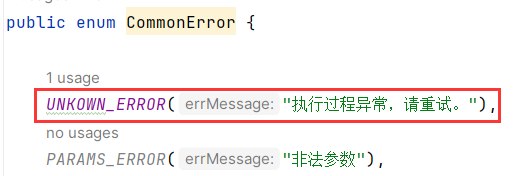
现在出现问题,如果多个接口使用同一个模型类时,对校验的需求不一样时会出现问题。
解决方法:分组校验。
在xuecheng-plus-base的exception下面的ValidationGroups类中写入如下代码:
//用于分组校验,定义一些常用的组
public class ValidationGroups {
public interface Insert{};
public interface Update{};
public interface Delete{};
}在xuecheng-plus-content的xuecheng-plus-content-model的dto下面的类AddCourseDto替换如下代码:
@NotEmpty(message = "新增课程名称不能为空",groups={ValidationGroups.Insert.class})
@NotEmpty(message = "修改课程名称不能为空",groups={ValidationGroups.Update.class})
@ApiModelProperty(value = "课程名称", required = true)
private String name;@Validated注解里面写上所分的组类:

2.27 系统参数合法性校验 P42
提问:对表单的数据是怎么校验的?
回答:JSR303校验规则。
如果javax.validation.constraints包下的校验规则满足不了需求怎么办?
1.手写校验代码
2.自定义校验规则注解
2.28 (修改课程)接口开发 P44
在xuecheng-plus-content的xuecheng-plus-content-api的api包下的CourseBaseInfoController中,写入如下代码:
@ApiOperation("根据课程id查询接口")
@GetMapping("/course/{courseId}")
public CourseBaseInfoDto getCourseBaseById(@PathVariable Long courseId){
CourseBaseInfoDto courseBaseInfo = courseBaseInfoService.getCourseBaseInfo(courseId);
return courseBaseInfo;
}在xuecheng-plus-content的xuecheng-plus-content-service的service包下的CourseBaseInfoService中写入如下代码:
//根据课程id查询课程信息
public CourseBaseInfoDto getCourseBaseInfo(Long courseId);在xuecheng-plus-content的xuecheng-plus-content-service的service/impl包下的CourseBaseInfoServiceImpl中写入如下代码:
//查询课程信息
public CourseBaseInfoDto getCourseBaseInfo(Long courseId){
//从课程基本信息表查询
CourseBase courseBase = courseBaseMapper.selectById(courseId);
if(courseBase==null){
return null;
}
//从课程营销表查询
CourseMarket courseMarket = courseMarketMapper.selectById(courseId);
//组装在一起
CourseBaseInfoDto courseBaseInfoDto = new CourseBaseInfoDto();
BeanUtils.copyProperties(courseBase,courseBaseInfoDto);
BeanUtils.copyProperties(courseMarket,courseBaseInfoDto);
//通过courseCategoryMapper查询分类信息,将分类名称放在courseBaseInfoDto对象
return courseBaseInfoDto;
}在api-test的xc-content-api.http中写入如下代码:
### 课程查询
GET {{content_host}}/content/course/40
Content-Type: application/json返回的结果如下:
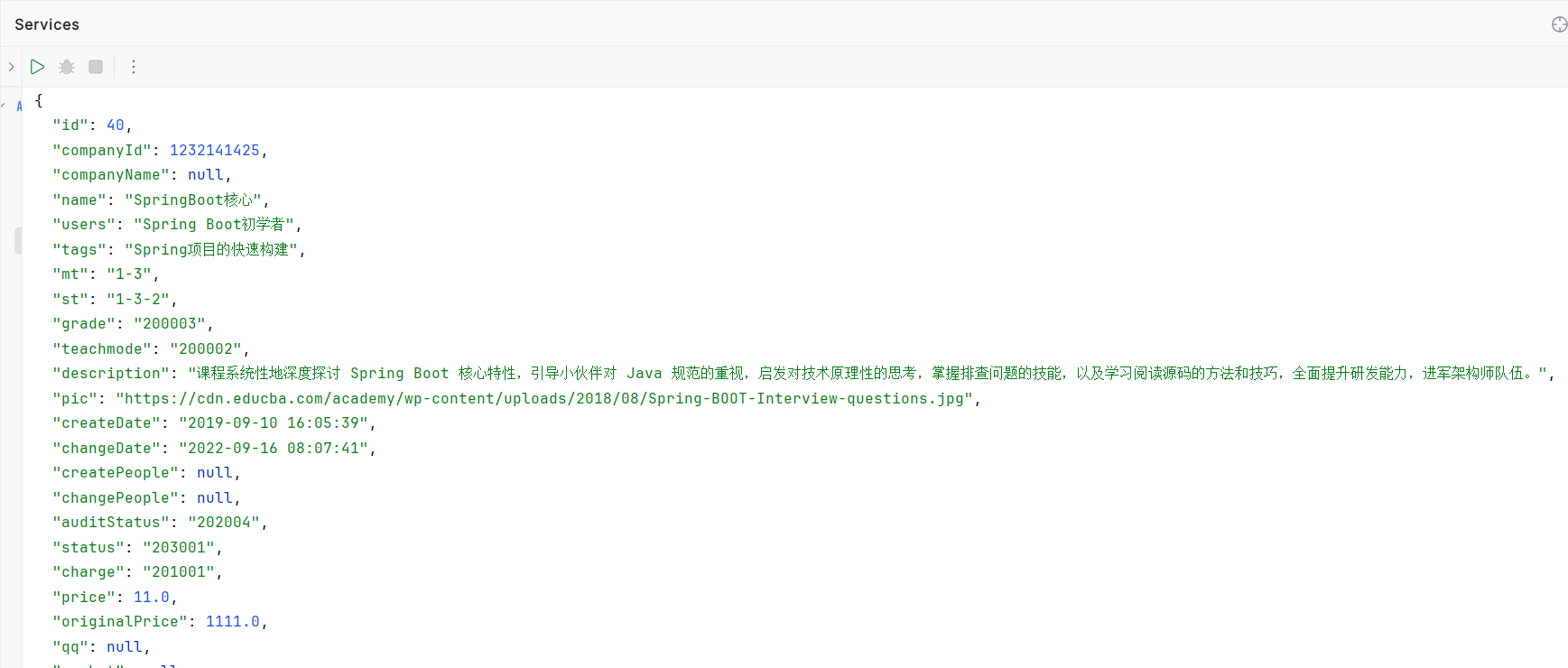
在xuecheng-plus-content的xuecheng-plus-content-model下面的dto包下面,重新定义一个类EditCourseDto,代码如下:
因为修改比新增就多了一个id,可以继承新增。
@Data
@ApiModel(value="EditCourseDto",description="修改课程基本信息")
public class EditCourseDto extends AddCourseDto{
@ApiModelProperty(value="课程id",required=true)
private Long Id;
}在xuecheng-plus-content的xuecheng-plus-content-api的api包下的CourseBaseInfoController中,写入如下代码:
@ApiOperation("修改课程")
@PutMapping("/course")
public CourseBaseInfoDto modifyCourseBase(@RequestBody @Validated EditCourseDto editCourseDto){
//获取到用户所属机构的id
Long companyId = 1232141425L;
CourseBaseInfoDto courseBaseInfoDto = courseBaseInfoService.updateCourseBase(companyId, editCourseDto);
return courseBaseInfoDto;
}在xuecheng-plus-content的xuecheng-plus-content-service的service包下的CourseBaseInfoService中写入如下代码:
public CourseBaseInfoDto updateCourseBase(Long companyId,EditCourseDto editCourseDto);在xuecheng-plus-content的xuecheng-plus-content-service的service/impl包下的CourseBaseInfoServiceImpl中写入如下代码(缺少更新营销信息):
@Override
public CourseBaseInfoDto updateCourseBase(Long companyId, EditCourseDto editCourseDto) {
//拿到课程id
Long courseId = editCourseDto.getId();
//查询课程信息
CourseBase courseBase = courseBaseMapper.selectById(courseId);
if(courseBase == null){
XueChengPlusException.cast("课程不存在");
}
//数据合法性校验
//根据具体的业务逻辑去校验
//本机构只能修改本机构的课程
if(!companyId.equals(courseBase.getCompanyId())){
XueChengPlusException.cast("本机构只能膝盖本机构的课程");
}
//封装数据
BeanUtils.copyProperties(editCourseDto,courseBase);
//修改时间
courseBase.setChangeDate(LocalDateTime.now());
//更新数据库
int i = courseBaseMapper.updateById(courseBase);
if(i<=0){
XueChengPlusException.cast("修改课程失败");
}
//查询课程信息
CourseBaseInfoDto courseBaseInfo = getCourseBaseInfo(courseId);
return courseBaseInfo;
}在api-test的xc-content-api.http中写入如下代码:
### 课程查询
GET {{content_host}}/content/course/40
Content-Type: application/json2.29 (修改课程)接口测试 P45
输入下面的网址,打开前端界面:
http://localhost:8601/#/点击编辑按钮,尝试修改基本信息

修改完毕之后,原先的信息会被更改。
返回的结果如下(属于正常,跳转到另外一个还没写的界面):
![]()
2.30 (计划查询)接口定义 P46
在xuecheng-plus-content的xuecheng-plus-content-model下面的dto包下面,定义一个新类TeachplanDto,代码如下:
@Data
@ToString
public class TeachplanDto extends Teachplan {
//课程计划关联的媒资信息
private TeachplanMedia teachplanMedia;
//子结点
private List<TeachplanDto> teachPlanTreeNodes;
}在xuecheng-plus-content的xuecheng-plus-content-api的api包下的TeachplanController中,写入如下代码(初步):
//课程计划管理相关的接口
@Api(value="课程计划编辑接口",tags="课程计划编辑接口")
@RestController
public class TeachplanController {
@ApiOperation("查询课程计划树形结构")
@GetMapping("/teachplan/{courseId}/tree-nodes")
public List<TeachplanDto> getTreeNodes(@PathVariable Long courseId){
return null;
}
}2.31 (计划查询)sql语句 P47
在xuecheng-plus-content的xuecheng-plus-content-service的mapper下的TeachplanMapper中写入如下代码:
public interface TeachplanMapper extends BaseMapper<Teachplan> {
//课程计划查询
public List<TeachplanDto> selectTreeNodes(Long courseId);
}在xuecheng-plus-content的xuecheng-plus-content-service的mapper下的TeachplanMapper.xml中写入如下代码:
<select id="selectTreeNodes" parameterType="long" resultMap="treeNodeResultMap">
select
one.id one_id,
one.pname one_pname,
one.parentid one_parentid,
one.grade one_grade,
one.media_type one_mediaType,
one.start_time one_stratTime,
one.end_time one_endTime,
one.orderby one_orderby,
one.course_id one_courseId,
one.course_pub_id one_coursePubId,
two.id two_id,
two.pname two_pname,
two.parentid two_parentid,
two.grade two_grade,
two.media_type two_mediaType,
two.start_time two_stratTime,
two.end_time two_endTime,
two.orderby two_orderby,
two.course_id two_courseId,
two.course_pub_id two_coursePubId,
m1.media_fileName mediaFilename,
m1.id teachplanMeidaId,
m1.media_id mediaId
from teachplan one
INNER JOIN teachplan two on one.id = two.parentid
LEFT JOIN teachplan_media m1 on m1.teachplan_id = two.id
where one.parentid = 0 and one.course_id=#{value}
order by one.orderby,two.orderby
</select>2.32 (计划查询)接口开发 P48
在xuecheng-plus-content的xuecheng-plus-content-service的java的mapper下的TeachplanMapper下写入如下代码:
public interface TeachplanMapper extends BaseMapper<Teachplan> {
//课程计划查询
public List<TeachplanDto> selectTreeNodes(Long courseId);
}在xuecheng-plus-content的xuecheng-plus-content-service的java的mapper下的TeachplanMapper.xml下写入如下代码:
column是从数据库查到的字段,property是目标类的属性,也就是将从数据库查到的字段(column)映射到目标类的属性(property)上。
除了id字段用id标签,其它都用result标签。
<resultMap id="treeNodeResultMap" type="com.xuecheng.content.model.dto.TeachplanDto">
<id column="one_id" property="id"/>
<result column="one_pname" property="pname"/>
<result column="one_pname" property="pname" />
<result column="one_parentid" property="parentid" />
<result column="one_grade" property="grade" />
<result column="one_mediaType" property="mediaType" />
<result column="one_stratTime" property="stratTime" />
<result column="one_endTime" property="endTime" />
<result column="one_orderby" property="orderby" />
<result column="one_courseId" property="courseId" />
<result column="one_coursePubId" property="coursePubId" />
<!--映射子节点,一对多映射,ofType填的是list中对象类型-->
<collection property="teachPlanTreeNodes" ofType="com.xuecheng.content.model.dto.TeachplanDto">
<!-- 二级数据映射 -->
<id column="two_id" property="id" />
<result column="two_pname" property="pname" />
<result column="two_parentid" property="parentid" />
<result column="two_grade" property="grade" />
<result column="two_mediaType" property="mediaType" />
<result column="two_stratTime" property="stratTime" />
<result column="two_endTime" property="endTime" />
<result column="two_orderby" property="orderby" />
<result column="two_courseId" property="courseId" />
<result column="two_coursePubId" property="coursePubId" />
<!--一对一映射-->
<association property="teachplanMedia" javaType="com.xuecheng.content.model.po.TeachplanMedia">
<result column="teachplanMeidaId" property="id" />
<result column="mediaFilename" property="mediaFilename" />
<result column="mediaId" property="mediaId" />
<result column="two_id" property="teachplanId" />
<result column="two_courseId" property="courseId" />
<result column="two_coursePubId" property="coursePubId" />
</association>
</collection>
</resultMap>在xuecheng-plus-content的xuecheng-plus-content-service的test的content下创建一个TeachplanMapperTests类,写入如下代码:
@SpringBootTest
public class TeachplanMapperTests {
@Autowired
TeachplanMapper teachplanMapper;
@Test
public void testSelectTreeNodes(){
List<TeachplanDto> teachplanDtos = teachplanMapper.selectTreeNodes(117L);
System.out.println(teachplanDtos);
}
}当测试数据为117L的时候,会有2个大章节。


在xuecheng-plus-content的xuecheng-plus-content-service的service包下的TeachplanService
中写入如下代码:
//课程计划管理相关接口
public interface TeachplanService {
//根据课程id查询课程计划
public List<TeachplanDto> findTeachplanTree(Long courseId);
}在xuecheng-plus-content的xuecheng-plus-content-service的service/impl包下的TeachplanService
中写入如下代码:
@Service
public class TeachplanServiceImpl implements TeachplanService {
@Autowired
TeachplanMapper teachplanMapper;
@Override
public List<TeachplanDto> findTeachplanTree(Long courseId) {
List<TeachplanDto> teachplanTree = teachplanMapper.selectTreeNodes(courseId);
return teachplanTree;
}
}在xuecheng-plus-content的xuecheng-plus-content-api的api包下的TeachplanController中,写入如下代码(完善):
//课程计划管理相关的接口
@Api(value="课程计划编辑接口",tags="课程计划编辑接口")
@RestController
public class TeachplanController {
@Autowired
private TeachplanService teachplanService;
@ApiOperation("查询课程计划树形结构")
@GetMapping("/teachplan/{courseId}/tree-nodes")
public List<TeachplanDto> getTreeNodes(@PathVariable Long courseId){
List<TeachplanDto> teachplanTree = teachplanService.findTeachplanTree(courseId);
return teachplanTree;
}
}在api-test的xc-content-api.http中写入如下代码:
### 课程计划查询
GET {{content_host}}/content/teachplan/117/tree-nodes控制台输出的效果如下,测试成功(前后端联调测试没问题):

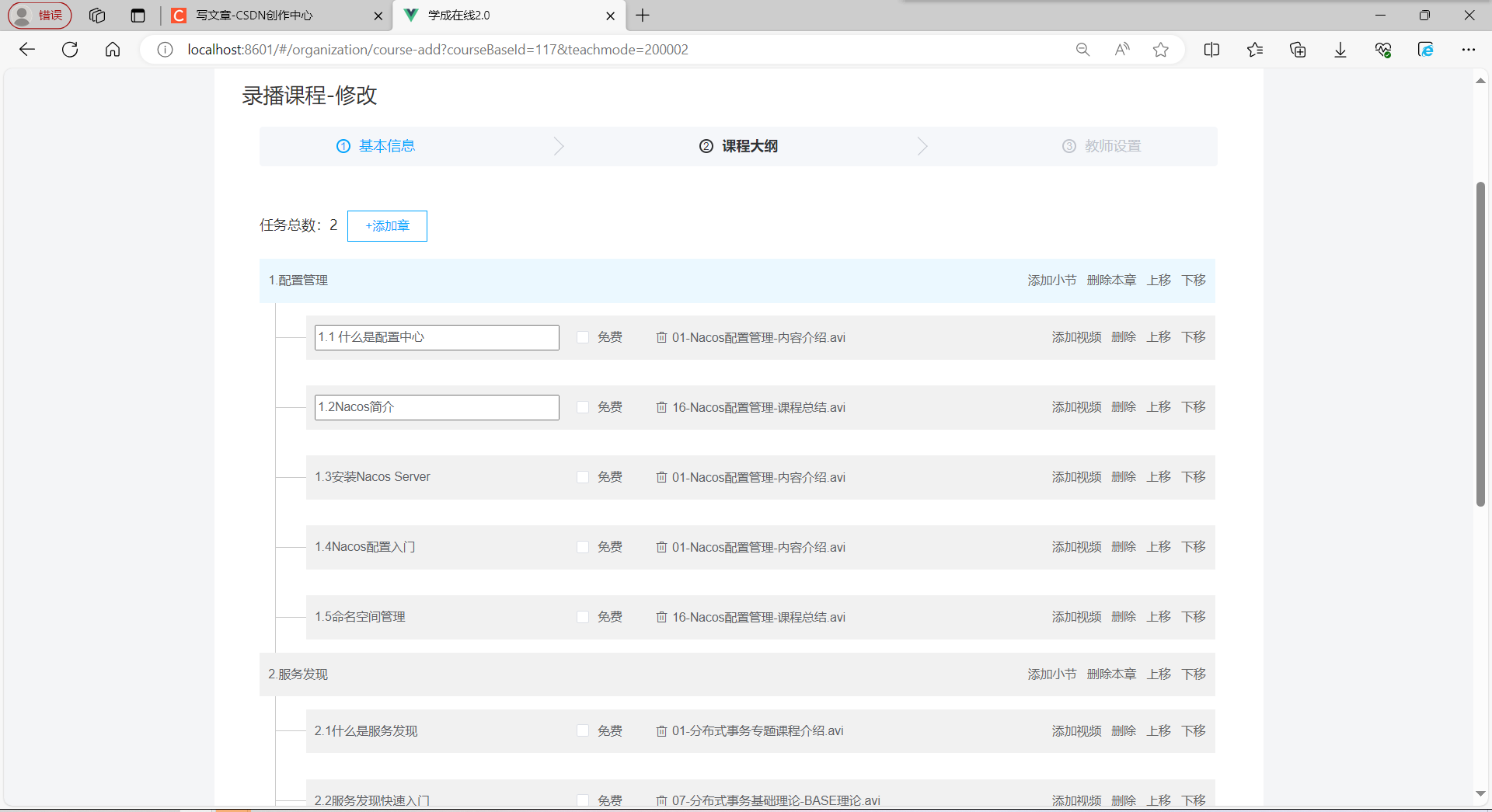
2.33 (新增修改计划)接口定义 P49
点击“添加章”新增第一级课程计划。
点击“添加小节”向某个第一级课程计划下添加小节。
点击“章”、“节”的名称,可以修改名称、选择是否免费。
同一个接口接收新增和修改两个业务请求,以是否传递课程计划id 来判断是新增还是修改(传递了课程计划id说明当前是要修改该课程计划,否则是新增一个课程计划)。
在xuecheng-plus-content的xuecheng-plus-content-model下的dto中新增一个类,写入如下代码:
@Data
@ToString
public class SaveTeachplanDto {
private Long id;
private String pname;
private Long parentid;
private Integer grade;
private String mediaType;
private Long courseId;
private Long coursePubId;
private String isPreview;
}
在xuecheng-plus-conten的xuecheng-plus-content-api下的content/api下的TeachplanController中写入如下代码:
@ApiOperation("课程计划创建或修改")
@PostMapping("/teachplan")
public void saveTeachplan(@RequestBody SaveTeachplanDto teachplan){
}

